Zagreb to Dubrovnik: the Ultimate 10-day Road Trip Itinerary
21 February 2022 - It’s never the wrong time to start planning the perfect getaway to the paradise that is Croatia. We decided to give you a hand in planning the perfect 10-day road trip from Zagreb to Dubrovnik (plus some bonus island time!) that showcases the best the country has to offer.
The best way to discover Croatia is by car, giving you the freedom to go off the beaten path and chart your own adventure around the country, all the way from Zagreb to Dubrovnik.
Before we jump into it, do be aware that most car rentals in Croatia are manual transmissions! Automatic cars are available for rent, though mostly by larger rental companies like Sixt, and are more expensive.
If you’re not a confident driver, no need to worry, there are plenty of private bus companies that run daily trips to most cities and tourist attractions during the high season (June - September). In larger cities such as Zagreb and Split, bus schedules are also available online. Transfers between major ports and the islands are also regularly serviced by ferries and catamarans.
Day 1: Zagreb
Welcome to Zagreb, the capital and largest city of Croatia! Nicknamed the city of museums, Zagreb is home to over a dozen award-winning museums such as the Archeological Museum, with over 450,000 artifacts and monuments.
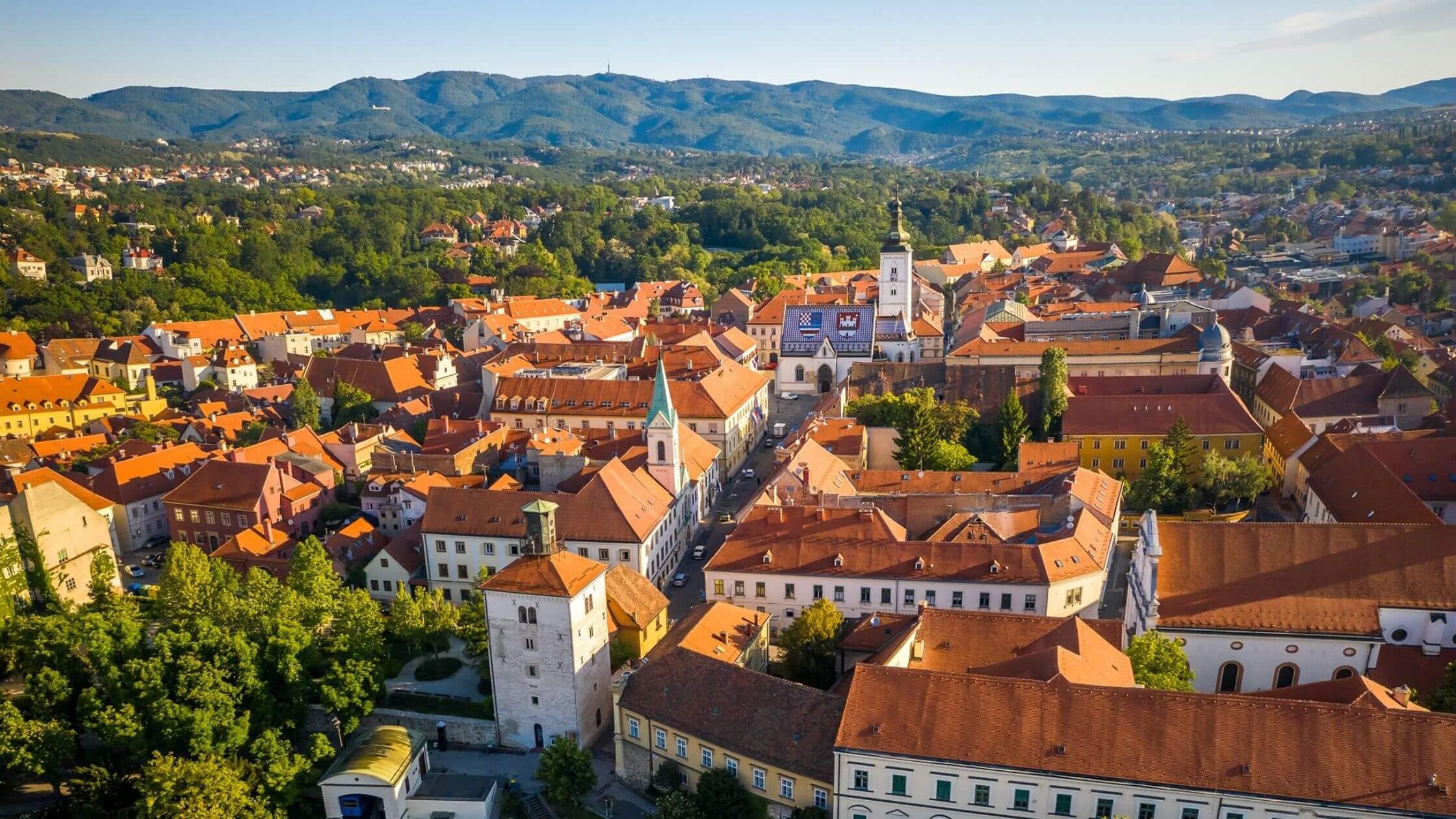
The gorgeous buildings of Upper Town in Zagreb. Visit Zagreb/Facebook.
Cultural landmarks of the city include Ban Jelačić Square which has existed since the 17th century, the Zagreb Cathedral, or the magnificent Croatian National Theater whose unveiling ceremony was attended by Austro-Hungarian Emperor Franz Joseph I. So, make sure you squeeze in some time for a walking tour to absorb the sights of Zagreb’s Old Town.
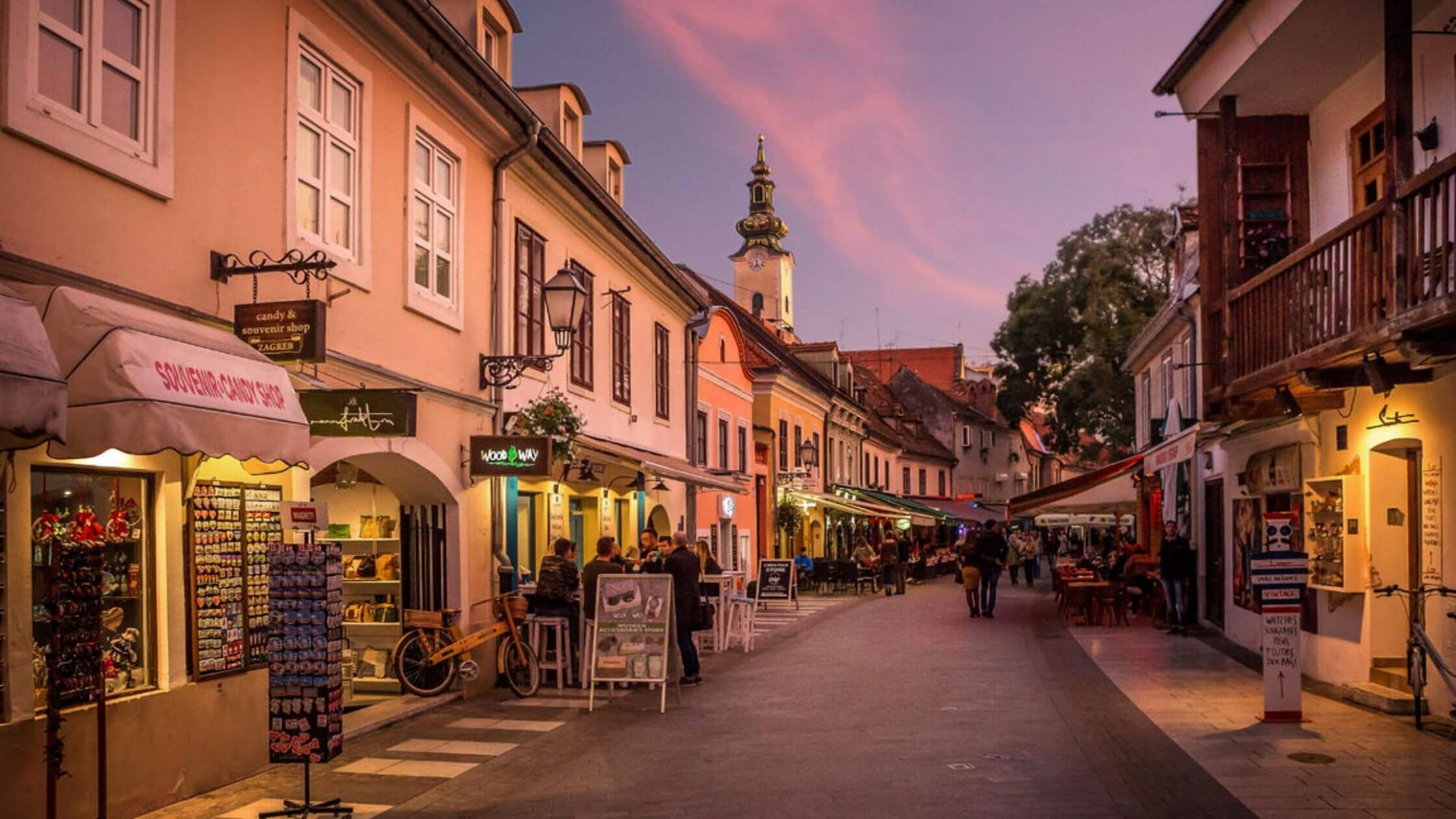
Evenings on Tkalčićeva Street, Zagreb. Visit Zagreb/Facebook.
Hungry? Head to Dolac market, Zagreb's main open-air farmers market to pick up some fresh, seasonal produce and souvenirs. You can also choose to end your day with a tasty meal and local wine from any of the excellent restaurants, bars, and cafes along Tkalčićeva Street.
Day 2: Rovinj
After a bustling day in Zagreb, the enchanting city of Rovinj is a splendid change of pace. Perfectly situated on the Istrian peninsula, the city boasts a rich heritage, from being settled by Venetian tribes, to becoming part of the Byzantine and Frankish Empires, all reflected in the diversity of the city’s architecture, art, and culture.
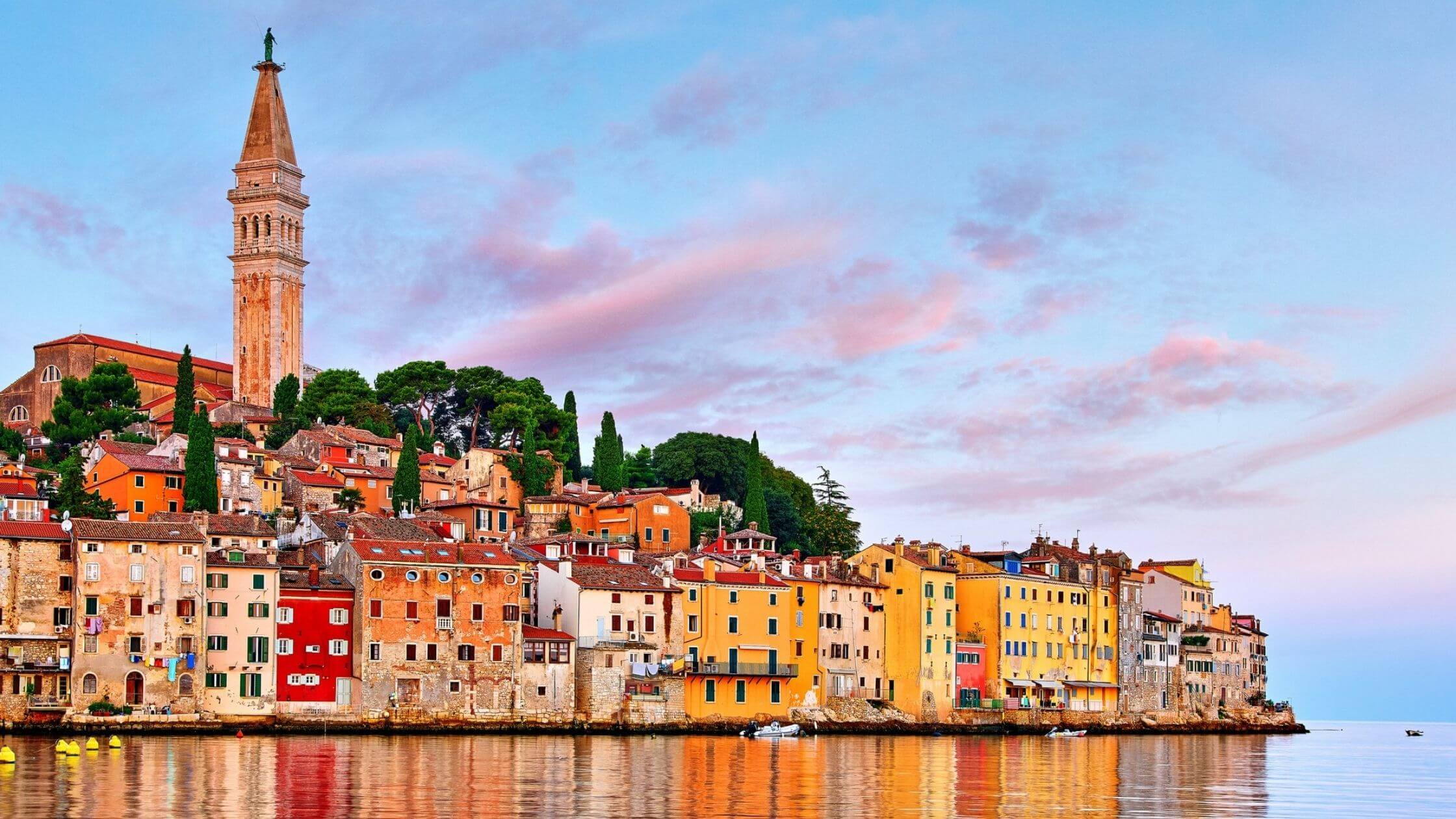
This stunning setting has been a popular film setting for movies such as "The Hitman's Wife's Bodyguard". Rovinj Tourist Board/Facebook.
Stroll along the beautiful cobbled streets and narrow alleys of Rovinj Old Town and make your way towards St. Euphemia Cathedral. Along the way, you should pass by Grisia Street, lined with souvenir stalls and galleries with the most unique pieces to add to your collection.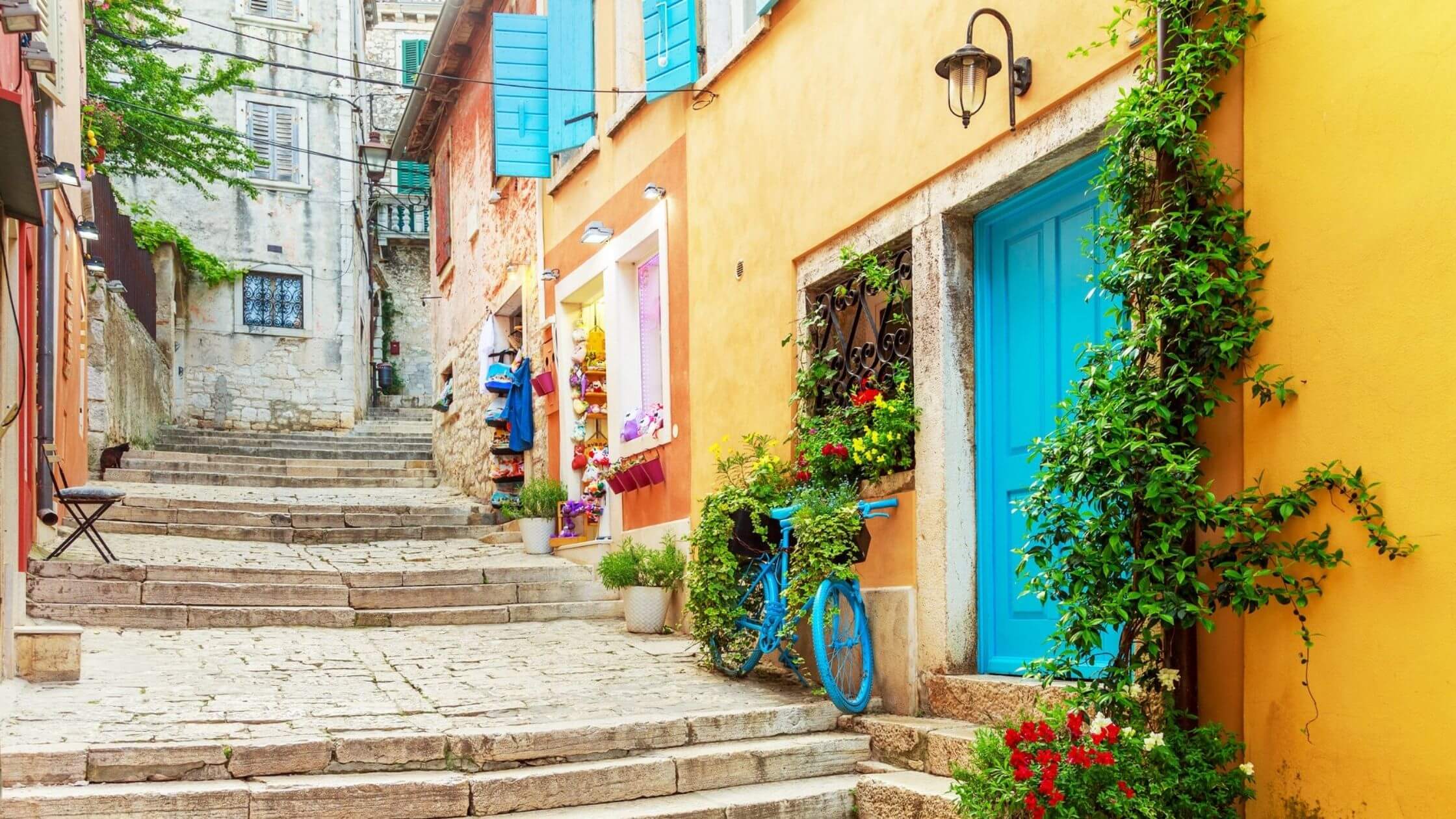
The charming, picturesque streets of Rovinj's Old Town. Rovinj Tourist Board/Facebook.
If you have time to spare, take a day trip to Sveta Katarina, a small picturesque island that’s a mere 10-minute water taxi ride from the pier. Spend the afternoon taking a dip in the aquamarine waters of the bay, or hike on one of the numerous trails dotted around the island, or both!
Alternatively, sit back and relax on some of the most beautiful beaches in Istria such as Amarin, Borik, or Valdaliso Beach.
Day 3: Pula
Before leaving the Istrian Coast, make Pula the next stop on your road trip. Serving as the capital of Istria, Pula was the main military port for the Austro-Hungarian Monarchy at the height of its military glory. Today, remnants of these times are reflected in the city’s breathtaking landscape.
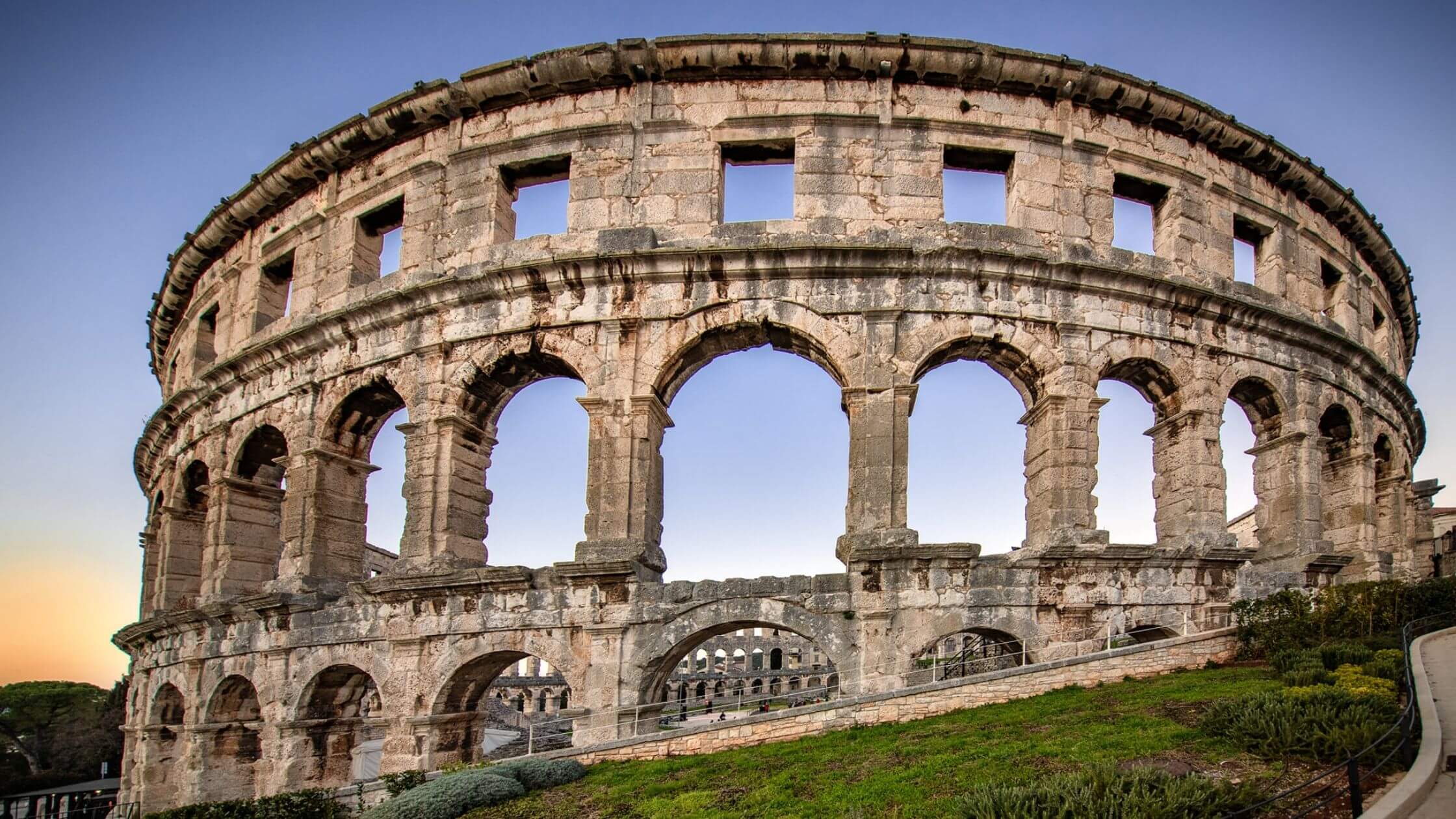
The Pula Arena frequently hosts concerts and festivals throughout the year. Pula Plus/Facebook.
The famous Pula Arena, one of the most well preserved Roman amphitheaters in the world, is a must-see! Another not to be missed landmark is the Temple of Augustus, a monument dedicated to the first Roman emperor in honor of his rule.
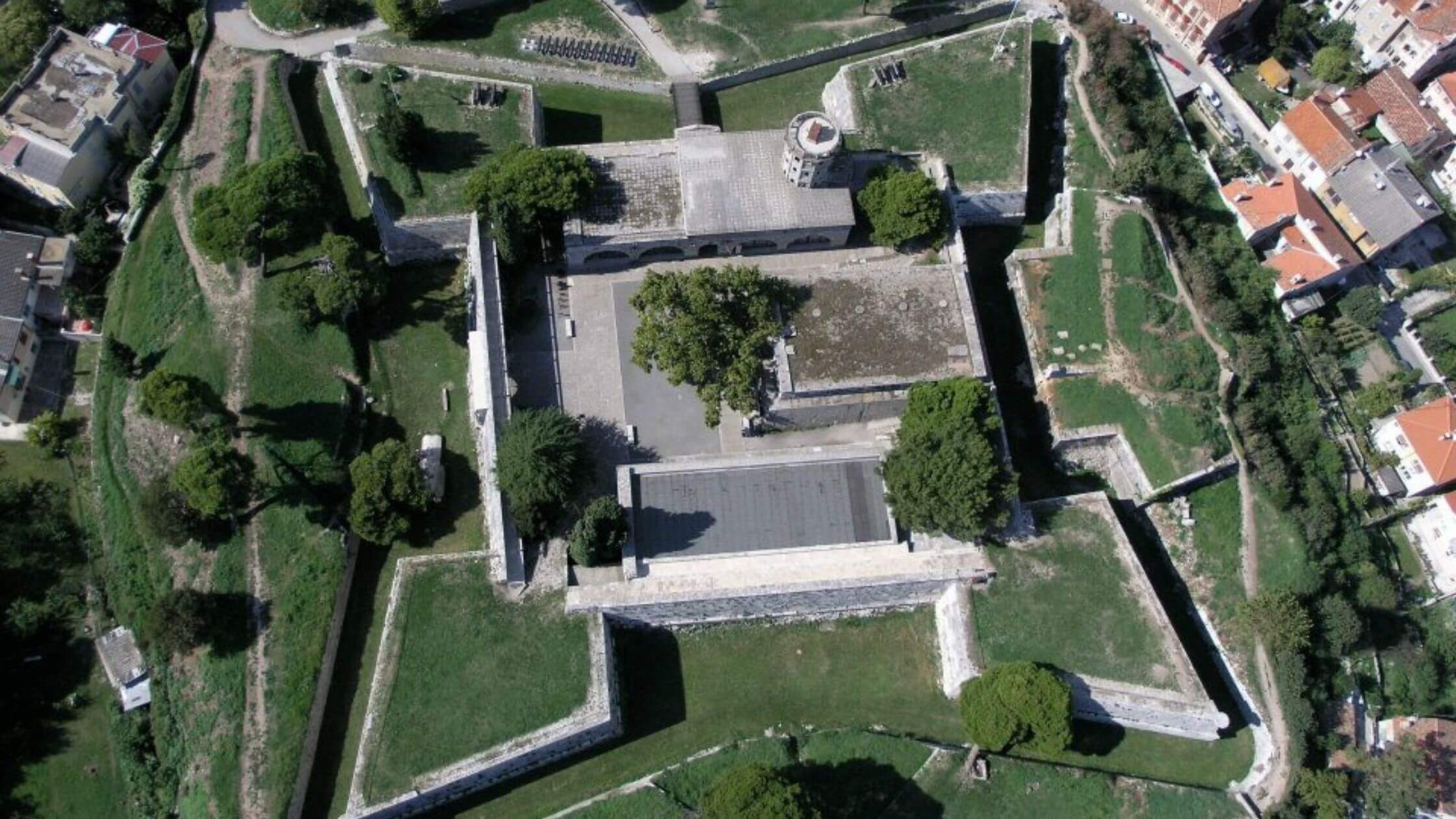
The unique shape of Fort Puna Christo. Pula Plus/Facebook.
Also check out the impressive Fort Punta Christo, which includes an underground section to explore and a well-stocked rooftop bar for refreshments after. You can also enjoy magnificent 360-degree views of Pula from the Venetian Fortress (Kaštel) which also houses the Historical and Maritime Museum of Istria.
Day 4: Plitvice National Park
Although Croatia boasts some of the best coastlines in the world, Plitvice Lakes National Park consistently appears in the top must-see places to visit in Croatia, and for good reason! This UNESCO World Heritage Site holds the title as the oldest and largest national park in Croatia, famous for its gorgeous turquoise lakes. Well worth the detour inland.
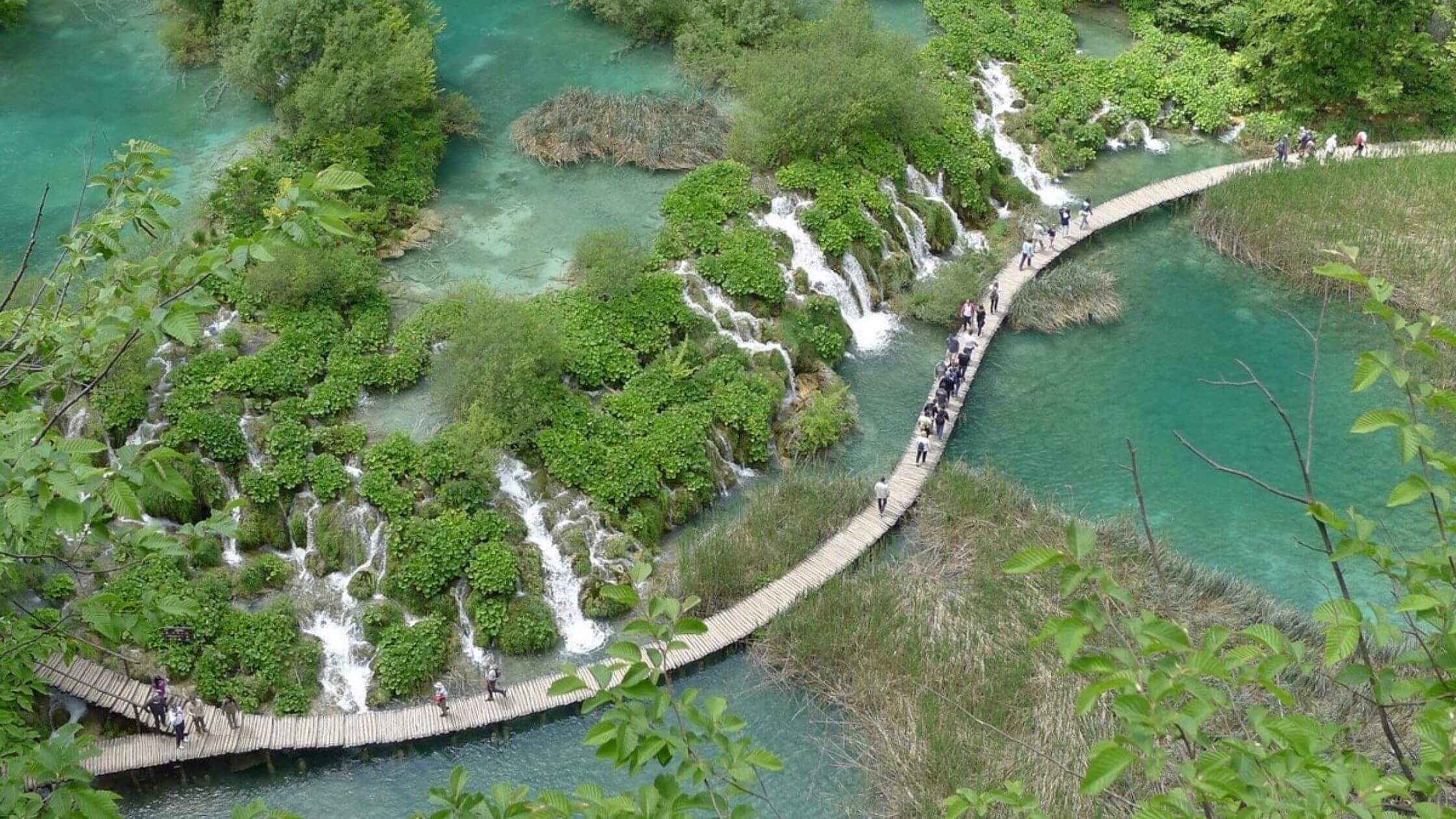 The main walkway of Plitvice Lakes National Park. Plitvice Lakes National Park/Facebook.
The main walkway of Plitvice Lakes National Park. Plitvice Lakes National Park/Facebook.
Be aware that the park can get very crowded during the season! To avoid this, just be prepared to visit early (7-8am), or better still, stop by during off-peak seasons where the park transforms into the perfect winter wonderland.
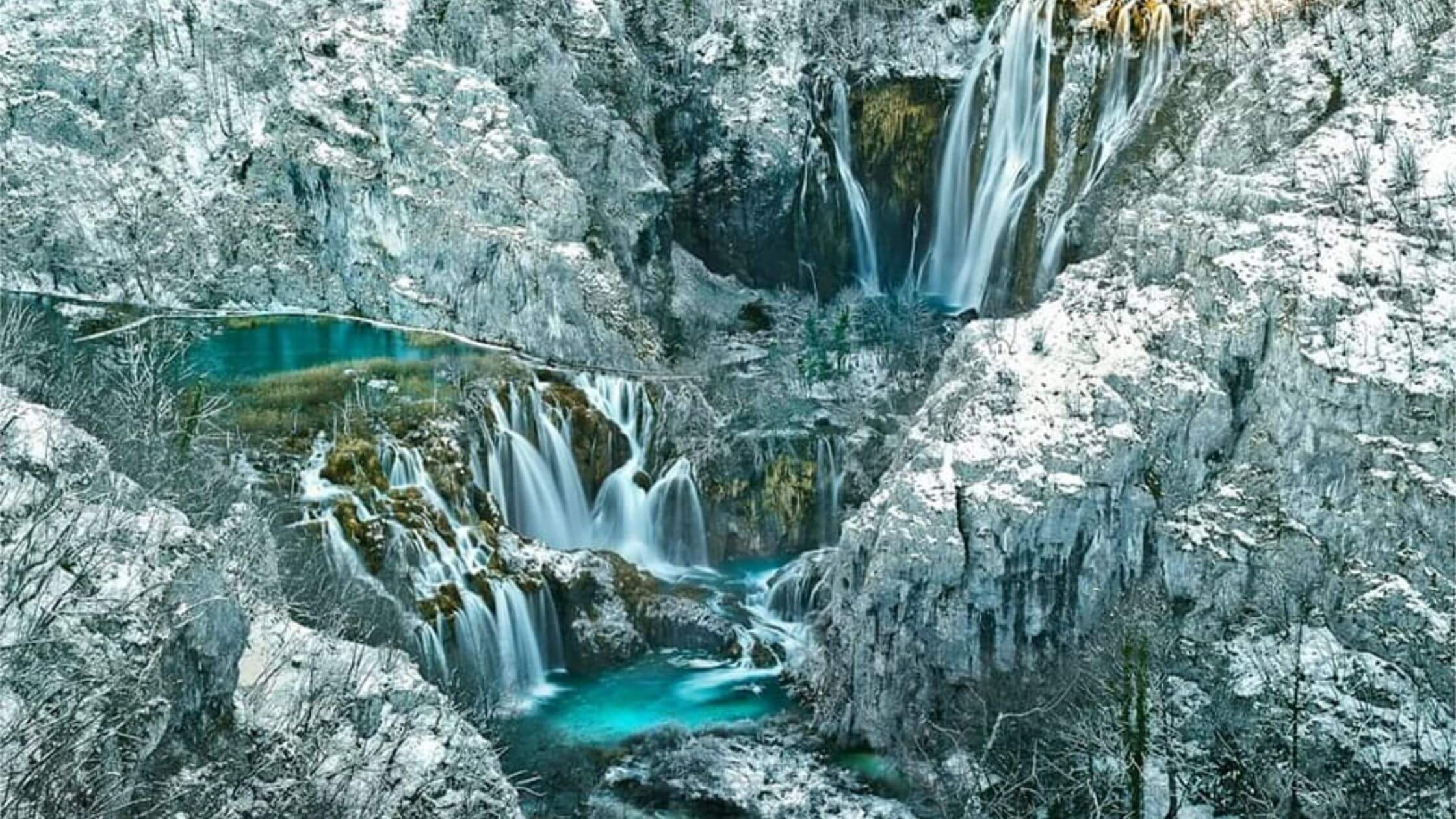
Plitvice Lakes National Park/Facebook.
Day 5: Zadar
After a day in the lush forests, take a scenic drive back to the Dalmatian coast and spend a day in the charming city of Zadar, the oldest continuously inhabited Croatian city. Today, cozy cafes and art galleries are seamlessly woven into remains from the times of Julius Caesar and Emperor Augustus.
Enjoy a relaxing stroll through Old Town and admire the historical architecture including the Church of St. Donatus, the Landward Gate, the Cathedral of St. Anastasia, and the Roman Forum.
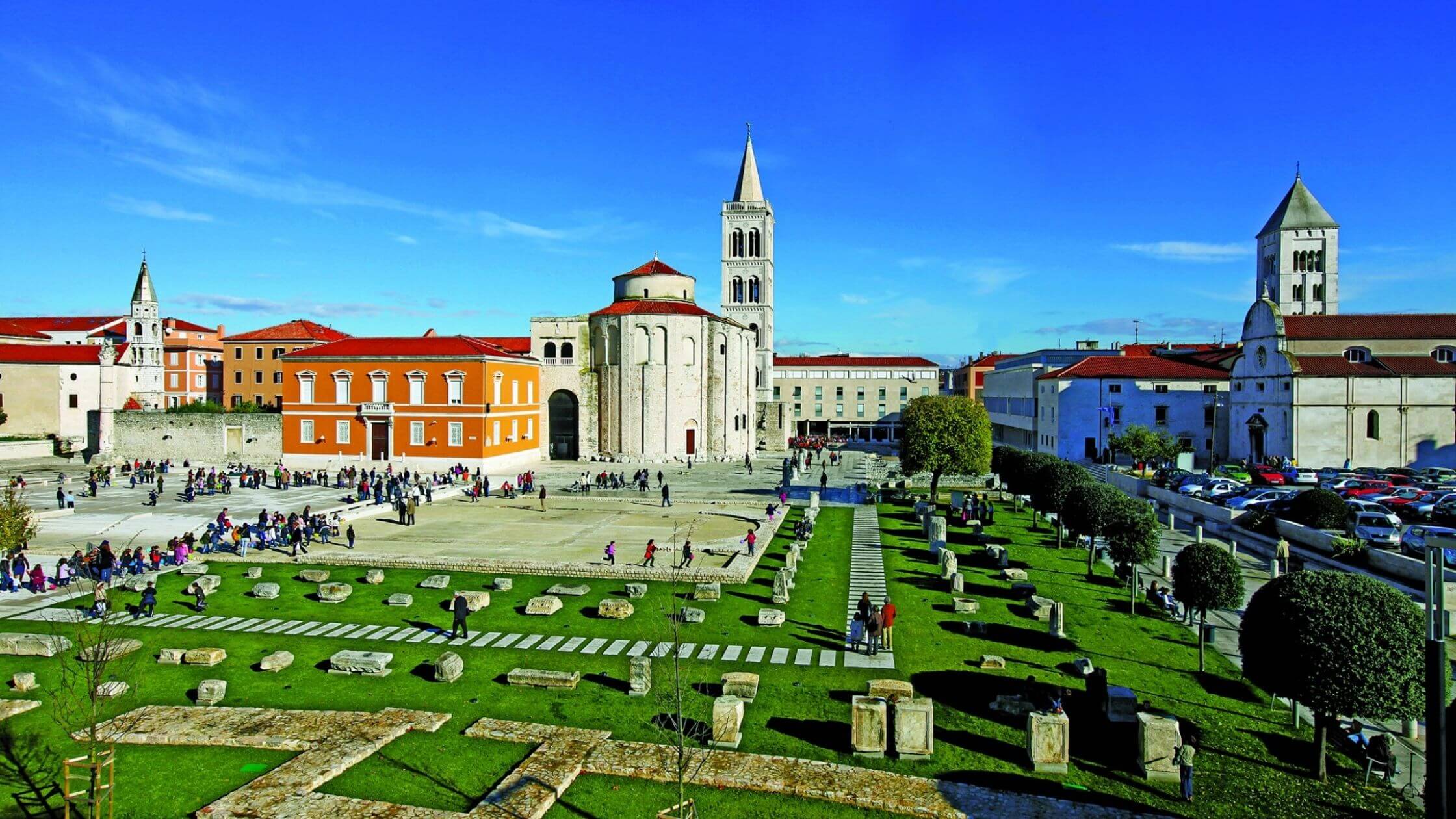
Ruins in the Old Town of Zadar. Zadar Region/Facebook
Along the way, catch the famous Sea Organ, and a sunset so beautiful, it even captivated Alfred Hitchcock! Just after sunset, take in the light show at the Sun Salutation, an installation created by Nikola Bašić, the same artist who designed the sea organ.
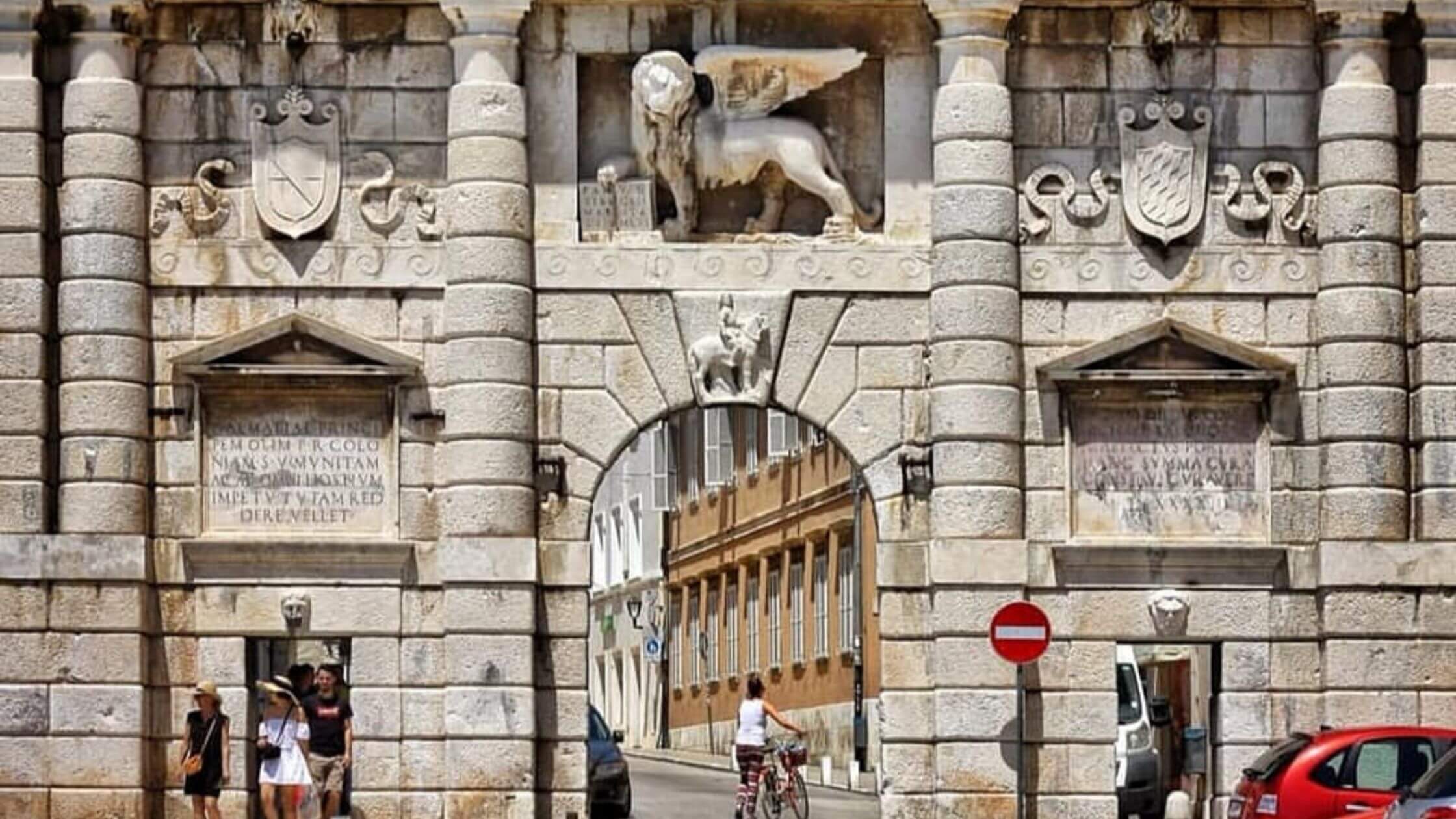
The Landward Gate, Zadar. Zadar Region/Facebook
If you have some time in between, head to Pag Island to try some of the famous Paski Cheese or to Nin, home to Queen’s Beach, the longest sandy beach in Croatia. Other gorgeous beaches along the coast of Zadar include Kolovare and Borik.

Award-winning sheep's cheese from Pag Island. Pag Tourist Board/Facebook.
Day 6: Split
Welcome to Split, the largest city in Dalmatia, and second-largest in all of Croatia. The city was founded as the Greek colony of Aspálathos between the 3rd and 2nd century BC.
It was later where Diocletian's Palace was built for the Roman emperor in AD 305. The palace also houses the Peristil, or the main square, another great place to enjoy some coffee and people-watch in addition to the Riva promenade.
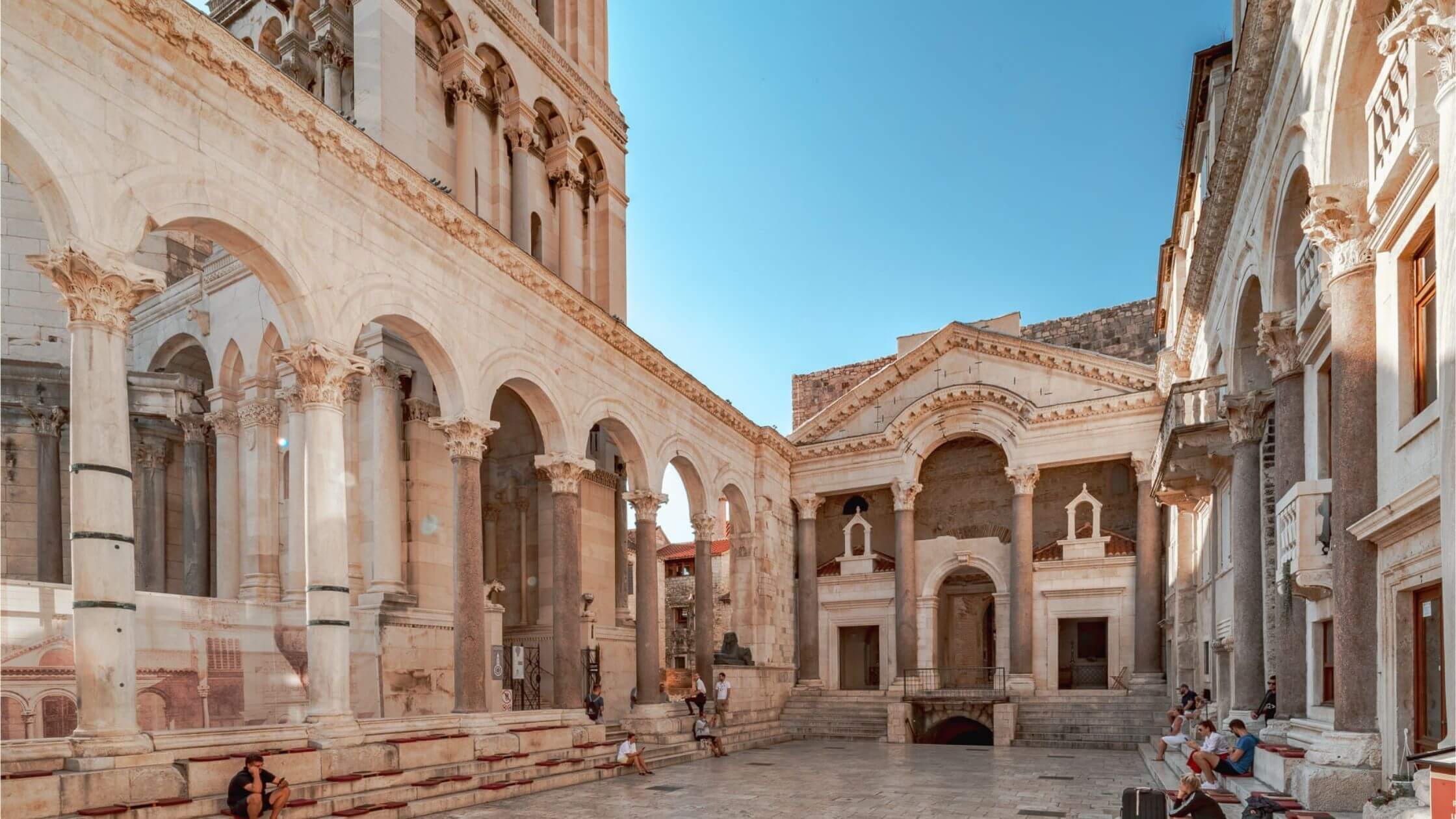
Enjoy a drink inside the walls of the Diocletian's Palace, Split. Visit Split/Facebook
While exploring the Old Town, stop by the Green Market, the largest farmer’s market in Split, to pick up some fresh, organic produce. Turn the corner and it is difficult to miss the 8.5-meter statue of Gregory of Nin, sculpted by world-renowned artist Ivan Meštrović. Rubbing the statue’s toe is said to bring good luck, so much so that it has been worn smooth by visitors over the years.
You can also squeeze in a light hike up Marjan Hill, also known as the “lungs of Split”. Its summit is an ideal place for a picnic, offering marvelous views of the harbor and neighboring islands.
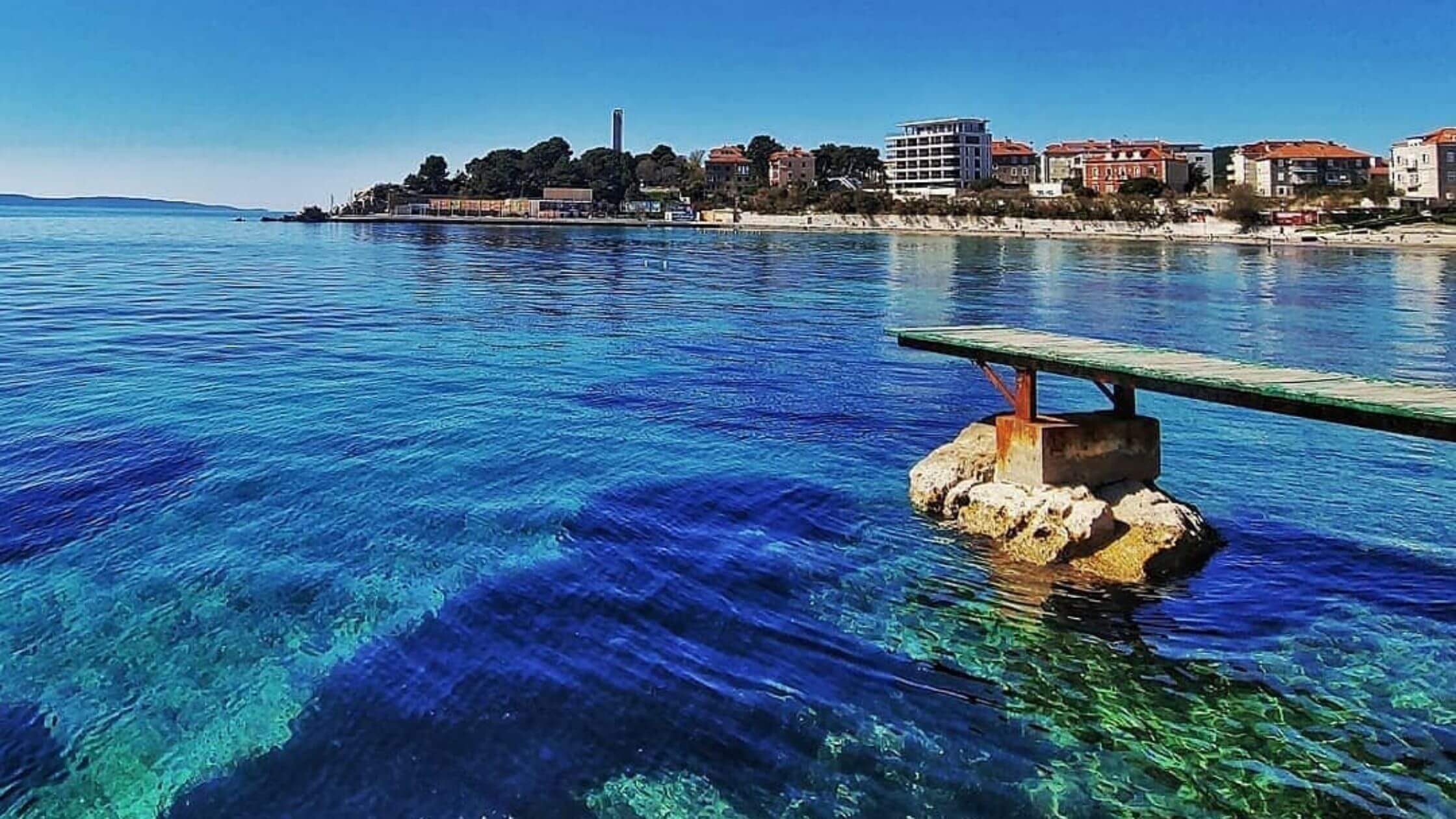
The crystal clear waters of Bačvice beach. Visit Split/Facebook
Fancy another beach day? Bačvice beach is a popular hangout spot in the center of Split. Relax at one of the many cafe bars and watch the locals play picigin, a traditional ball game. Rumor has it this beach is also where the sport originates from.
Day 7: Krka/Omiš/Trogir
Don't be too quick to leave Split. From here, there are several options for day tours to surrounding attractions.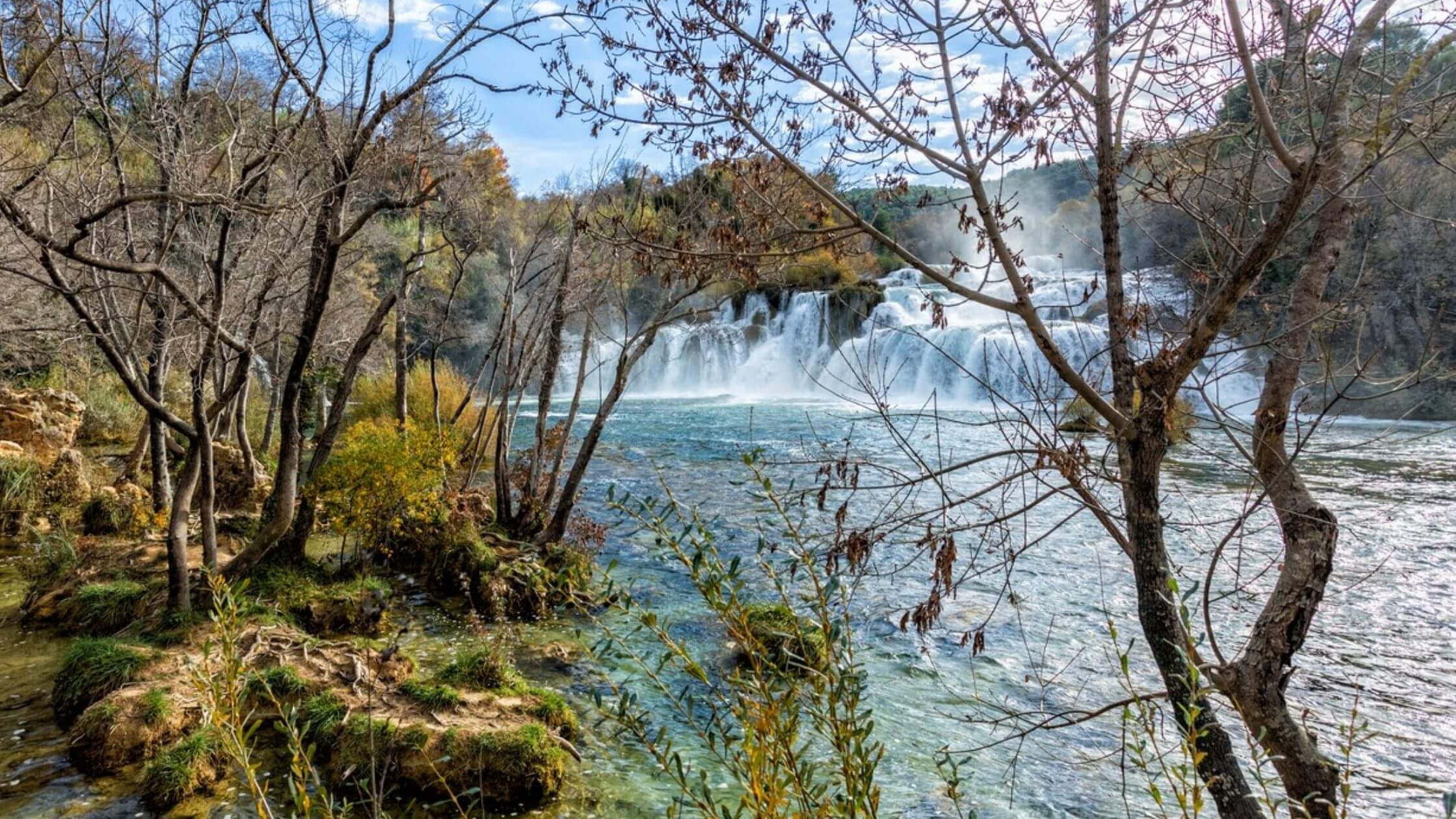
Some of the most stunning waterfalls in Croatia can be found at Krka National Park. Krka Nationa Park/Facebook
For nature lovers, Krka National Park is another national park about an hour’s drive from Split. Spend a day walking along well-maintained trails that wind along some of the most stunning waterfalls in the country. Again, make sure you get there early to avoid the crowds!
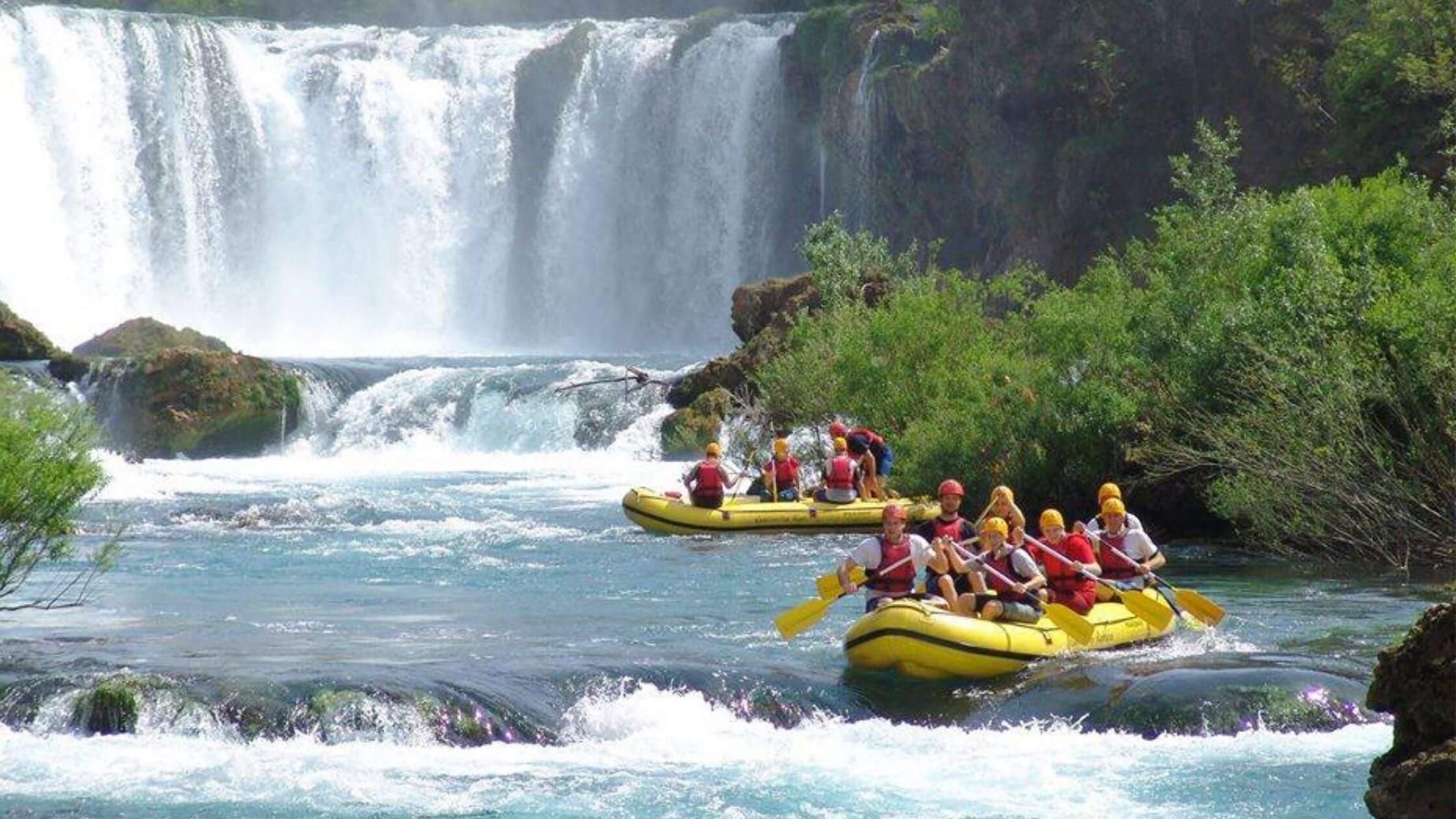
Try white water rafting in Omiš. Tourist Board Omiš/Facebook
For those craving more action, head to the picturesque town of Omiš which offers one of the most dramatic scenes on the coast. The city is nestled in a canyon surrounded by gray, craggy mountains, contrasting the peacock blue waters where the Cetina River meets the Adriatic Sea. Omiš offers white water rafting, free climbing, ziplining, abseiling, and canyoning, amongst other activities for visitors seeking a bit of a thrill on their vacation.
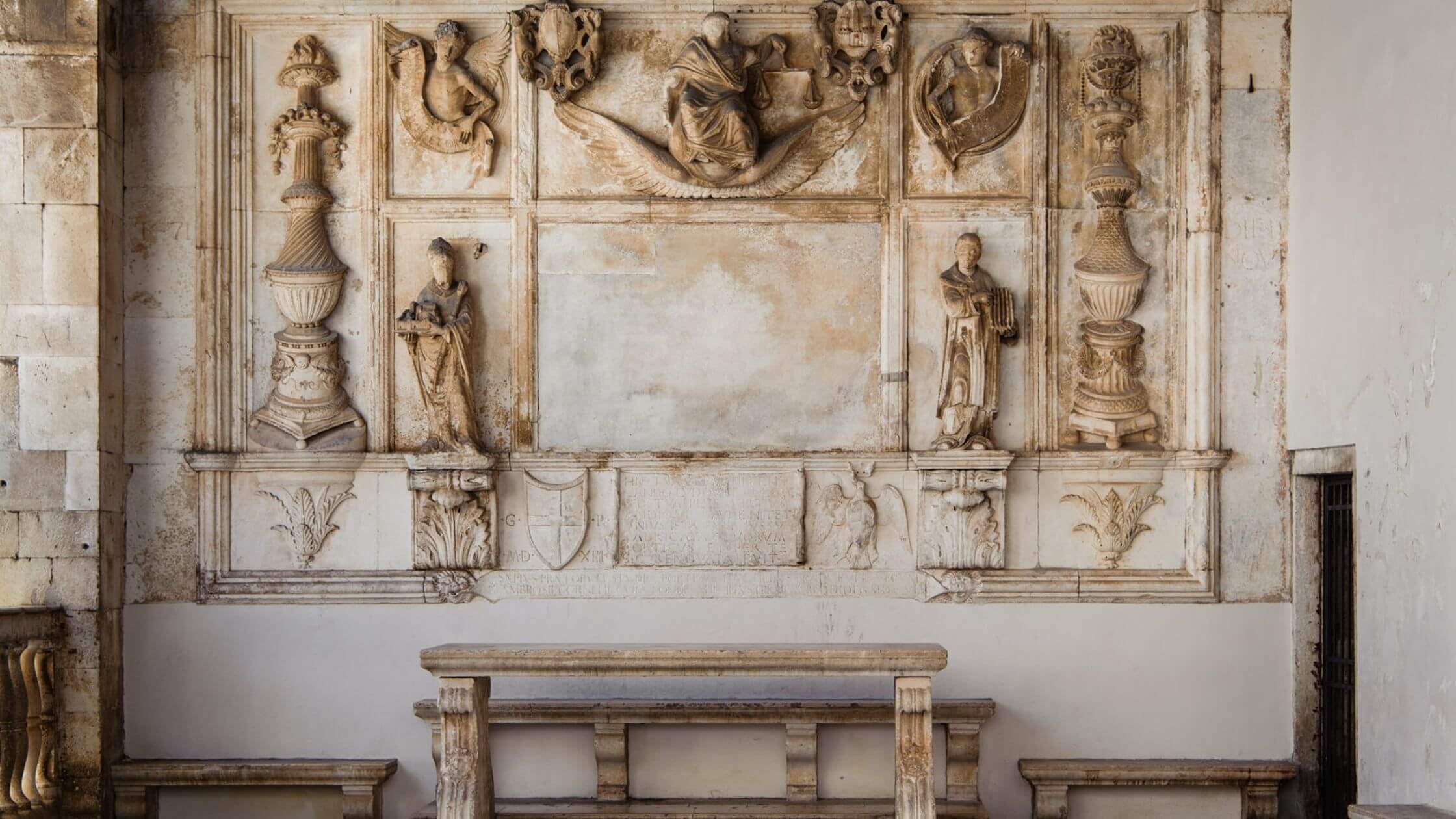
Just one of the many well-preserved remains scattered around Trogir's Old Town. Visit Trogir/Facebook
For the history buff, head to Trogir which has the best-preserved Romanesque-Gothic complex in all of Central Europe. Take a walk around the Old Town, surrounded by walls comprising a series of dwellings and palaces from the Romanesque, Gothic, Renaissance, and Baroque periods.
Day 8: Hvar
With over 1,000 islands, it wouldn’t be a complete trip to Croatia without doing some island hopping. From Split, take the 1-hour ferry ride over to Hvar. Its beauty and vibrant nightlife have made it a regular vacation spot for the likes of celebrities such as George Clooney and Beyonce.
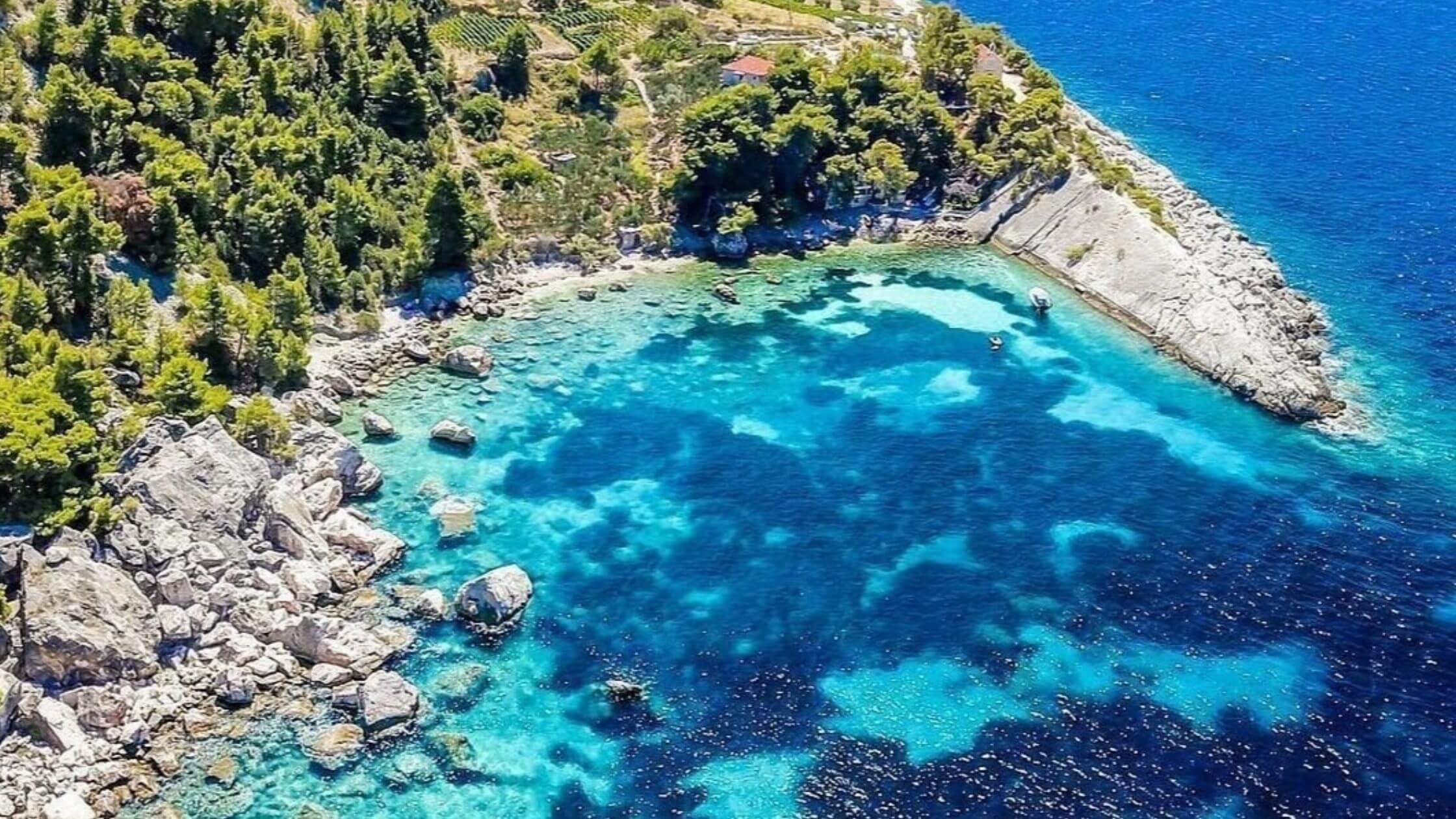
Hvar is one of the longest and sunniest islands in Croatia. Hvar Tourist Board/Facebook
Start by wandering around St. Stephen’s Square, the largest square in Croatia and don’t miss the Cathedral of St. Stephen and the Hvar public theater. For the best view, climb to the top of the Španjola Fortress to get an unobstructed view overlooking Hvar Town and nearby Pakleni Islands. You can even rent a small boat (no license required) to explore these islands on your own!
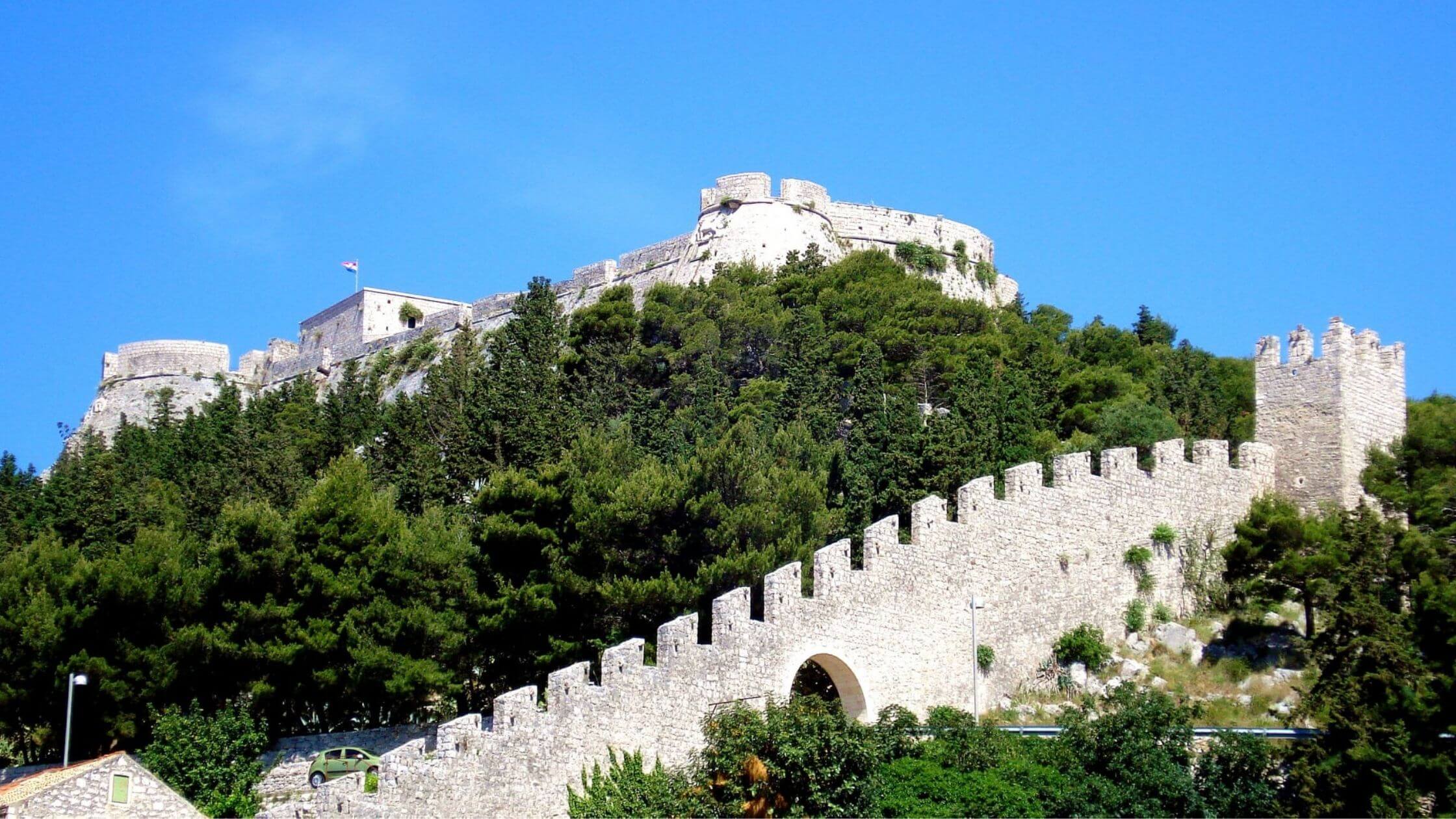
The view from the top of the Španjola Fortress is unparalleled on the island. Hvar Tourist Board/Facebook
Once you’ve taken in all these sights, enjoy another relaxing beach day at one of the many pristine beaches such as Malo Zaraće, Dubovica, or Pokonji Dol.
Alternatively, if you’re looking for another day trip, book a tour with one of the local travel agencies to the Blue Caves on Biševo and marvel at its clear, iridescent blue waters.
Day 9: Korčula
After the buzz of Hvar, take the ferry to the tranquil town of Vela Luka on the island of Korčula, the birthplace of famed explorer Marco Polo and home to some of the best Croatian wines.
From Vela Luka, take a scenic drive towards the town of Korčula, also known as “little Dubrovnik”. Along the way, stop by the numerous family-run vineyards that welcome visitors for wine and cheese tastings.
Grk is a white wine variety grown almost exclusively on Korčula, other white wines such as Pošip and Rukatac are also premier Croatian wines, often served on celebratory occasions. For fans of red wine, do grab a bottle or 2 of Plavac Mali.
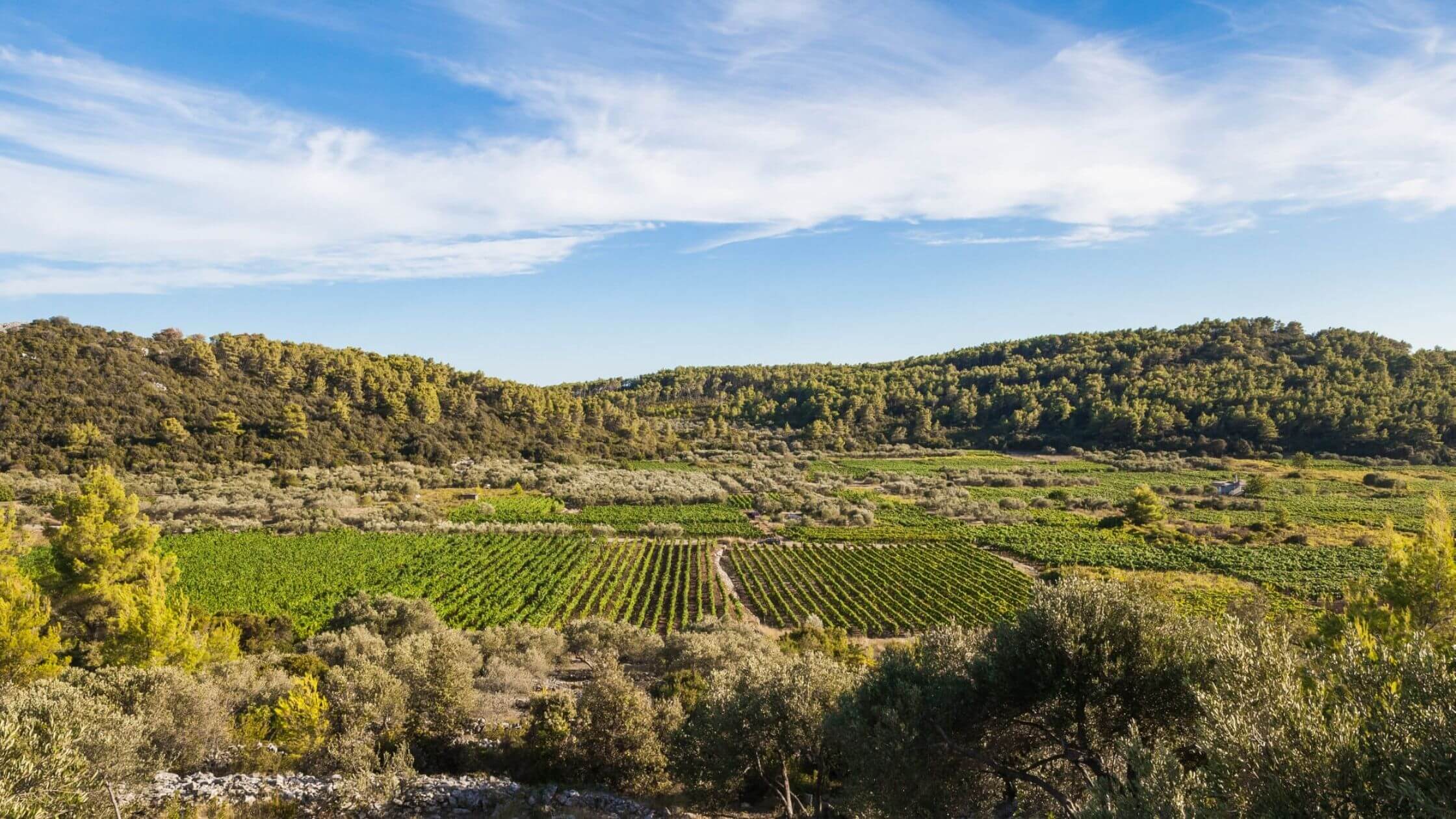
Vineyards of Korčula island. Visit Korčula/Facebook
In Korčula, walk off the afternoon’s indulgences exploring the streets of the Old Town with its architectural influences by the Venetian Renaissance, before capping off the night with a meal and more wine at any of its superb restaurants.
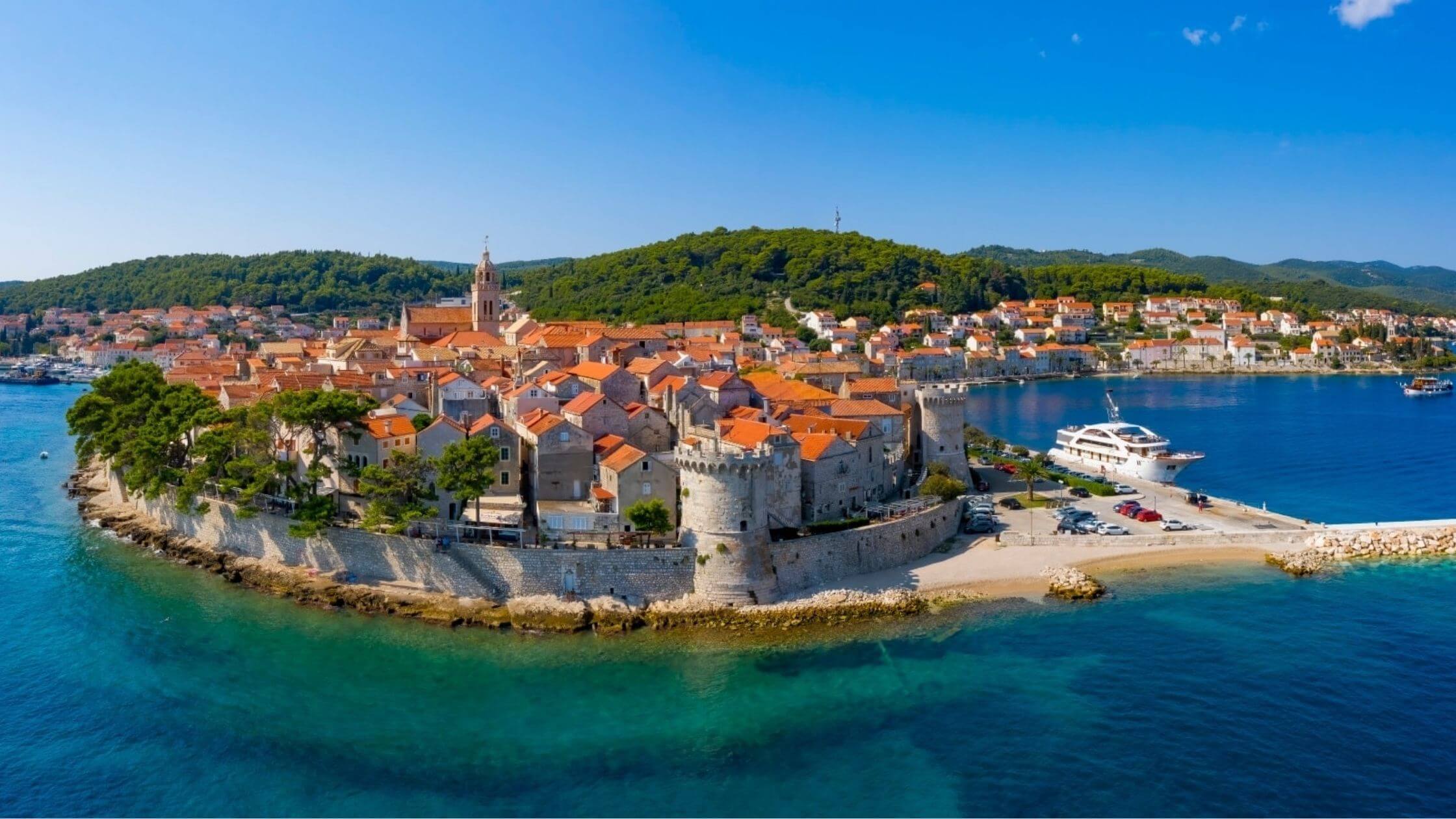
Korčula town. Visit Korčula/Facebook
Day 10: Dubrovnik
There’s no better way to end the trip than with Dubrovnik. And yes, there is no shortage of Game of Thrones tours to indulge your senses, but there is so much more to this medieval city than where Cersei Lannister did her walk of shame.
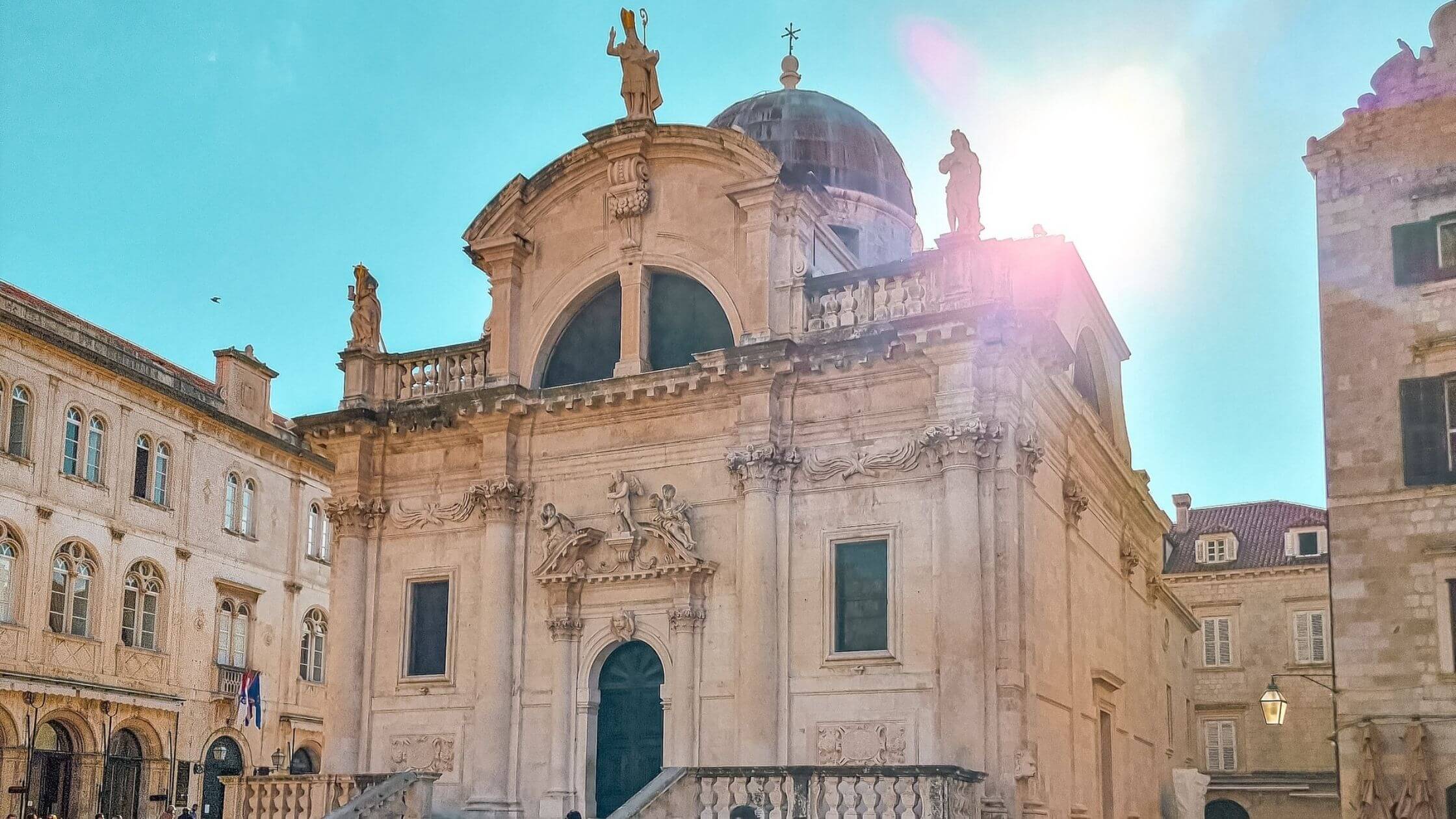
The beautiful Saint Blaise's Church in Dubrovnik was built during the 10th century. Dubrovnik Tourist Board/Facebook
Talk a walk along the city walls and through Stradun, Dubrovnik’s main street. From here, you can also catch Onofrio’s Large Fountain that used to supply Dubrovnik with fresh water during the Middle Ages and other impressive structures including the Clock Tower, Saint Blaise's Church, Saint Ignatius Church, Cathedral of the Assumption, and the Franciscan Monastery.
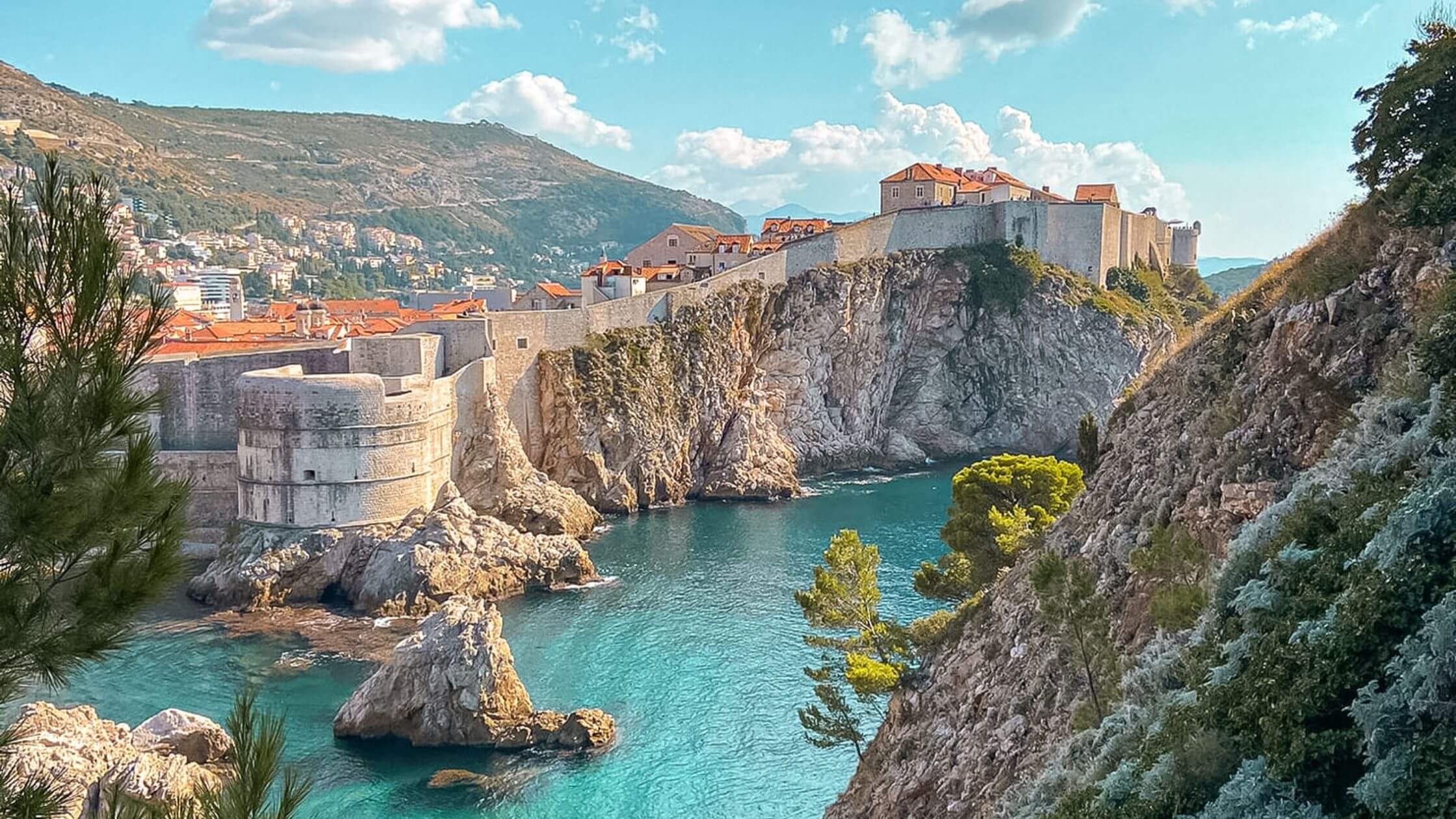
The view from beyond the walls of Dubrovnik looking upon Fort Lovrijenac. Dubrovnik Tourist Board/Facebook
Watch the sunsets and reminisce on your amazing road trip through the country at one of the cliff bars along the city walls, before capping it all off with an exquisite meal at one of the many Michelin-starred or recommended restaurants Dubrovnik has to offer.
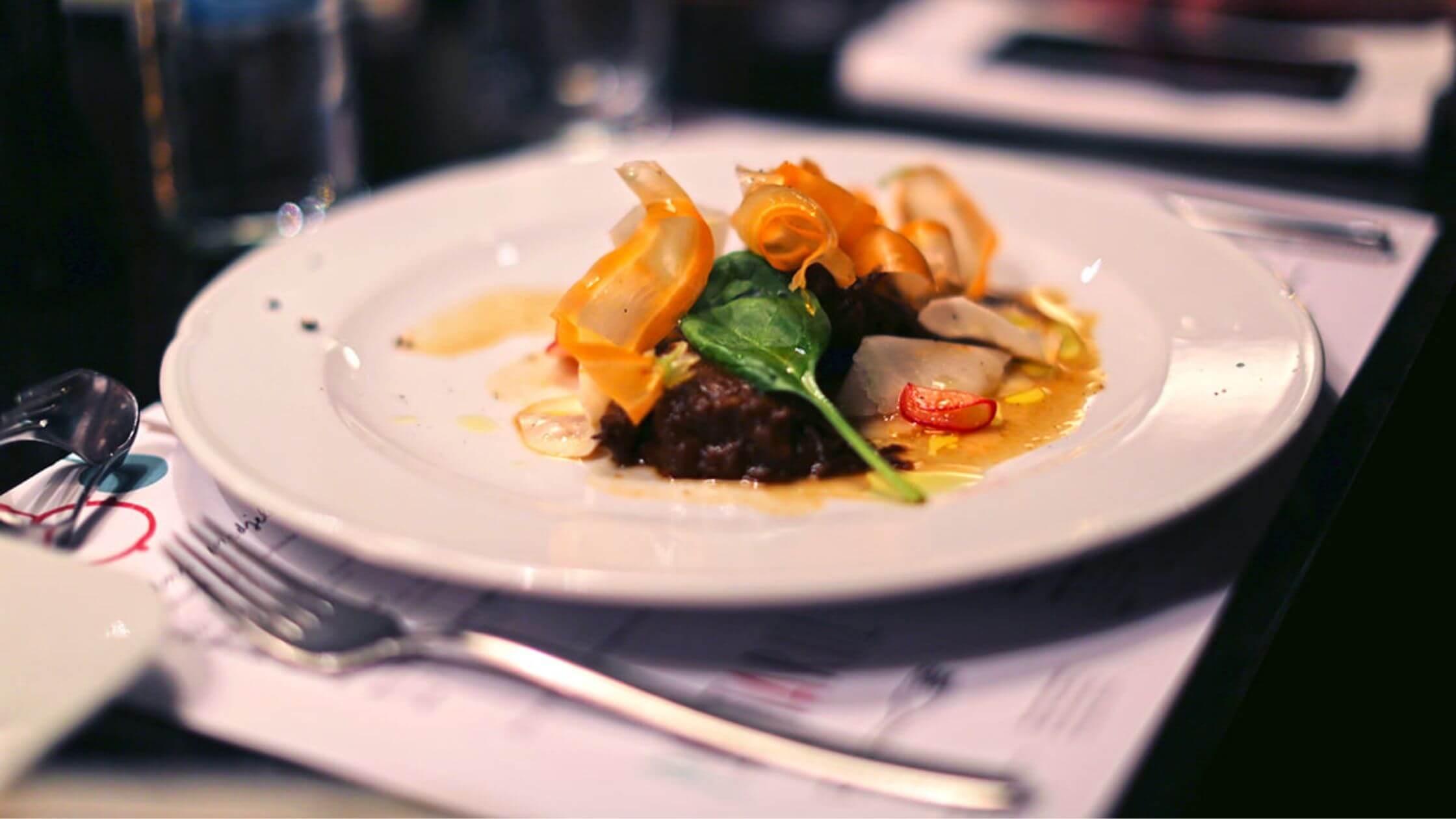
Nothing like a luscious meal to top off a fantastic experience road-tripping in Croatia. Dubrovnik Tourist Board/Facebook
And that’s all folks, you’ve done it! Croatia in 10 days! Bear in mind, this is merely the appetizer of what Croatia has to offer. Customize this guide to better suit your tastes and pace and remember, don’t hesitate to ask the locals in order to unlock the best secrets each location has to offer.
For more on travel in Croatia, follow TCN's dedicated page.
Do Summer Showers Impact Microbiological Water Pollution? Omiš Watercare Project Presented
December 11, 2021 - Do heavy summer showers affect the quality of the sea? After extreme rains, there is a slight increase in bacteriological sea pollution. However, these values are so low that Omiš beaches are still within excellent sea quality parameters, reveals the Omiš Watercare project.
Rain greeted the participants of the Omiš Watercare project's final meeting, where the results of the impact of summer showers on microbiological pollution of the Cetina River and the famous Omiš sandy beach were presented.
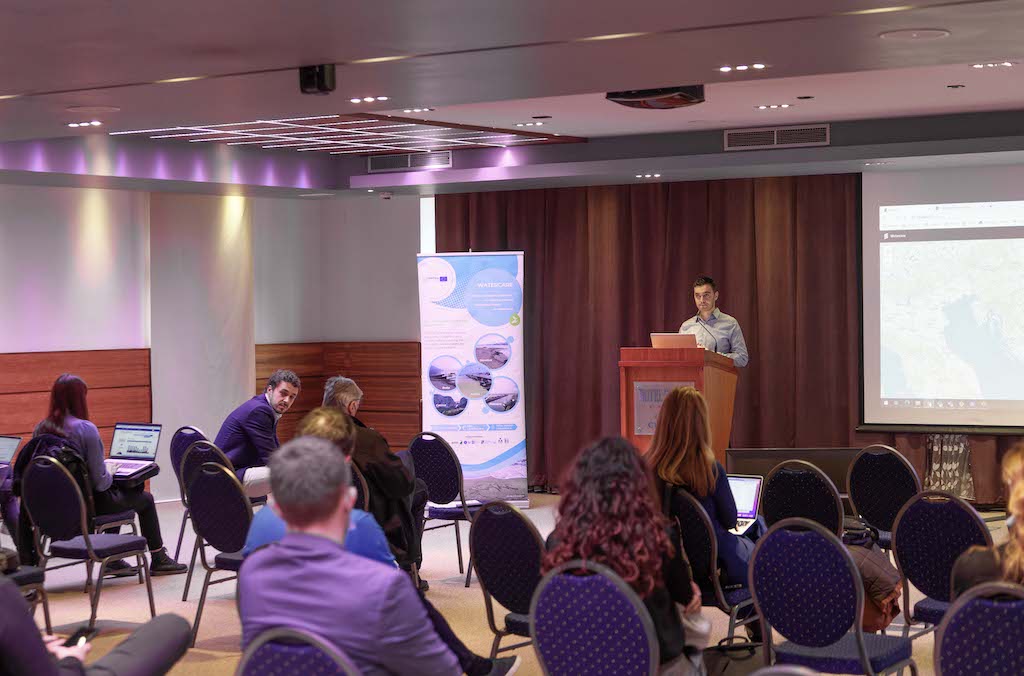
"Cetina is the source of life and economy in much of Dalmatia, from Vrlika to Omiš, all places and cities are connected to the Cetina, and our islands Brač and Hvar depend on it. Therefore, the importance of this river in our lives is indescribable, and that is why we hope that the results of the research are encouraging and that they will give us guidelines for its preservation and protection," said Žarko Kovačić, Deputy Mayor of Omiš, with a warm welcome to the participants.
On behalf of the organizers and partners in the project, Split-Dalmatia County, Anđelko Katavić, Head of the Administrative Department for Economy, EU Funds and Agriculture, explained the complementarity of this with another project implemented by the county on sustainable use of the Cetina River Basin:
"One of the greatest natural resources of our county and state is water, and on the example of the Jadro River, we see how many problems can be caused by more and more frequent showers that increase the parameter of drinking water turbidity. As the name of the project itself says, water should be taken care of, and the knowledge, equipment and instruments we have implemented through the project allow us to react in the event of an emergency as soon as possible."
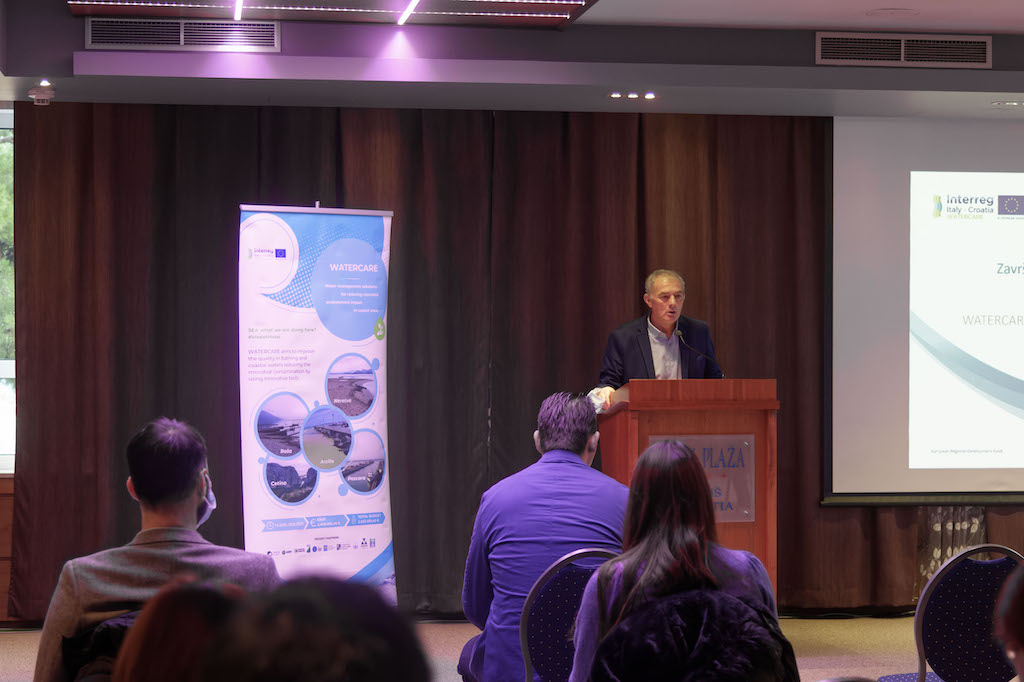
Generally speaking, the quality of the Split-Dalmatia County sea is excellent; only in some places near rivers and streams is the bathing level lower quality. Martin Bućan, meeting moderator and senior advisor from the Administrative Department for Economy, EU Funds and Agriculture, answered if this is happening at the mouth of the Cetina River.
He explained that automatic water sampling was carried out in the downstream part of the Cetina estuary, using two automatic measuring stations that measured several parameters such as water and air temperature, pressure and humidity, precipitation, wind direction and speed. In addition, specially installed measuring probe water parameters such as salinity, temperature, pH, turbidity, etc., were also examined, including E. coli bacteria and intestinal enterococci in the laboratory. At the same time, at regular intervals from May to October this year, seawater samples were analyzed near the mouth of the Cetina River at six locations in Omiš. Fundamental physicochemical quality indicators and bacteriological indicators, i.e., the presence of E. coli and intestinal enterococci, were also analyzed in seawater samples. Seawater samples were always taken during the morning hours and after completing the sampling of automatic stations. Sampling was carried out in different meteorological conditions, during sunny weather and after heavy rainfall.
“Out of a total of 42 seawater samples collected from six measuring stations after rainy weather, 39 were rated excellent, one sample rated good, while two samples were inconsistent. Therefore, research has shown that there is a slight increase in bacteriological pollution of the sea after extreme rains. However, these values are low on Omiš beaches and still within the parameters of the sea category of excellent quality," concluded Martin Bućan.
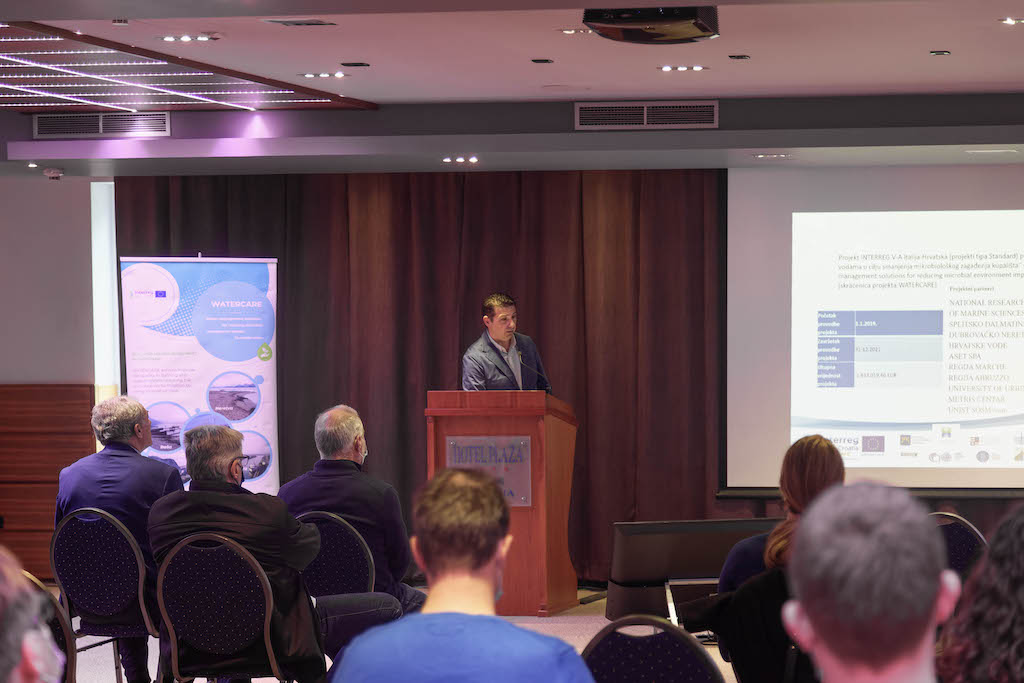
All data obtained from the probes and physical sampling of the sea are transferred to the Watercare project online application, presented by Goran Kopčak from Ericsson Nikola Tesla, an external contractual partner. He explained the functionalities and user interface of the created network application through which numerous stakeholders in the project can access data. Furthermore, thanks to the machine learning concept application, the platform will automatically be able to alert the responsible persons of the County, Civil Protection Headquarters, the City of Omiš, firefighters, and others due to the risk of the increased possibility of bacteriological pollution in the sea.
Once again, the Watercare project confirmed the importance of bringing together all stakeholders with scientific research institutions, which was further argued in their presentation by Marko Mimica and Gina Bilankov from EHCR. They presented a feasibility study to implement innovative solutions of the Cetina River and guidelines for coastal water management following international regulations, as well as the possibility of further financing the developing activities from this project from EU funds.
Water management solutions for reducing microbial environment impact on coastal areas is the full name of the project worth a total of 2.8 million euros, which lasts almost three years and is implemented within the cross-border cooperation program Interreg Italy - Croatia.
To read more about lifestyle in Croatia, follow TCN's dedicated page.
Olmissum from Omiš Among Best 16 Futsal Teams in Europe!
October 31, 2021 - The Olmissum futsal club from Omiš has advanced to the UEFA Futsal Champions League!
Croatian futsal champion Olmissum advanced to the Elite round of the Champions League as the winner of Group 7 in the main qualifying round, with all three victories won at home in Omiš, reports 24 Sata.
In the last round, Omiš defeated Armenian club Leo 5:0 on Saturday and ended the tournament with a maximum of three victories, with 14 goals scored and only one goal conceded. Goals for the Croatian champion were scored by Horvat (17), Jurlina (25, 32), Hrstić (28), and Juretić (32).
Olmissum will thus play among the 16 best teams in Europe. In the Elite Round of the Champions League, four groups with four teams each will be drawn, and only the group winners will go to the Final Four.
Olmissum placed in the Elite round of the Futsal Champions League for the second time in a row. The club was founded in 2015, made its way through the Third and Second Leagues, and then last year, in its first season in the Premier League, they played in the Champions League. Unfortunately, last year, they were knocked out by the Russian team KPRF.
Behind the Olmissum project is the Milavić family, former owners of the Studenac retail chain. The club's leader is Mijo, who wanted to return part of the family earnings to the community. With the city's help, he initiated and financed the construction of the Ribnjak Sports Center, in which they invested 30 million kuna of family money. After that, he founded a futsal club. The idea, the name, design of the jerseys, and coat of arms are all the work of Mijo Milavić.
"There was no futsal club in Omiš at all. Moreover, our neighbors from Dugi Rat took the lead and won local tournaments. So we started from scratch, I called a childhood friend Josip Škorić, who played before, he called the goalkeeper coach Ivica Krstulović Opara, we hired coach Ivica Osibov, and we started," Milavić revealed.
"We broke through the Third and Second Leagues, planned the team, and grew. Osibov was succeeded on the bench by Duje Maretić, who was never a senior coach. We decided to gamble and it paid off. He led us to the championship title."
After placing in the First League, the Omiš team did not reach for instant solutions and players from abroad and instead put together a team of local players.
"We have offered everyone the same - a healthy environment, a great atmosphere, and stable finances. And that suits everyone. We are building a club, not just a team; we have invested money in the hall, so in the conditions, not just in the players. We are growing step by step - the visual identity of the club, the mascot, the anthem, specially designed jerseys, and the youth are important to us. We have everything we need to be stable and recognizable. And above all, we have a young team with character that will stay together for a long time."
For now, the club's financing is based on the Milavić family company, which covers most of all costs.
"It can be said that we covered 99 percent of the club's budget and that little by little, we started looking for sponsors. So far, we have spent time and energy getting the club on its feet, and now we will move on. You know the saying: "First you need to fix and make up the girl, and only then look for a boyfriend."
Mijo Milavić is a sports fanatic, but little is known that he is also a big fan who travels to all Croatia national team matches and is a passionate jersey collector. He also ordered and financed the billboards that welcomed Ivan Perišić and Croatia at the entrance to the town of Omiš after their success at the 2018 World Cup.
"In the 80s and 90s, my family manifested its identity nationally, and lately, we have turned it into local patriotism. We try to help the local community as much as possible through some of our projects. Olmissum is our flagship; it is a club that has 130 children in the youth categories. We want to provide all of them with the best conditions, enable them to be the best, to strive for the maximum, and for their successes to be a signpost for life," concluded Milavić.
To follow the latest sports news in Croatia, follow TCN's dedicated page.
To learn more about sport in Croatia, CLICK HERE.
Omiš in Autumn, the Perfect Time to Visit Mountains, the Cetina and the Sea
October 15, 2021 – With local seafood currently at its best and cooler temperatures inviting runners, hikers and cyclists to this spectacular location, Omiš in autumn is one of the best destinations of the season.
When temperatures cool on the Croatian coast, the telltale signs of tourism start to fade. Villages that were full of people in summer become very still. Only in the larger places does life go on unaffected.
The seaside city of Omiš is one such place. The charming Omiš Old Town streets hold their special atmosphere throughout the year. Autumn, in particular, is a favourite time for visitors to come.
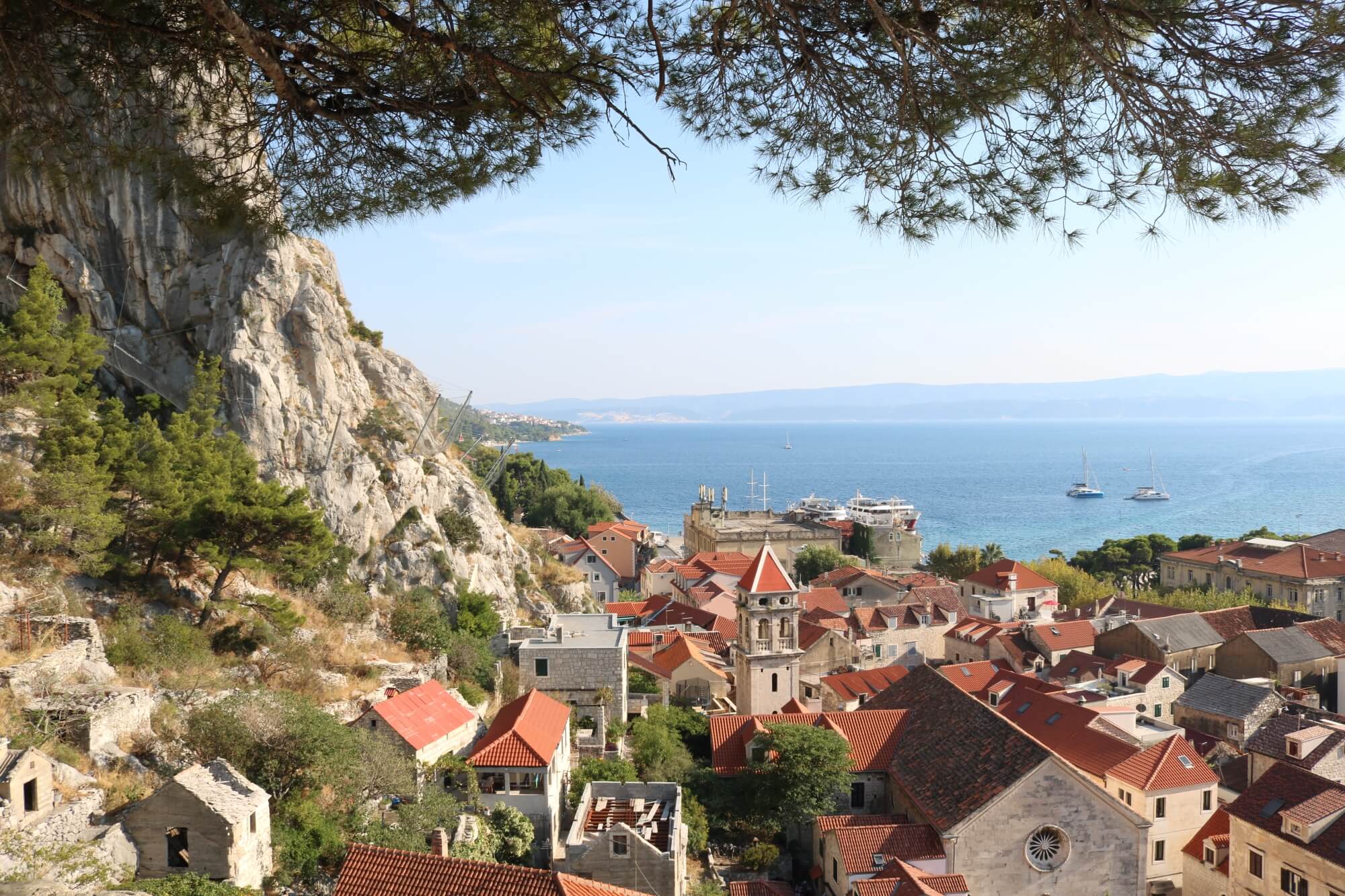
Arguably, this is the time of year when Omiš's famous and distinct cuisine is at its best. Omiš's special bounty of seafood comes from its position on the Cetina river. The best-tasting Mediterranean fish and shellfish love these conditions, where the freshwater meets the saltwater. And, in autumn, the prawns, scampi and calamari are at their biggest and best. The restaurants of Omiš offer fresh, seasonal specialties every day. Their tables are taken by relaxed visitors from all over the region, drawn to the city now the summertime rush has subsided.
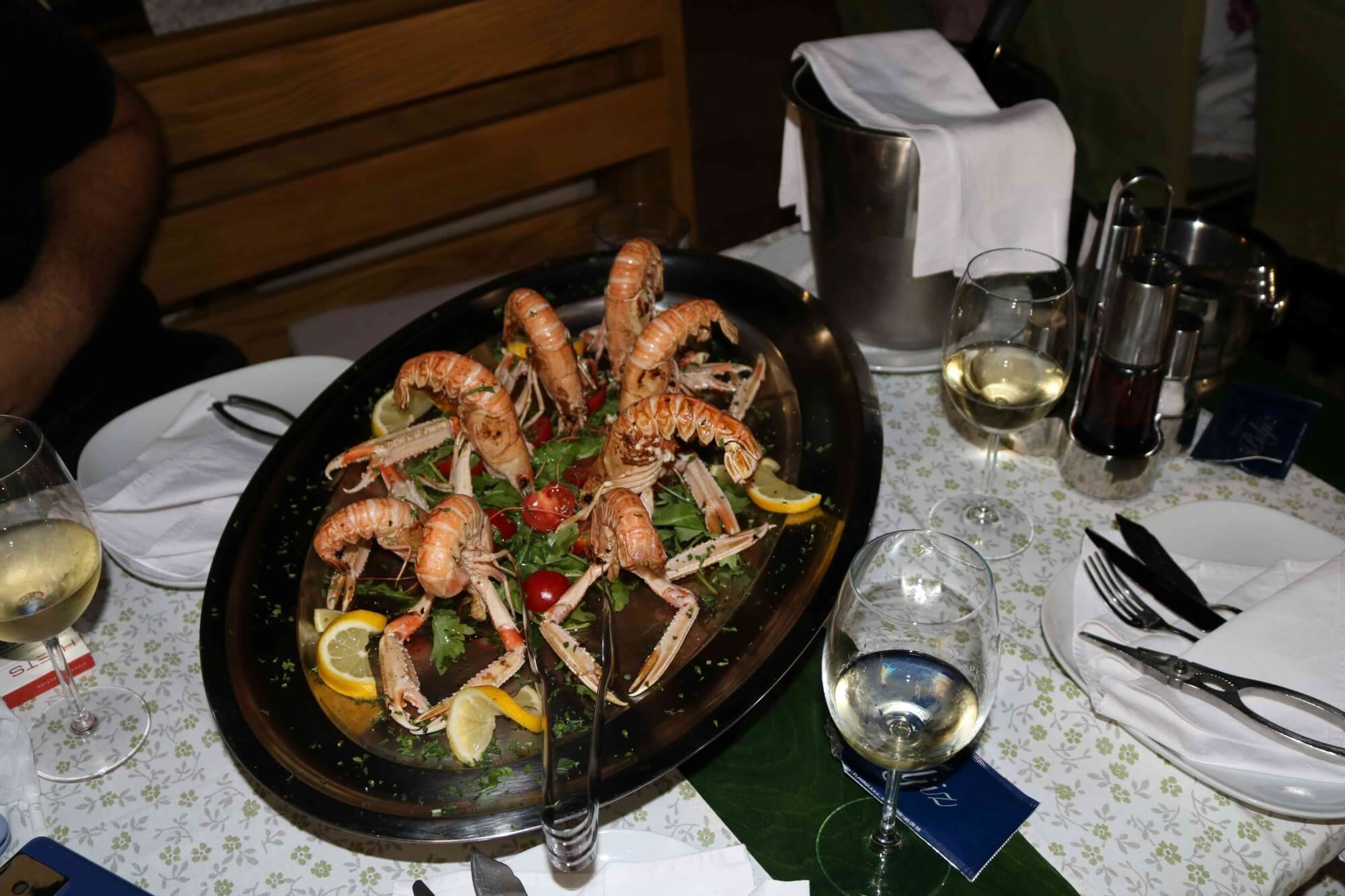 Seafood is an autumn specialty at sister Omiš restaurants Puljiz and Bastion. © Marc Rowlands
Seafood is an autumn specialty at sister Omiš restaurants Puljiz and Bastion. © Marc Rowlands
But, in the hills above and behind Omiš, and along the long promenades of the Omiš riviera, different kinds of visitors can be found. The cooler temperatures of autumn are perfect for cycling, running, hiking and walking.
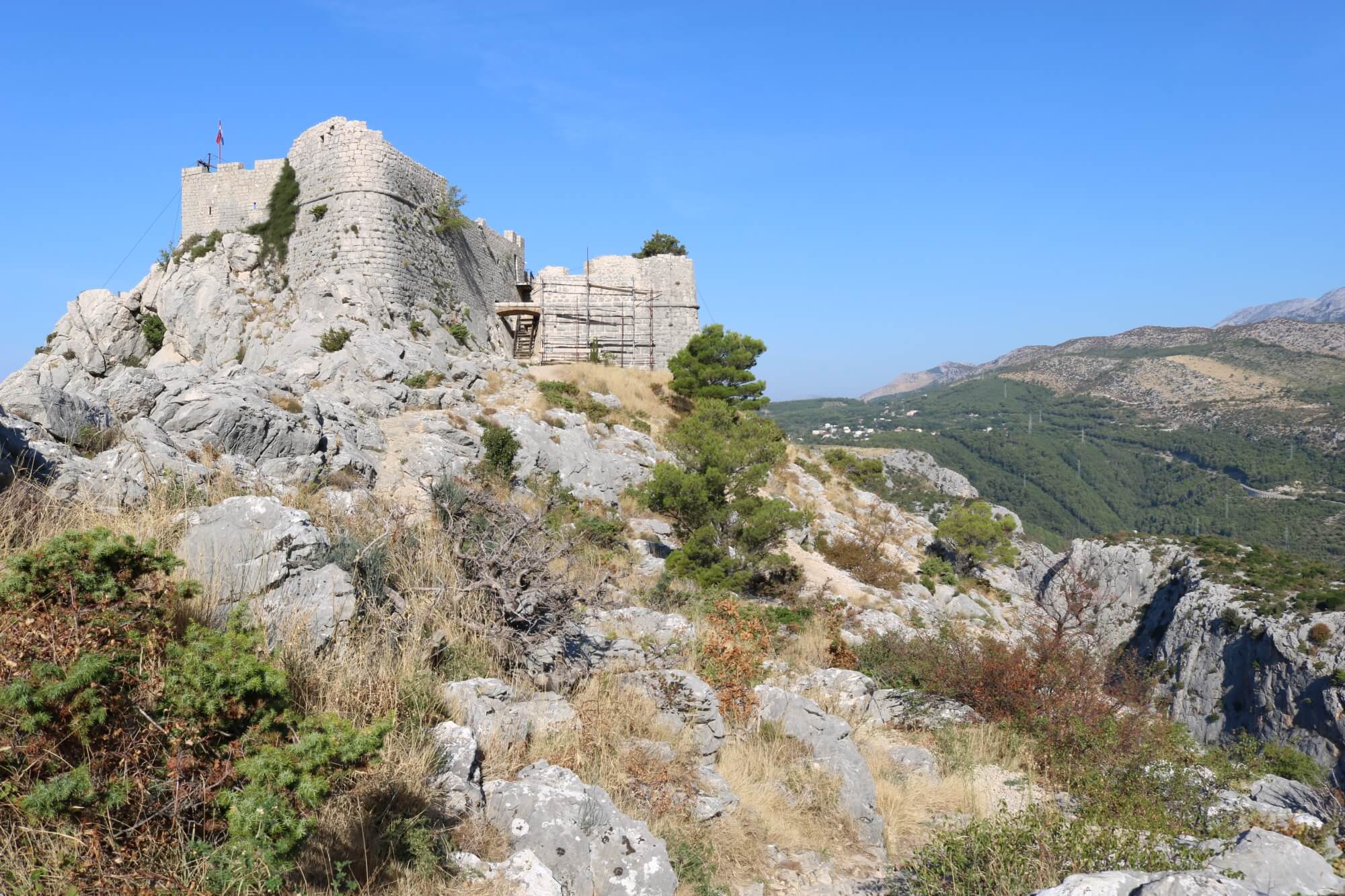
Sitting 262 metres above the city, the 15th century Starigrad Fortress is a mildly challenging hike. But, even older children can easily manage it. And the views from the top are incredibly rewarding. Autumn's cooling winds blow along the water surface, cleaning the vista. You can see so much detail on the islands opposite Omiš when the air quality is like this.
For those who prefer sport and recreation of a different kind, autumn in Omiš holds four of the city's most eagerly anticipated challenges
Omiš in Autumn: Dalmatia Ultra Trail
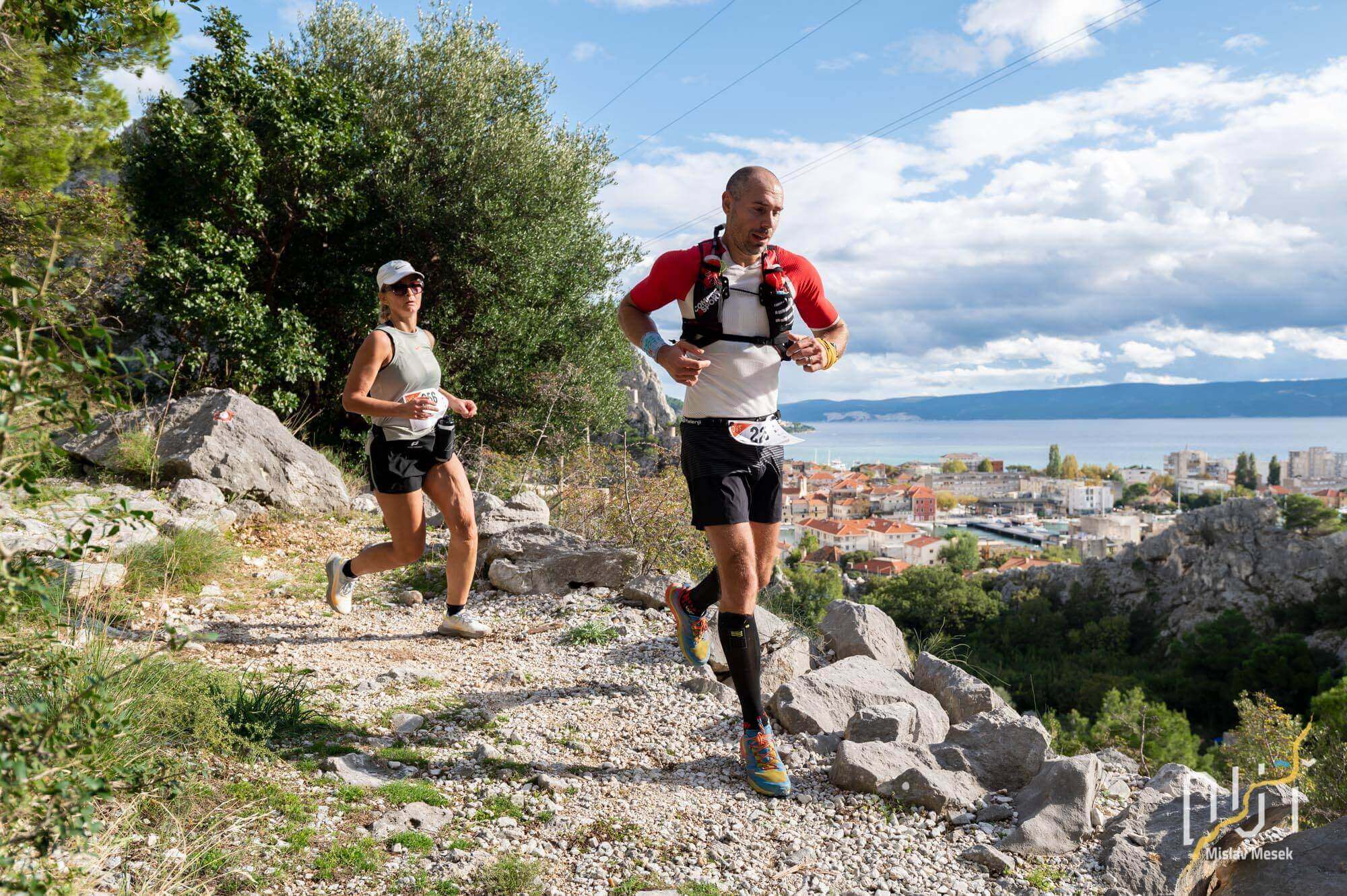 Omiš in Autumn © Dalmatia Ultra Trail
Omiš in Autumn © Dalmatia Ultra Trail
With between 60% and 80% of its entrants coming from overseas, Dalmatia Ultra Trail is among the most internationally famous of all Croatia's cross country runs. And for good reason. The scenery is spectacular. There are three route options, allowing the race to be accessible to runners of varying abilities.
Mountain Dut
Starting from the Roman town of Solin, just north of Split, Mountain Dut is the biggest challenge of this Dalmatia Ultra Trail. On a course with a total distance of 122 km, runners will ascend to Putalj and Klis, site of the famous fortress, crossing along the Dinaric Alps before dropping down to Gata in the Omiš hinterland. From there, they drop down into the spectacular Cetina river valley and run parallel to the river until Kostanje.
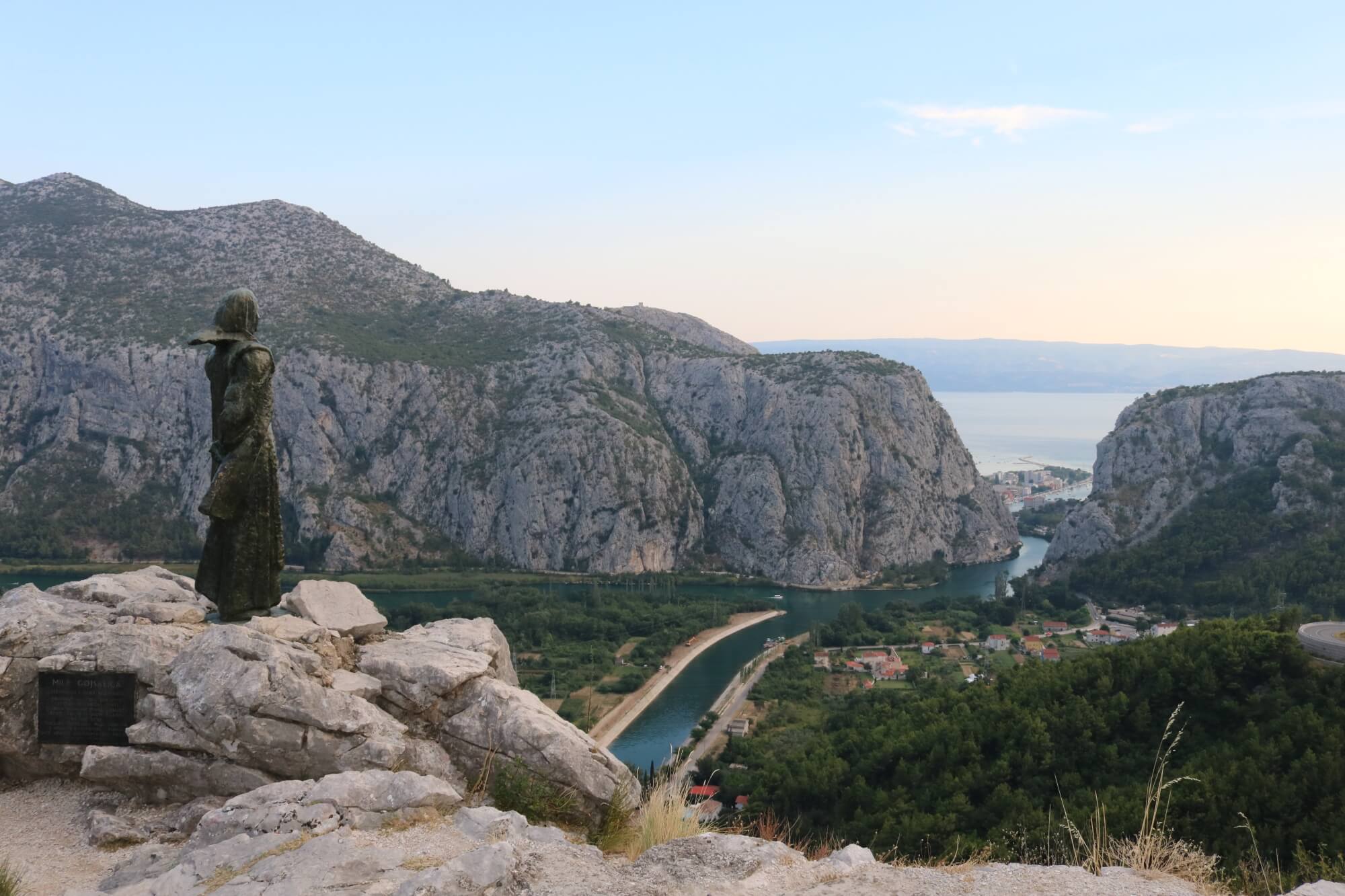
Returning up into the hills to visit the traditional village of Zadvarje, the trail next takes runners down to beautiful Brela. Runners will pass by beautiful Brela beaches, then those of the Omiš riviera villages Pisak, Marušići, Mimice and Medići. Then, it's back up to the final stretch of hills, visiting the old village of Lokva Rogoznica on the way, before finally descending to Omiš.
Mountain Dut 2021 starts on Friday 15th October at 9pm from Solin. Trail runners have 32 hours to complete the course. Each finisher will be awarded with 5 ITRA qualification points.
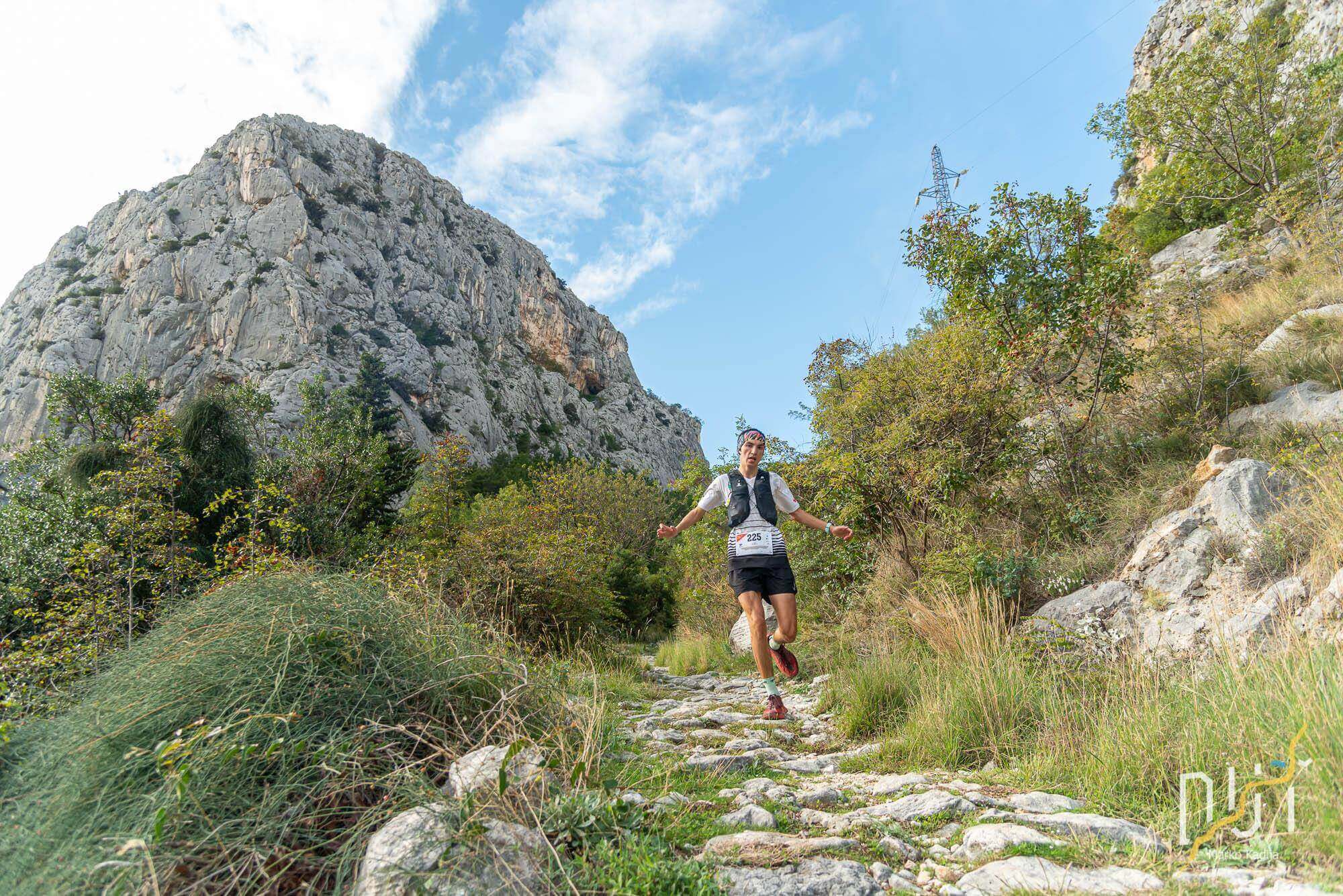 Omiš in Autumn © Dalmatia Ultra Trail
Omiš in Autumn © Dalmatia Ultra Trail
Sea Dut
At 56km in length, Sea Dut offers a challenging trail set before the entire Makarska and Omiš riviera coastline. Starting in Makarska, runners rise up to the village of Kotišina, famous for its botanical gardens and castle. Thereafter, they ascend Biokovo mountain, the trail reaching almost 875 metres above sea level. They stay atop the hills all the way to Brela, where they drop down to the beach. Thereafter, they take the same course as Mountain Dut, past Pisak, Marušići, Mimice and Medići, up to Lokva Rogoznica, then down to Omiš.
Sea Dut 2021 starts on Saturday 16th October at 8am from Makarska. Trail runners have 15 hours to complete the course. Each finisher will be awarded with 3 ITRA qualification points.
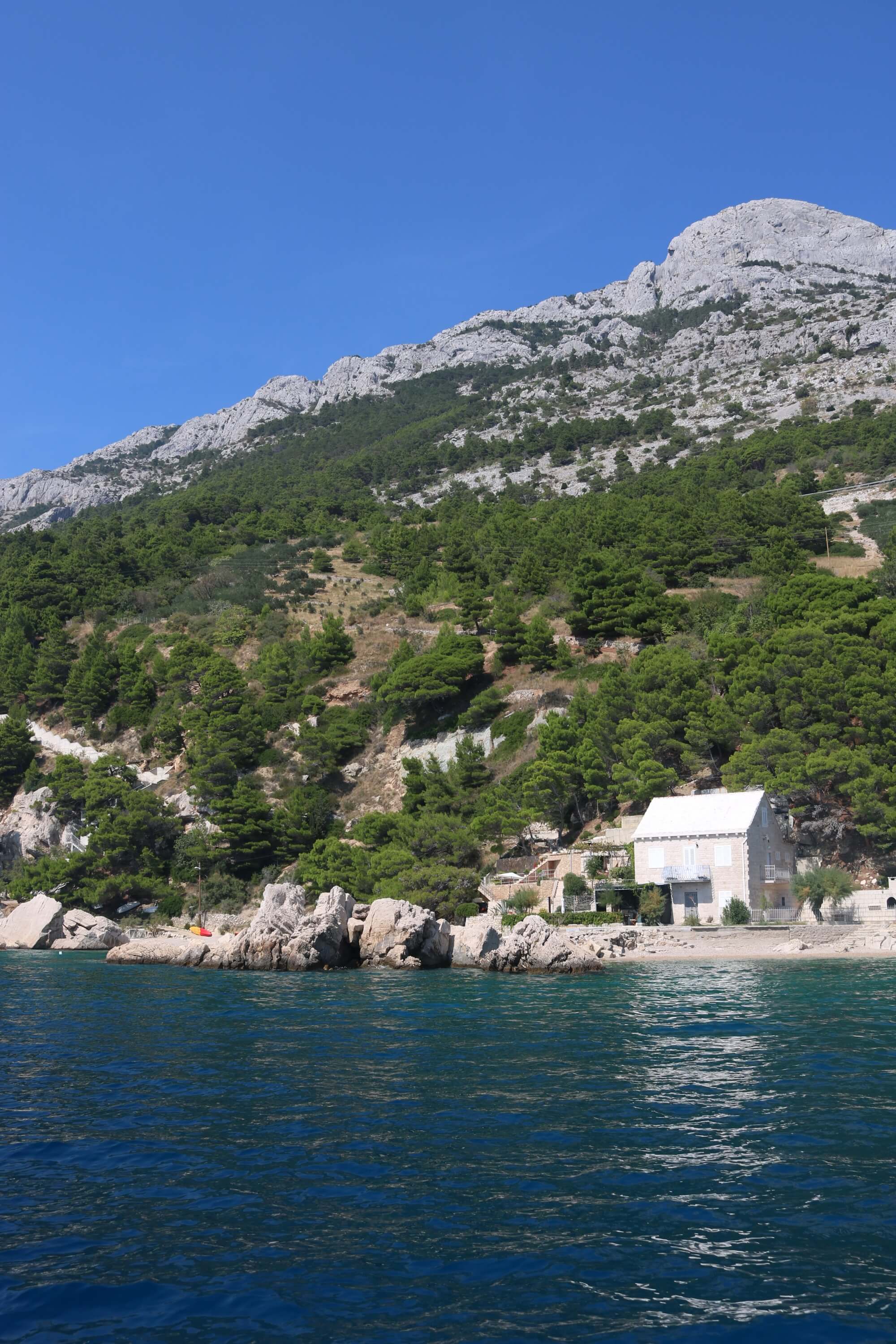
Ethno Dut
With a total distance of 18km, Ethno Dut is the most accessible of the Dalmatia Ultra Trails here. Starting in Dugi Rat, runners make a moderate ascent into the hills of just under 400 metres above sea level. They maintain roughly the same altitude for the entire trail, passing Jesenice and Tugare, before dropping down into Omiš.
Ethno Dut 2021 starts on Saturday 16th October at 1pm from Dugi Rat. Trail runners have 5 hours to complete the course. Each finisher will be awarded with 1 ITRA qualification point.
Omiš in Autumn: Omiš Half Marathon
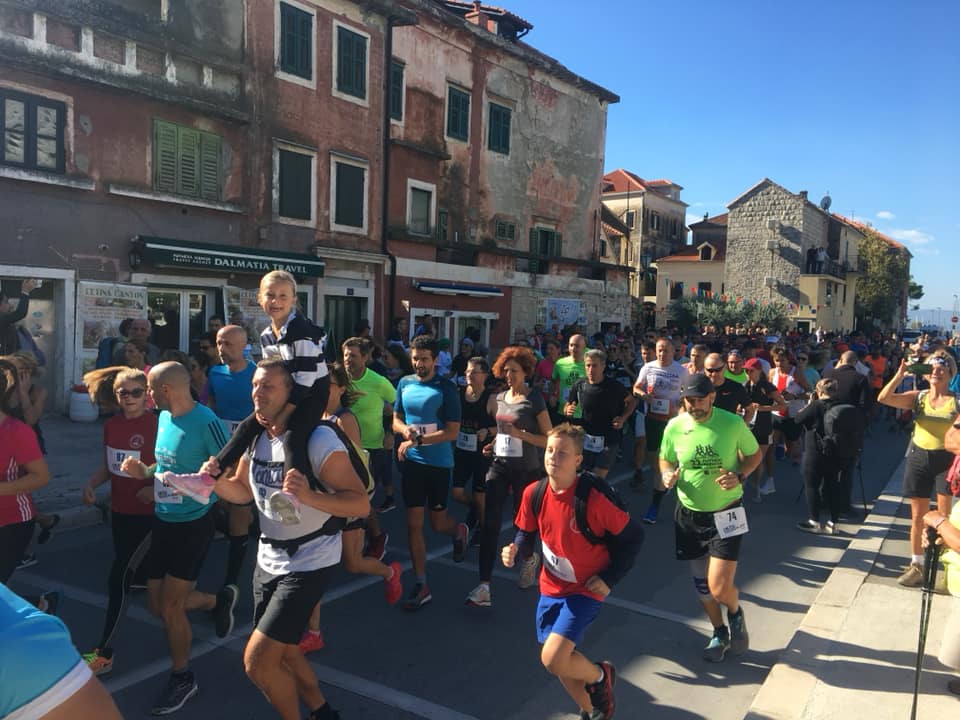 Omiš in Autumn © Omiš Half Marathon
Omiš in Autumn © Omiš Half Marathon
With a backdrop of mountains and the Cetina river, the half marathon in Omiš is perhaps Croatia's most spectacular. Where else can you run a virtually flat course with such scenery accompanying you?
Of course, the striking route is facilitated by following the Cetina river canyon. When doing so, runners pass some of the best rafting, kayaking, trekking, hiking and free-climbing locations in Croatia.
In 2021, the event again has two races - the half marathon and a recreational 6 kilometre race. Both take place within the Cetina river canyon.
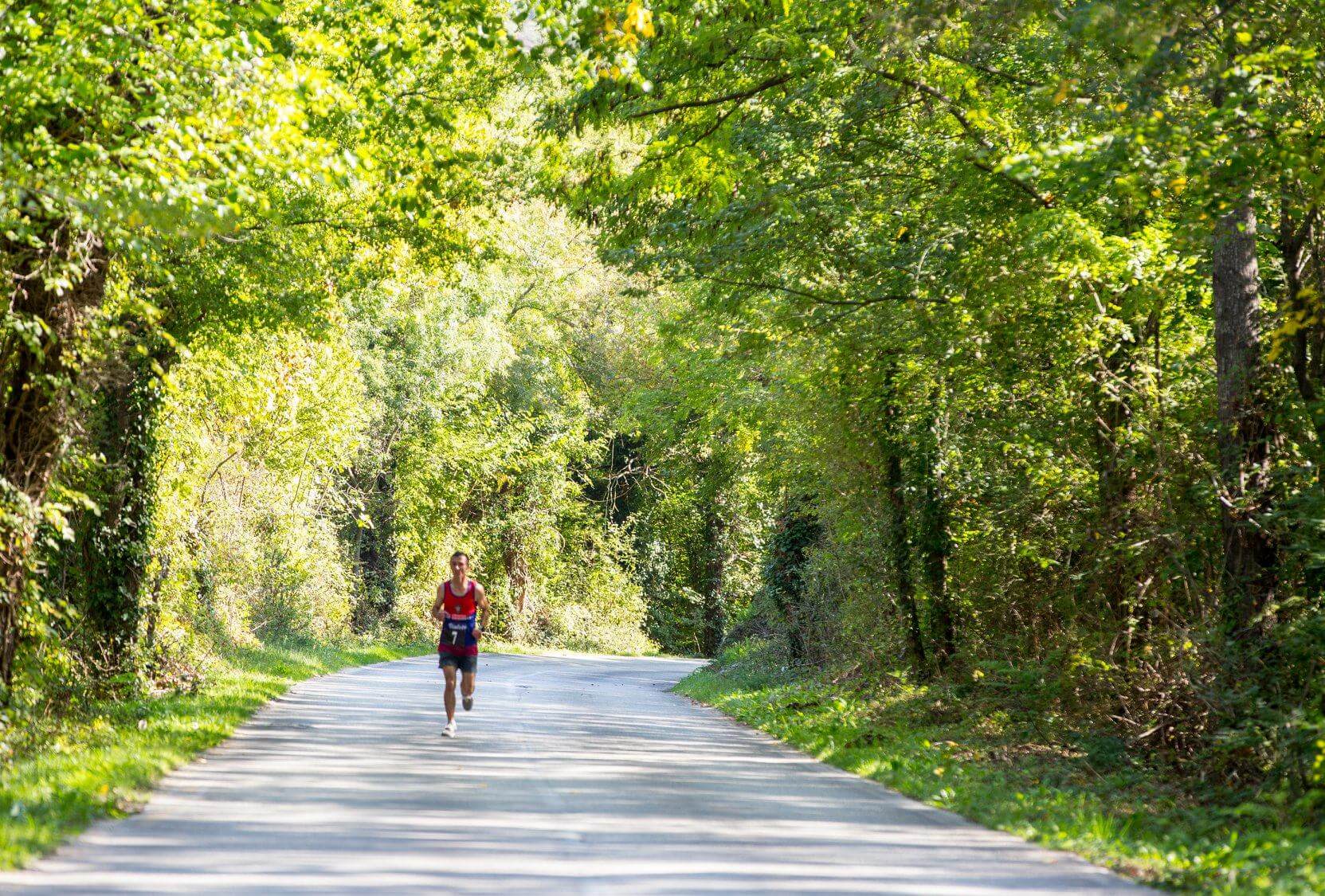 © Omiš Half Marathon
© Omiš Half Marathon
The Omiš Half Marathon takes place on Saturday 23rd October 2021.
You can register here and entries will be accepted in person between 8 am - 9 am on the day of the race. For more details, check the event's Facebook page.
UEFA Futsal Champions League 2021
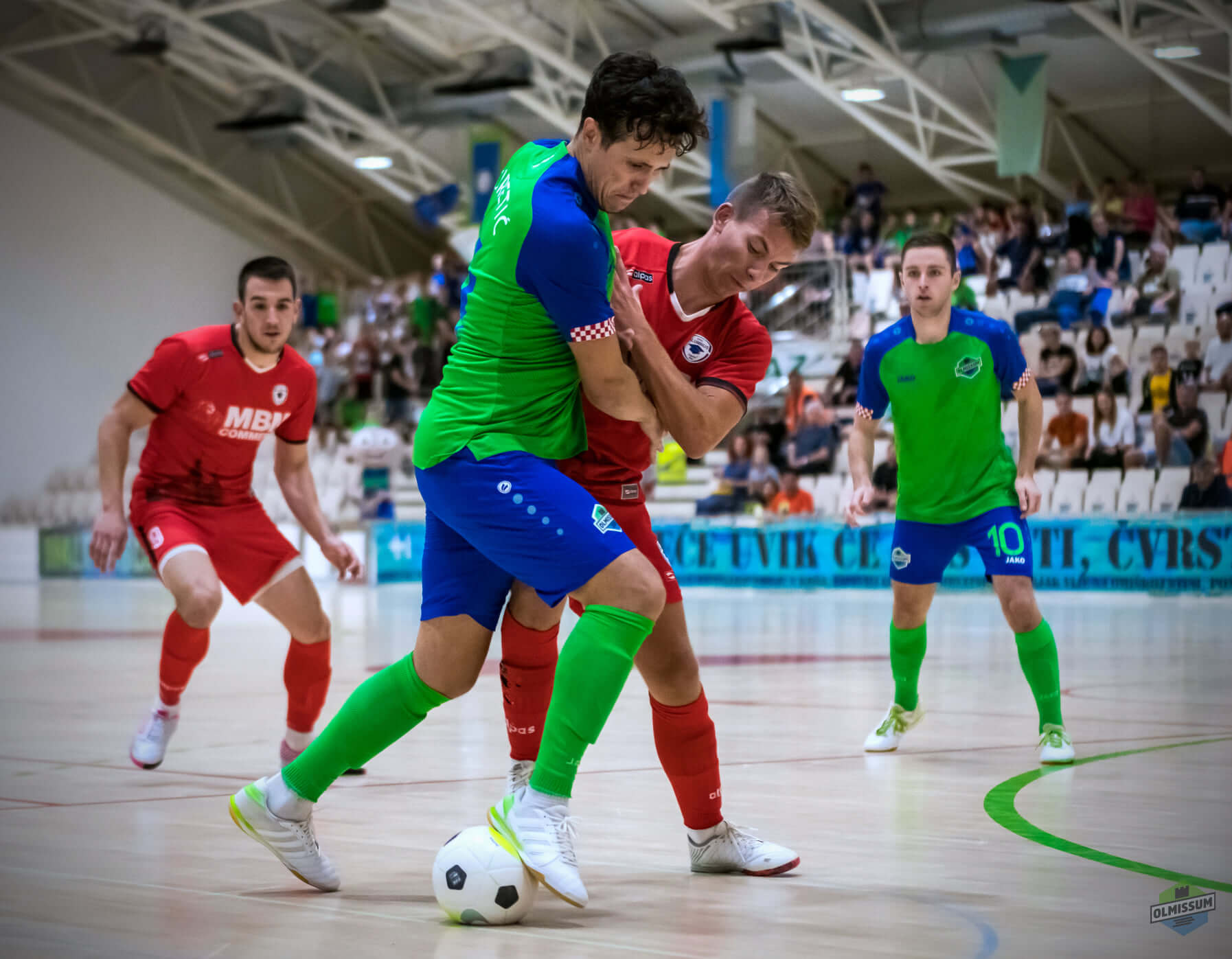 Zeleno Plavi © MNK Olmissum
Zeleno Plavi © MNK Olmissum
With the tournament celebrating its 20th anniversary in 2021, there's no better time for the Fifa accredited UEFA Futsal Champions League to be coming to Omiš. Better still, the hometown Futsal team, MNK Olmissum are the current national champions. They won both the cup and the league in the 2020/2021 season!
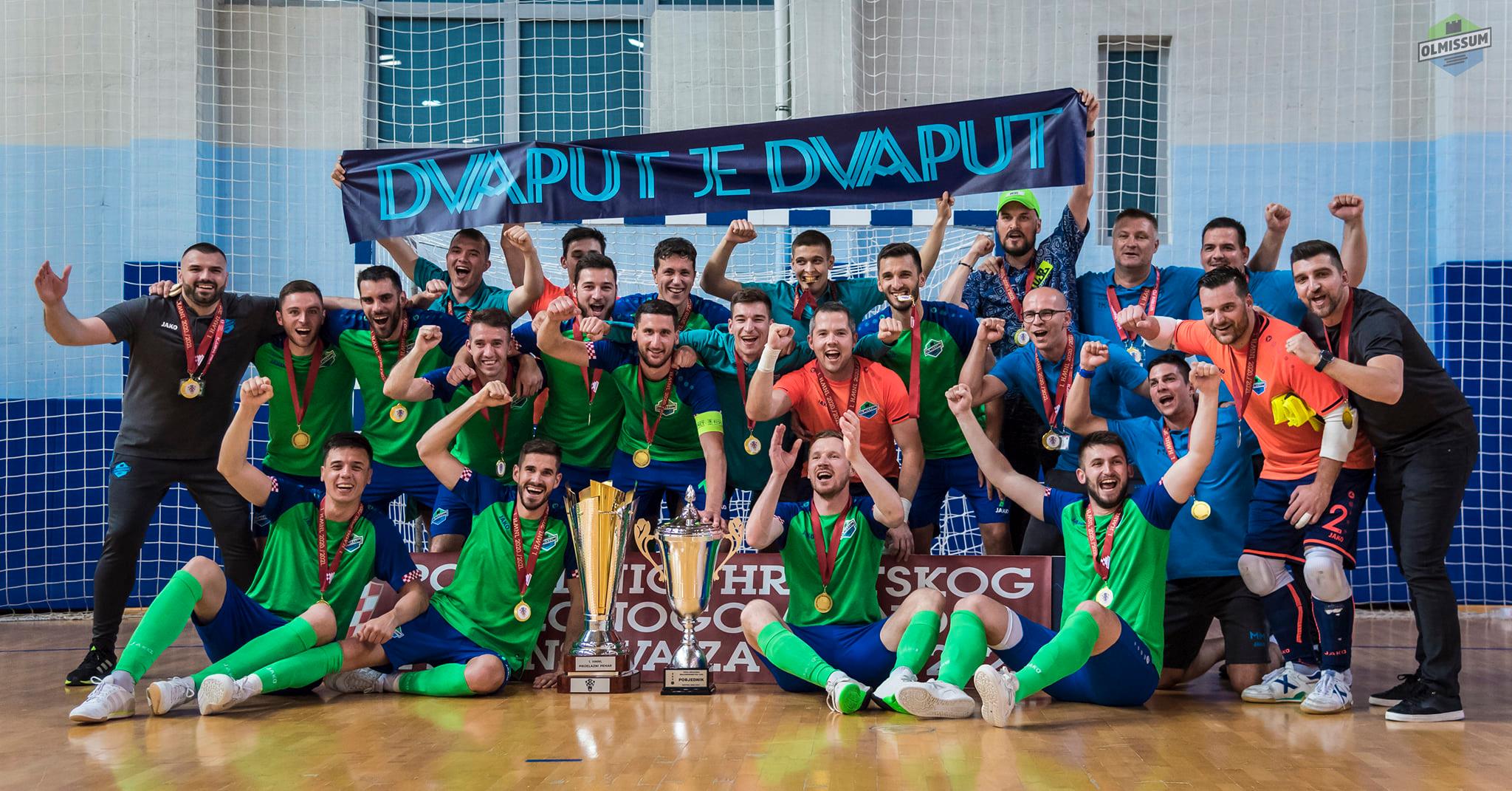 Champions! © MNK Olmissum
Champions! © MNK Olmissum
It's been two decades since a Croatian team reached the semi-finals of the tournament. Currently, MNK Olmissum are ranked within the top 16 of all European futsal clubs. To proceed in the competition, the hometown heroes will have to come top of their group. They face opponents Leo (Armenia), Diamant Linz (Austria) and KMF FON (Serbia). They will host the group at their home ground of Ribnjak, Omiš between October 26 and 31. The matches will be televised, but what better way to enjoy than in-person?
Omiš in Autumn: Dalmatian Trail League - Mosor Grebbening
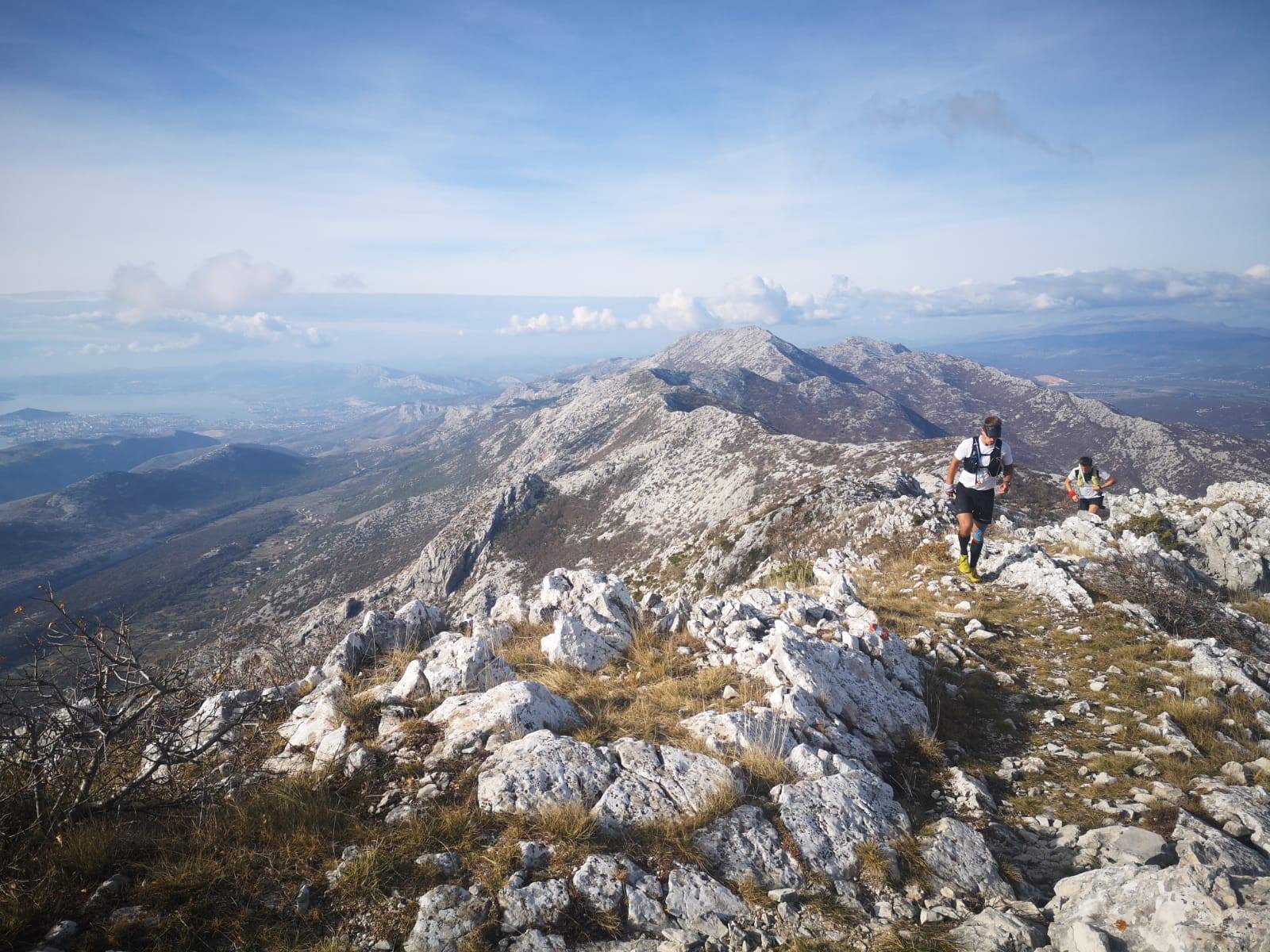 © Marko Herman
© Marko Herman
The spectacular section of the Dinaric Alps that lies to the west of Omiš is known as Mosor. It starts near Klis, above Split, and runs to the Cetina river. Mosor Grebbening is a series of trail runs through this epic mountain terrain. In 2021, it is the 9th round of the famous Dalmatian Trail League.
The event contains a choice of three adult trails and one children's race. All of the races start or end in the village of Gata, in the Omiš hinterland.
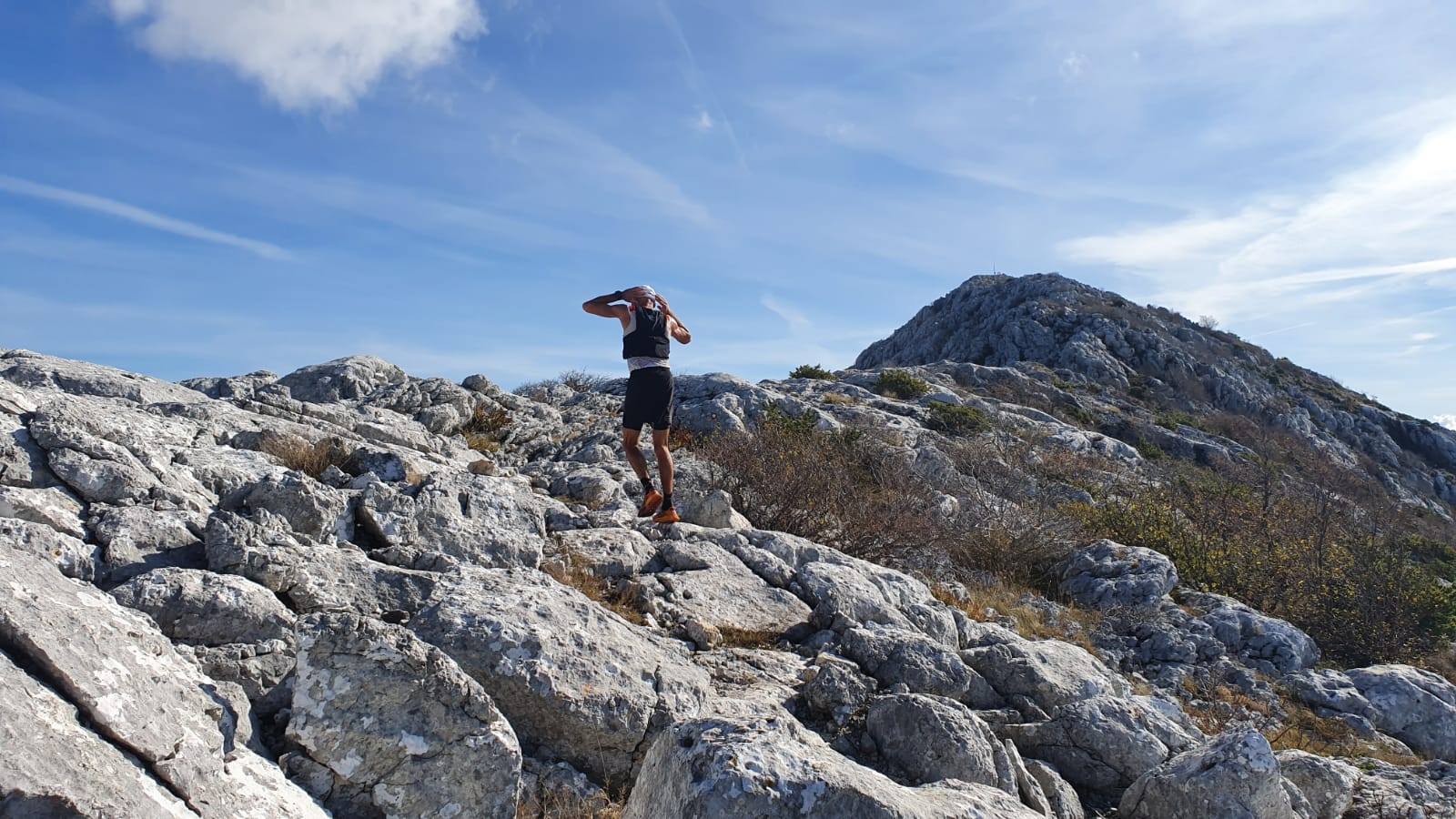 © Ivo Pešić
© Ivo Pešić
Starting in Klis and finishing in Gata, Sivonja is the toughest trail. It is 37.50km in length and has a 2590m ascent. Runners have 12 hours to complete the course.
Still a tough ask, Tovar is the slightly easier choice. At 17km and with an ascent of 1270m, you're given 8 hours to complete the trail.
At 8 kilometres in length and with a 400 metre ascent, Pule is the most accessible race. It should take way less than the 4 hours allocated. The children's race is an 800 metre dash around Gata.
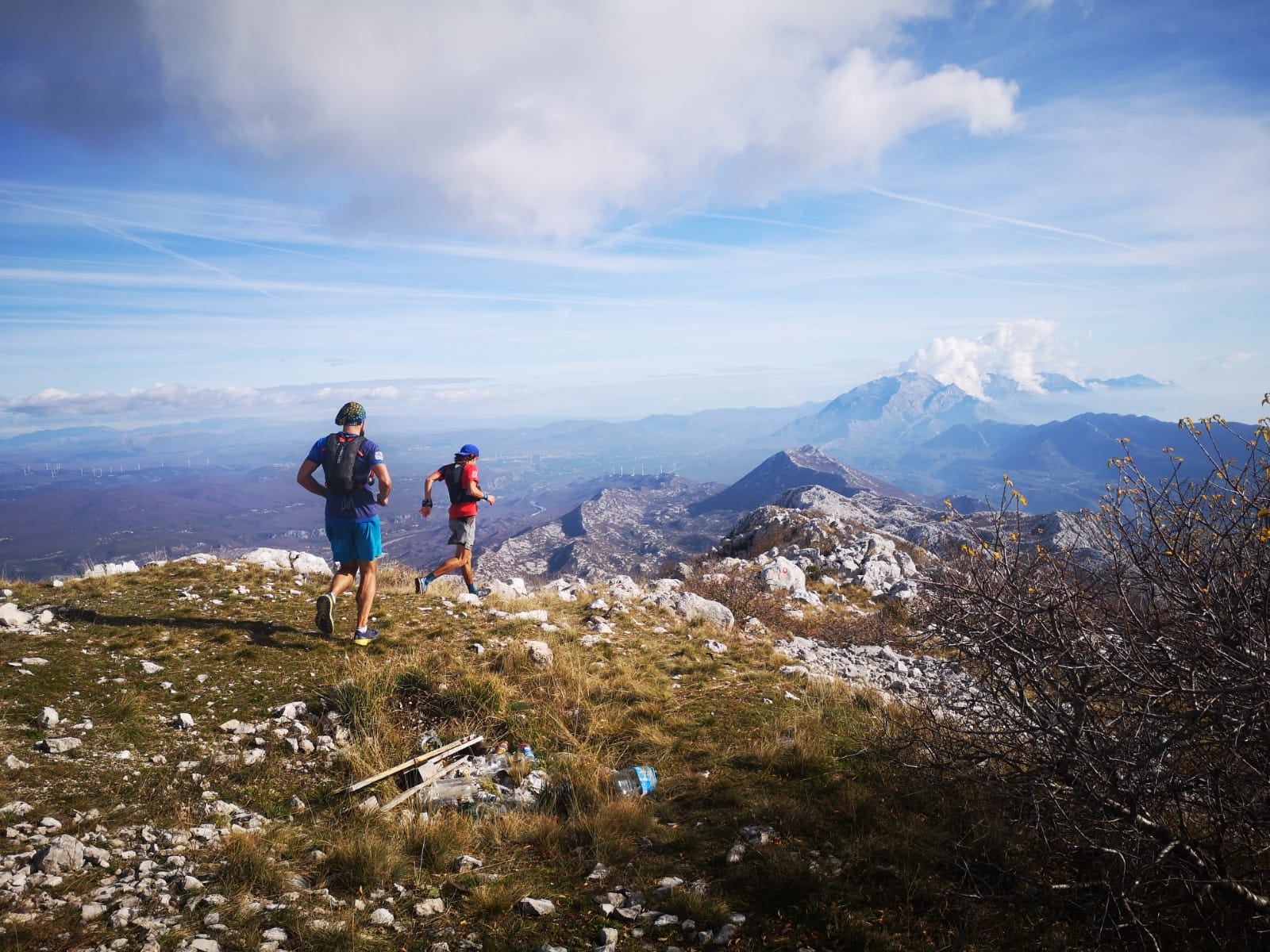 © Marko Herman
© Marko Herman
Mosor Grebbening takes place on Saturday 13 November 2021.
Registration for the races: exclusively via the online registration form here.
Taste the Mediterranean: A Day of Exploring Traditional Croatian Gastronomy in Omiš
October 9, 2021 - To promote Split and Dalmatia as a leading Mediterranean food, wine, and travel destination, the Taste the Mediterranean Festival headed over to Radmanove Mlinice, Arsana Tasting House, and Cetina river canyon for an authentic experience of Croatian Mediterranean identity and traditional Dalmatian gastronomy.
The TTM Festival is finishing strong. For the last day of the 4-day festival, the participants departed from Briig Boutique Hotel in Split at 9:30 am and arrived safely in Omiš and were received by Arsana Tasting House. There, they were greeted with traditional food and wine including soparnik, prosciutto, and Dalmatian wines Pribidrag from Vinarija Mimica and Debit from Vinarija Ante Sladić.
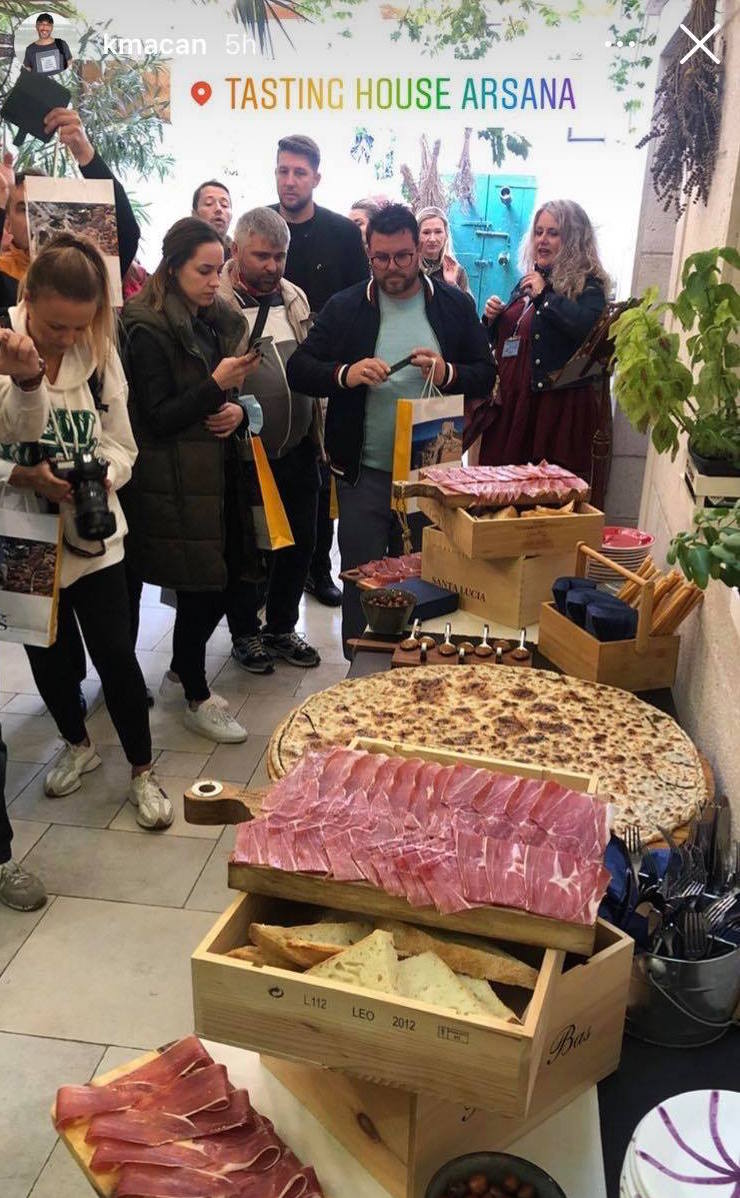
Naturally, visiting Omiš would not be complete without exploring the Cetina river. The gloomy weather did not stop the guests from having a wonderful time in one of the most beautiful attractions in Dalmatia - the beautiful canyon of the Cetina river. "Even the rain couldn't spoil the spirit of our chefs", said one of the event coordinators.
To fully experience the rich history of Dalmatian cuisine, TTM headed over to the famous restaurant Radmanove Mlinice where they were treated with traditional Croatian food from appetizer to dessert. The menu consisted of fritule (Dalmatian fritters), fried frog legs with tartar sauce, salted and marinated anchovies, olives, and white-wine braised octopus with olive oil, garlic, and parsley. Since a traditional Dalmatian meal would not be complete without serving peka, the restaurant served veal "peka" (under the lid) with potatoes and salad as this afternoon's special main course. Radmanove Mlinice also showed the invited guests and chefs how traditional homemade bread is prepared using peka.
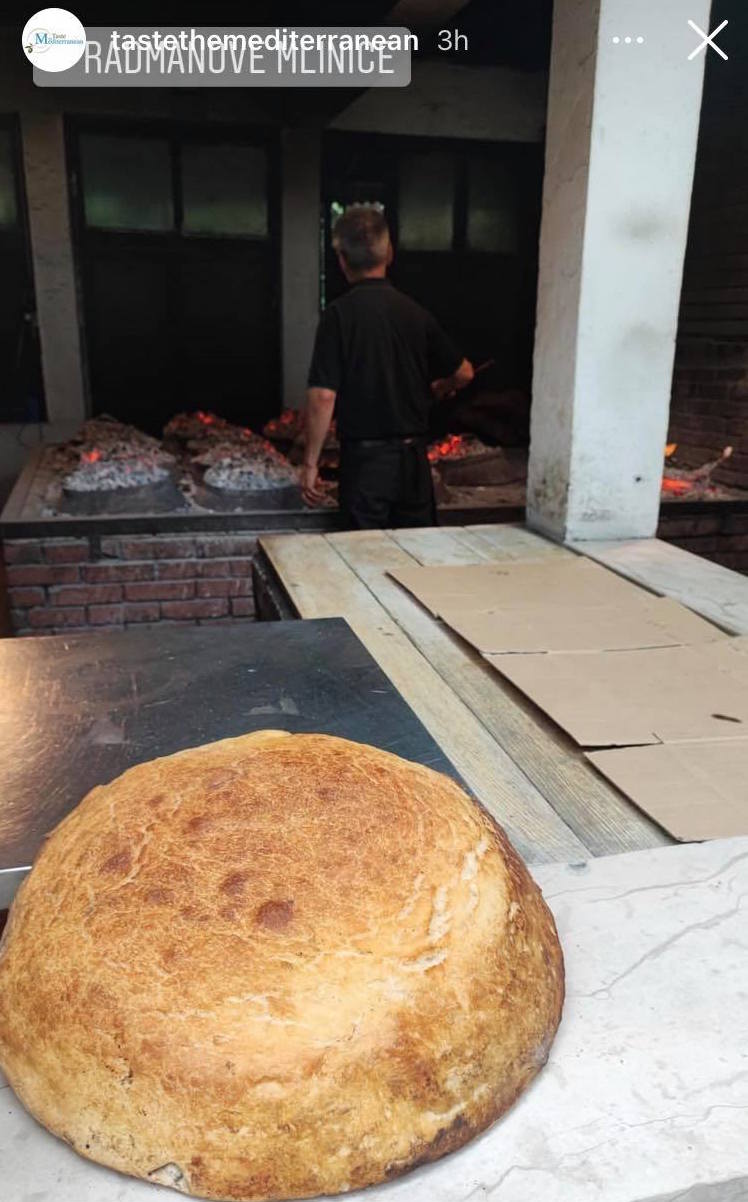
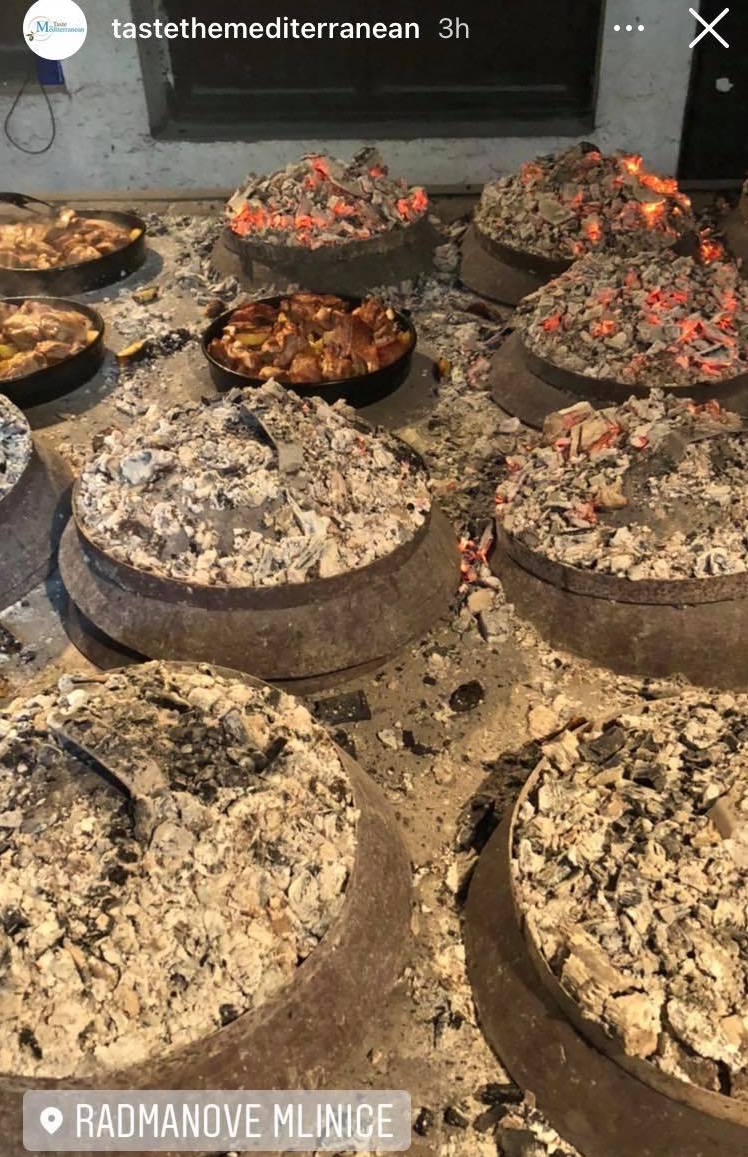
Since two of the main goals of the TTM festival are the exchange of experiences with other Mediterranean countries and education for students and professionals in the hospitality and restaurant industry, chef Ippei Uemura of Tabi Restaurant, Marseille, who won the Young Talent of the Year Gault & Millau France also conducted a masterclass for the students of Jure Kaštelan High School in Omiš.
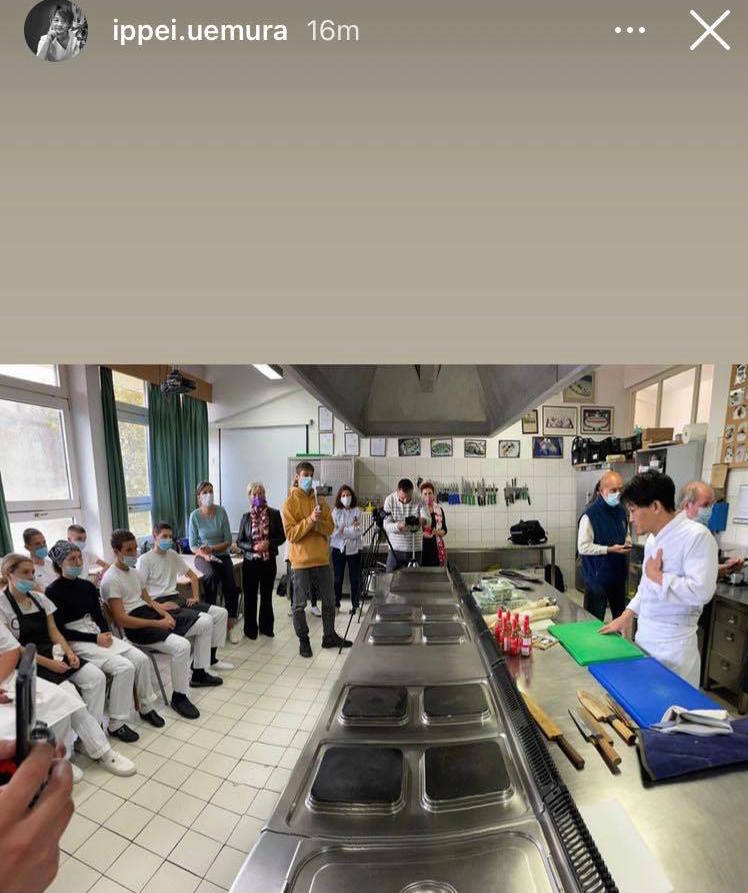
After a fun day outside of Split, the TTM Festival team returned back to Split to prepare for the last part of the programme which includes exclusive dinners in restaurants Zrno Soli which will be hosted by chef Stjepan Vukadin and Zora Bila which will be hosted by Chefs Sandra and Dane Tahirović. The exclusive dinner specials of TTM Festival were proven to be a hit and were enjoyed by all attendees.
Also as part of the Taste the Mediterranean festival, the Split Restaurant Nights runs until tonight. This event offers tourists and locals special 3-course Mediterranean-Dalmatian menus including wine which is offered at promotional prices in 15 participating restaurants. The restaurants include Restaurants Atlantida, Bajamonti, Brasserie on 7, Bokeria, Corto Maltese, Dujkin dvor, Fantažija, Konoba Fetivi, Konoba Marul, Laganini, Mazzgoon, Pandora Greenbox, Portofino, Sidi bar and Šug.
For more on lifestyle, follow TCN's dedicated page.
For more about Croatia, CLICK HERE.
Construction of €11.6m Harbor in Omiš to Start in Mid-September
ZAGREB, 22 July (Hina) - The construction of a town harbor in Omiš, east of Split, will begin in mid-September, and the implementation of this HRK 87 million project will take three and a half years.
The document signing ceremony for the launch of the project was held in Omiš on Thursday.
In attendance was Sea and Transport Minister Oleg Butković, who said that 85% of the costs of the project would be covered by funds from the European Union.
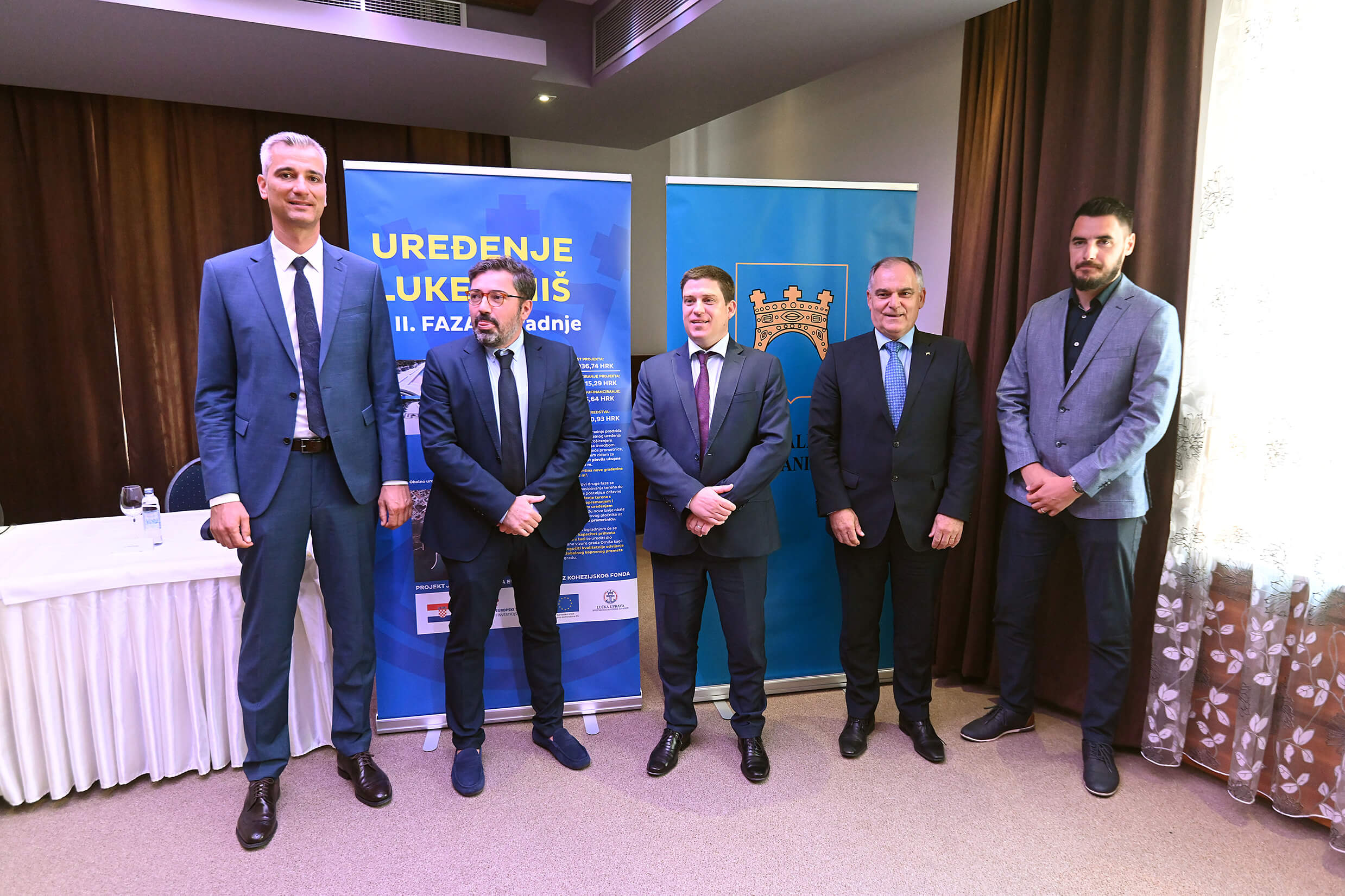
HINA/Mario Strmotić
The project includes building a primary breakwater and a new promenade, and a new traffic solution.
Currently, about HRK 2 billion is being invested in the projects concerning seaport infrastructure along the coast, a record high investment in this segment in the last 100 years, the minister said.
He commented on efforts to ensure a smooth traffic flow from Solin via Split to Omiš, a route that experiences traffic congestion in the summer, saying that this would also be one of the main Croatian projects in the new EU financial perspective.
The head of the Split-Dalmatia County Port Authority, Domagoj Maroević, said that the new project would provide Omiš with an additional 8,000 square meters of seafront plus 70 berths, as well as space for boats owned by locals.
Mayor Ivo Tomasović said this was a historic day for Omiš, stressing that the new harbor will also enable a connection between Omiš and the nearby islands.
For more news about Croatia, click here.
Unique Experience of Working "From Home" - in Croatia: Seaside Offices
May 3, 2021 - German Alexandra Horvat is behind the idea that offers her clients a unique experience of working "from home" -- in Croatia, intended for those wishing to replace their home office during lockdown with an apartment with a sea view.
"Sitting at the computer for hours on end is different when you can see the endless blue of the sea behind the monitor", said 28-year-old Norman Bertram who swapped his Hannover office for one in Marušići near Omiš.
"This is wonderful, I've been here for four weeks. Since Germany is in a complete lockdown, it is very relaxing to just sit here and watch the sea every day, regardless of the job. What I like most is freedom of movement and having everything close by. Yesterday, I went down to the beach, sunbathed a bit and had a swim", say Norman.
The woman responsible for making such an experience possible is Alexandra Horvat. After she had decided to move from Germany to Croatia, she put together what Croats have in front of their noses but don't appreciate enough.
"In these times of coronavirus, the concept of a non-classic office is what many need. I have seen for myself how staying here has had a positive effect on me and my family, so I thought: why not turn it into a project everyone would benefit from? I firmly believe this is something that will take off also after COVID, because the future is in mobile business, when work and leisure will be closely linked", Alexandra said.
It didn't take long from the idea to its realisation. She bought a house in Mimice, contacted local renters, who recognised the benefits of the project. In order not to leave the apartments empty out of season, they offer them at a lower price, and Alexandra and her team are in charge of office equipment, which they install on site, and of the entire logistic support, including food, excursions, wellness, doctors and anything else guests might need.
The most important thing is that young people get the opportunity to work, learn and progress, Alexandra Horvat says, noting that after moving she first noticed a lot of young people without prospects who only think about leaving Croatia. She wanted to show that conditions for a decent life can be created everywhere with a little will and effort, especially when it comes to the IT industry.
She thinks that for a small local community such as the one in Omiš, where she decided to establish her base, employing five young people is a big deal.
That the concept is successful is confirmed by inquiries and bookings from companies and independent clients not only from Germany but also from the USA, Ireland, Austria, the United Kingdom, Norway and Russia. How everything will develop depends on each country and the restrictions currently in place there.
If you want to know more about Omiš, be sure to check Total Croatia's guide HERE.
For more about lifestyle in Croatia, follow TCN's dedicated page.
Visit Omis: The Summertime Holiday Winter Dreams Are Made For
17 December 2020 – Missing adventure, escape, breathtaking landscapes and unspoiled nature? Visit Omis in 2021 - with 20 kilometres of perfect beaches and crystal-clear seas, the mighty Cetina river and an atmospheric Old Town, it's the summertime holiday that winter dreams are made for.
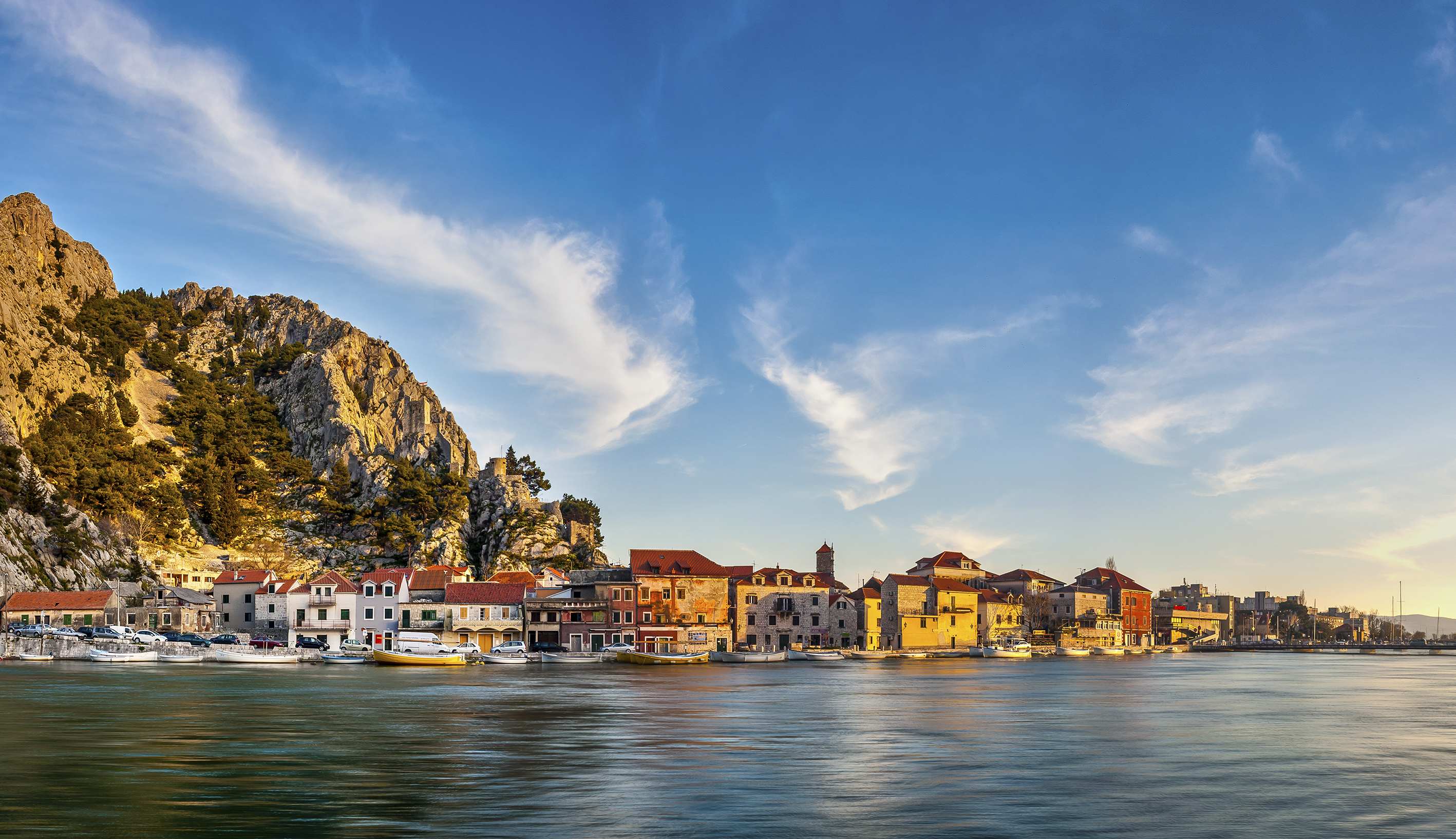 The pretty pastel shades of buildings in Omis contrast beautifully against the sheer, grey, karst rock which rises sharply behind © Omis Tourist Board
The pretty pastel shades of buildings in Omis contrast beautifully against the sheer, grey, karst rock which rises sharply behind © Omis Tourist Board
The cold outside is often reason enough to spend most of winter indoors. It's a good time for wrapping presents or even wrapping yourself in blankets. Perhaps, if it snows, you'll sit by the window, daydreaming. With a chill in the air, there's no better dream than that of next summer. In the warmth of the summer sun, you can forget all about those blankets and staying indoors. It's time for escape, adventure, the great outdoors, to hit the beach and to swim in the sea.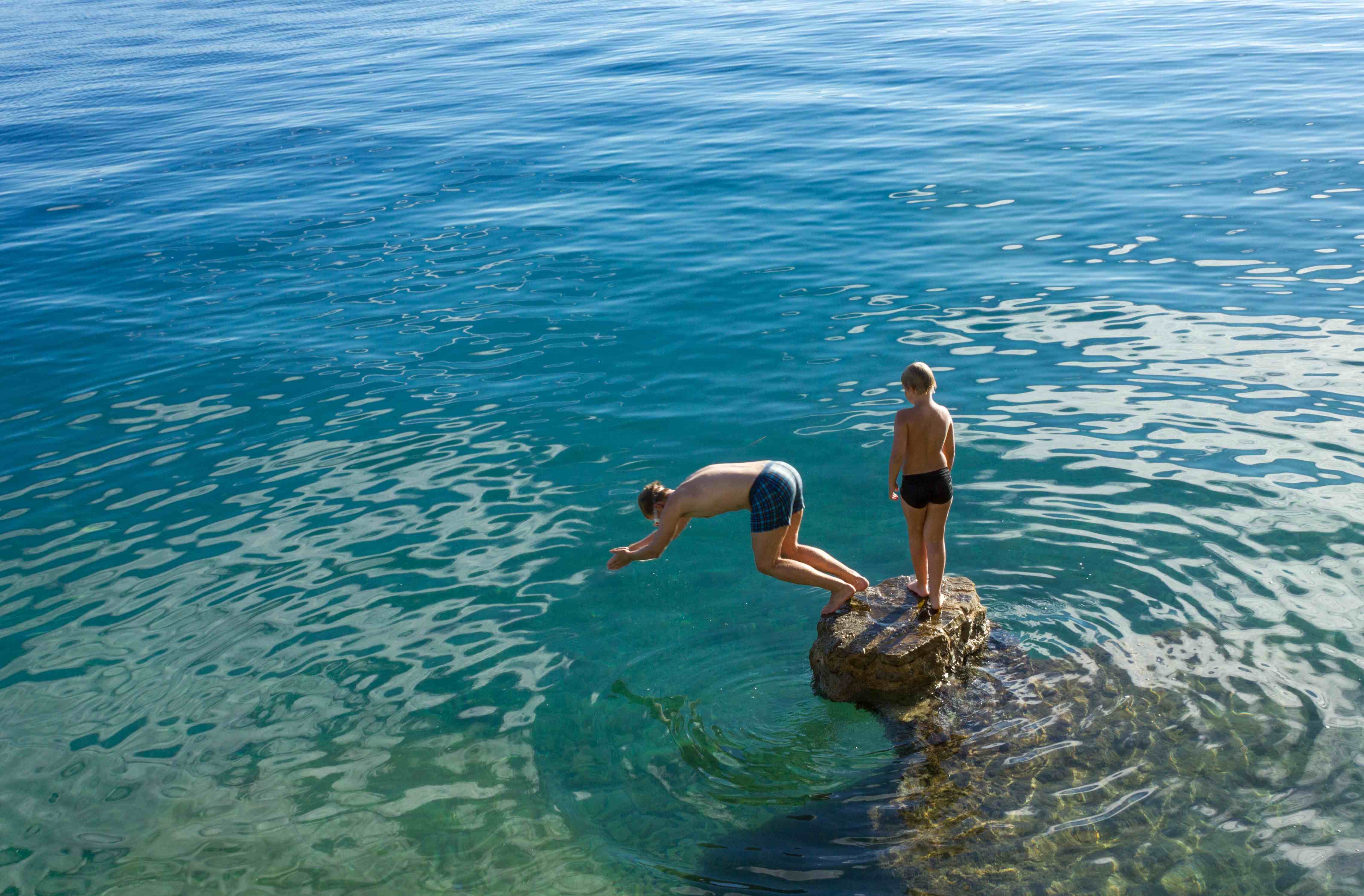 Crystal-clear waters run along the length of the Omis riviera © Omis Tourist Board
Crystal-clear waters run along the length of the Omis riviera © Omis Tourist Board
In 2021, the City of Omis will once again welcome winter's dreamers. From Springtime to October, visitors will come and enjoy its extended summer, many of them returning as they do every year. Because, once you visit Omis, there really is nowhere else that can match its incredible offer.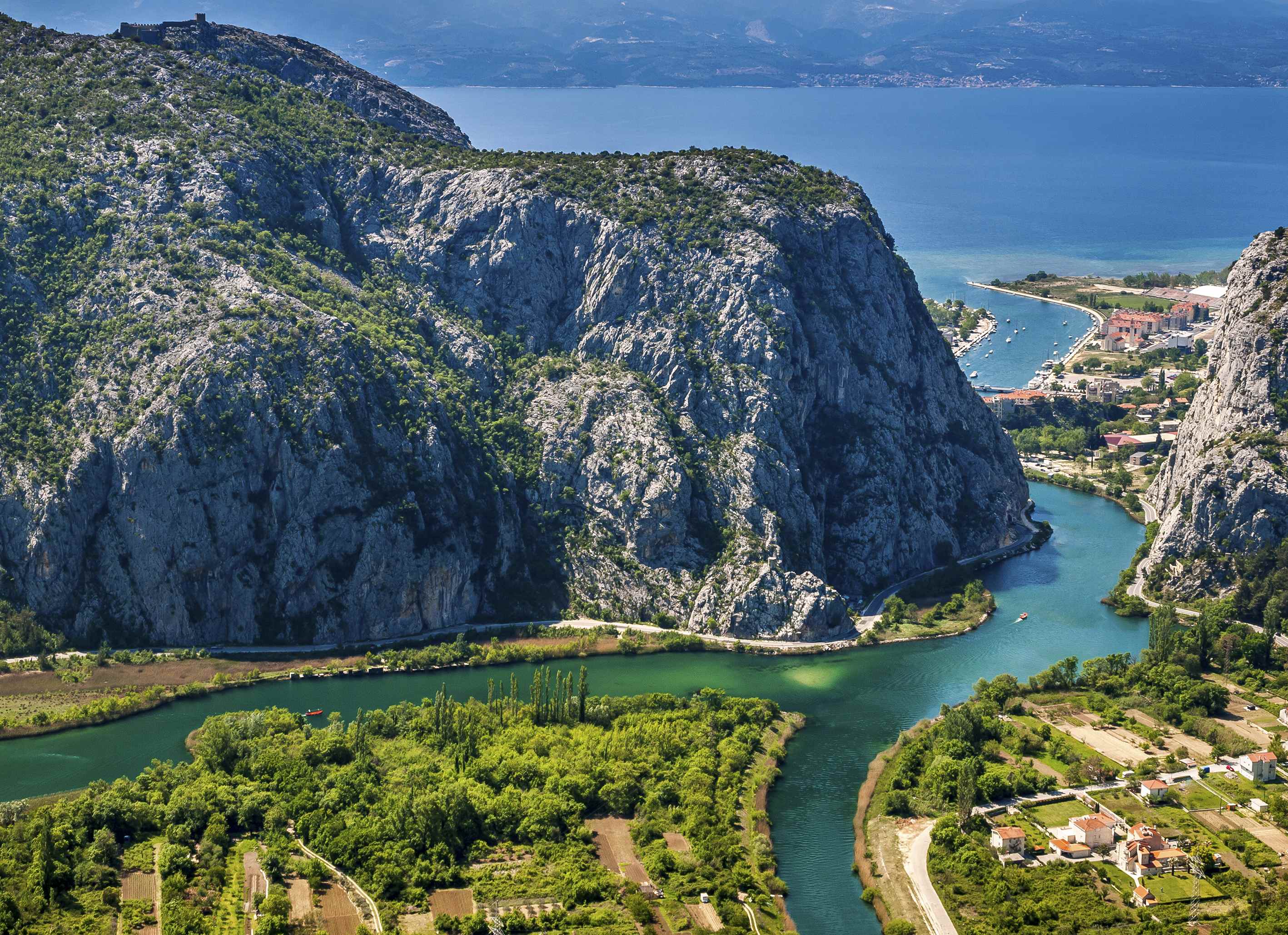 A spectacular landscape, with the lush Cetina river valley cutting through the Dinaric Alps to flow into the sea at Omis - you can see the island of Brac in the distance © Omis Tourist Board
A spectacular landscape, with the lush Cetina river valley cutting through the Dinaric Alps to flow into the sea at Omis - you can see the island of Brac in the distance © Omis Tourist Board
The unique experience when you visit Omis is a product of a singular history and geography. Standing on the mouth of the Cetina - the largest river in Croatia to drain into the Adriatic – Omis and its surrounding riviera is not only filled with pristine and peaceful beaches, it also has waters that, for hundreds of years, have connected the city far into the hinterland. When you visit Omis, it is this riverside positioning that gives its unmissable adventures, culture, heritage and nature.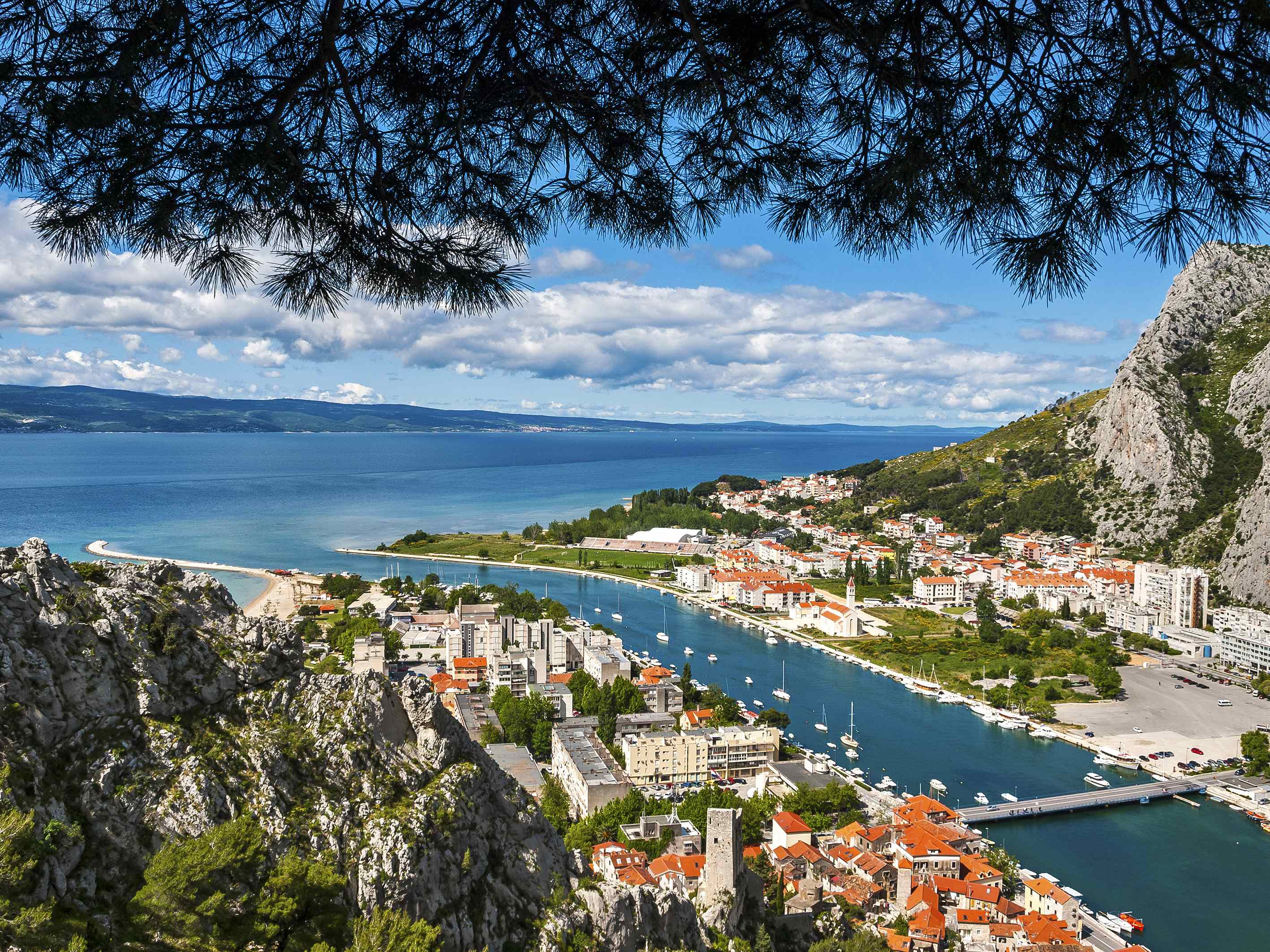 The Cetina river is the largest to flow into the Adriatic in Croatia and helps give Omis a truly unique offer © Omis Tourist Board
The Cetina river is the largest to flow into the Adriatic in Croatia and helps give Omis a truly unique offer © Omis Tourist Board
Omis has been inhabited since at least Roman times. Today, the winding, narrow streets of its Old Town are a pretty promenade with a distinctly Mediterranean atmosphere. Walking down these stone-paved pathways, intriguing architecture built over centuries is revealed – an unexpected city square opens up, seating drinkers and diners. Above them, the walls of an ancient church and beyond, the spectacularly lit Mirabella fortress that stands impressively above the town. You can easily walk to the top and look over the Old Town and river or, by day, take the path further back, up to the 15th century Starigrad Fortress. Its walls are renowned to hold one of the greatest views in Croatia, the island of Brac dominating the skyline, further still, the island of Hvar. Both can be toured by boat on day trips when you visit Omis.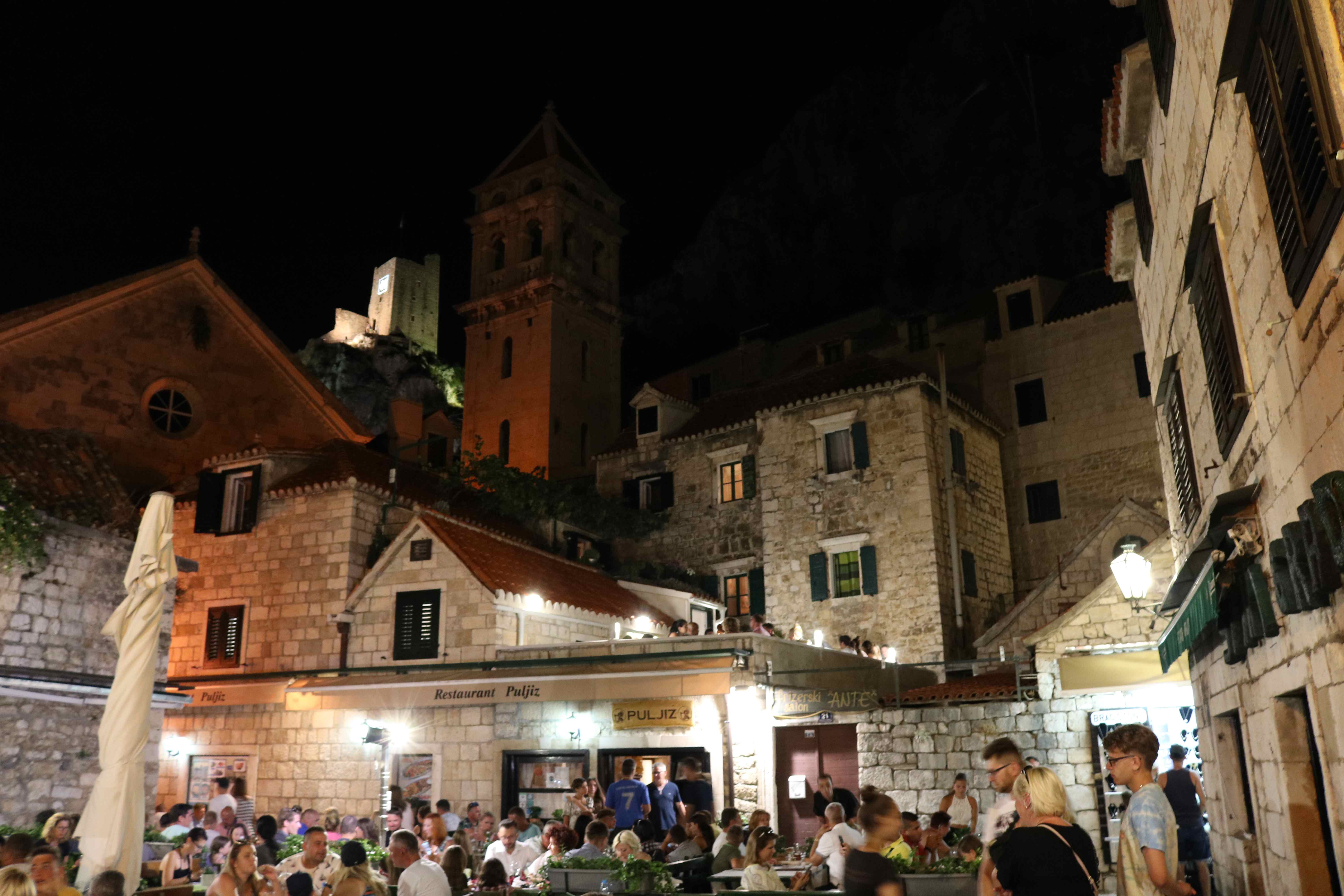 The atmosphere-filled Old Town of Omis © Marc Rowlands
The atmosphere-filled Old Town of Omis © Marc Rowlands
Besides venturing out to sea by boat, taking to the waters of the Cetina river is the best way to get the most from the unique offer when you visit Omis. You can kayak from the town into the nearest sections, watching as the pastel shades of Omis buildings are replaced by the towering, epic cliffs of grey karst rock, sometimes dotted with brave and experienced free climbers. Then, suddenly, the river widens to become flanked by reeds, then fields and trees. Birds sit atop the water or fly overhead, fish dart below you in crystal-clear waters, insects and frogs can be heard coming from some hidden place. The whole landscape seems alive, yet silent except for the sounds of nature – you can't hear a single car engine, not the buzz of an overhead cable, only the dipping of your oar in the calm waters.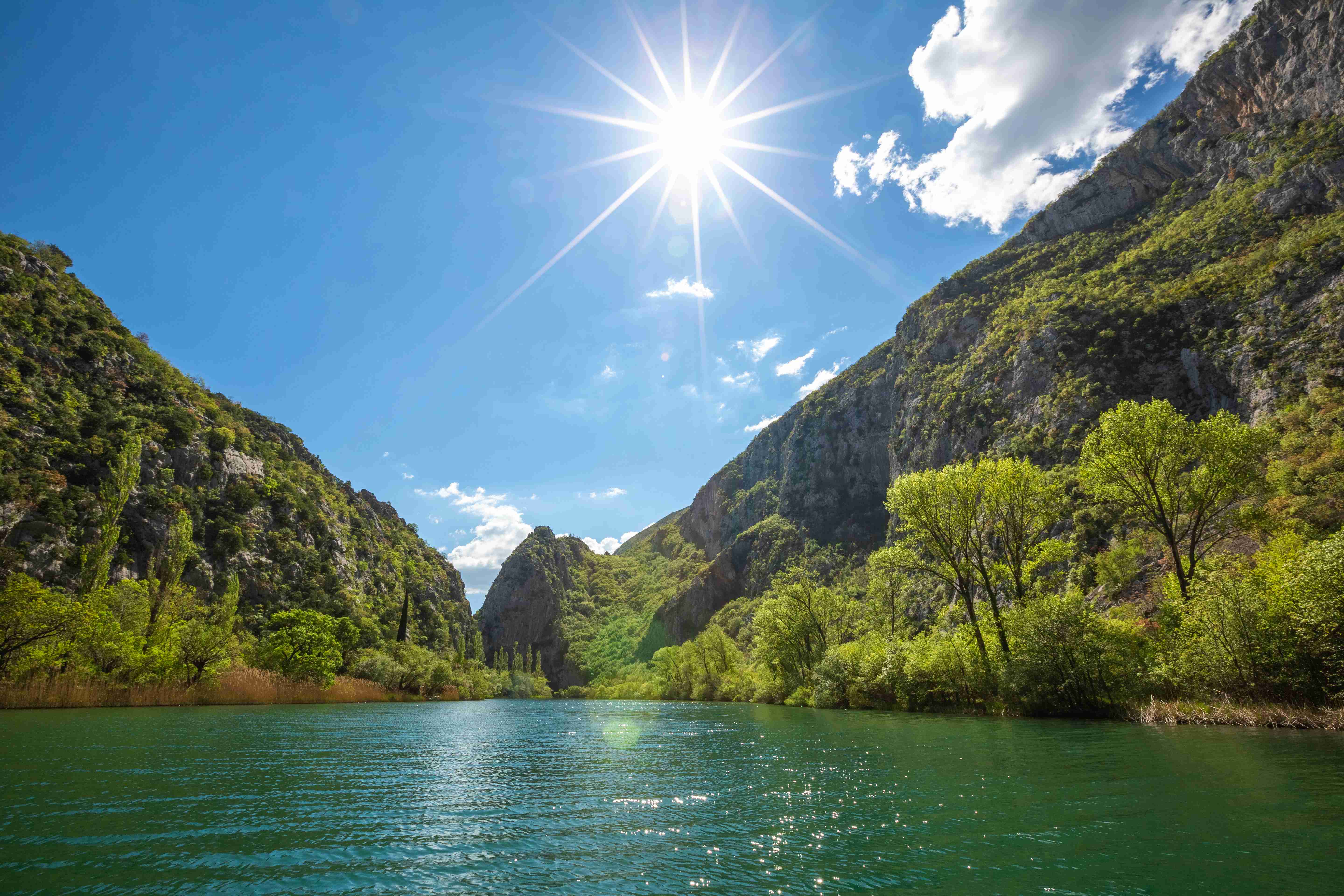 The still and silent Cetina river valley near Omis, perfect for kayaking and reconnecting with nature © Samir Kurtagić / Omis Tourist Board
The still and silent Cetina river valley near Omis, perfect for kayaking and reconnecting with nature © Samir Kurtagić / Omis Tourist Board
Further up the river, the sounds are not so silent. Thrillseekers scream as they fly down the longest run of ziplines in Croatia – a series of eight lines, at times rising 150 metres above the river, the scenery of mountains and surging river is breathtaking, as feet whistle over high treetops. Further up the river, rapids produce white waters perfect for rafting. Although an action-packed run of over two-hours duration, it's an undemanding course taken by many families with children as young as six. Between the fast-moving sections are waterfalls that spray the air and peaceful pools where you pause to swim. At one of the largest stands a huge picnic area, serviced by a restaurant specialising in the rustic cuisine of this part of the Dalmatian hinterland. Thick-crusted, homemade bread is made within metal bells atop wood fires, the perfect accompaniment to local cheeses, prosciutto and seafood.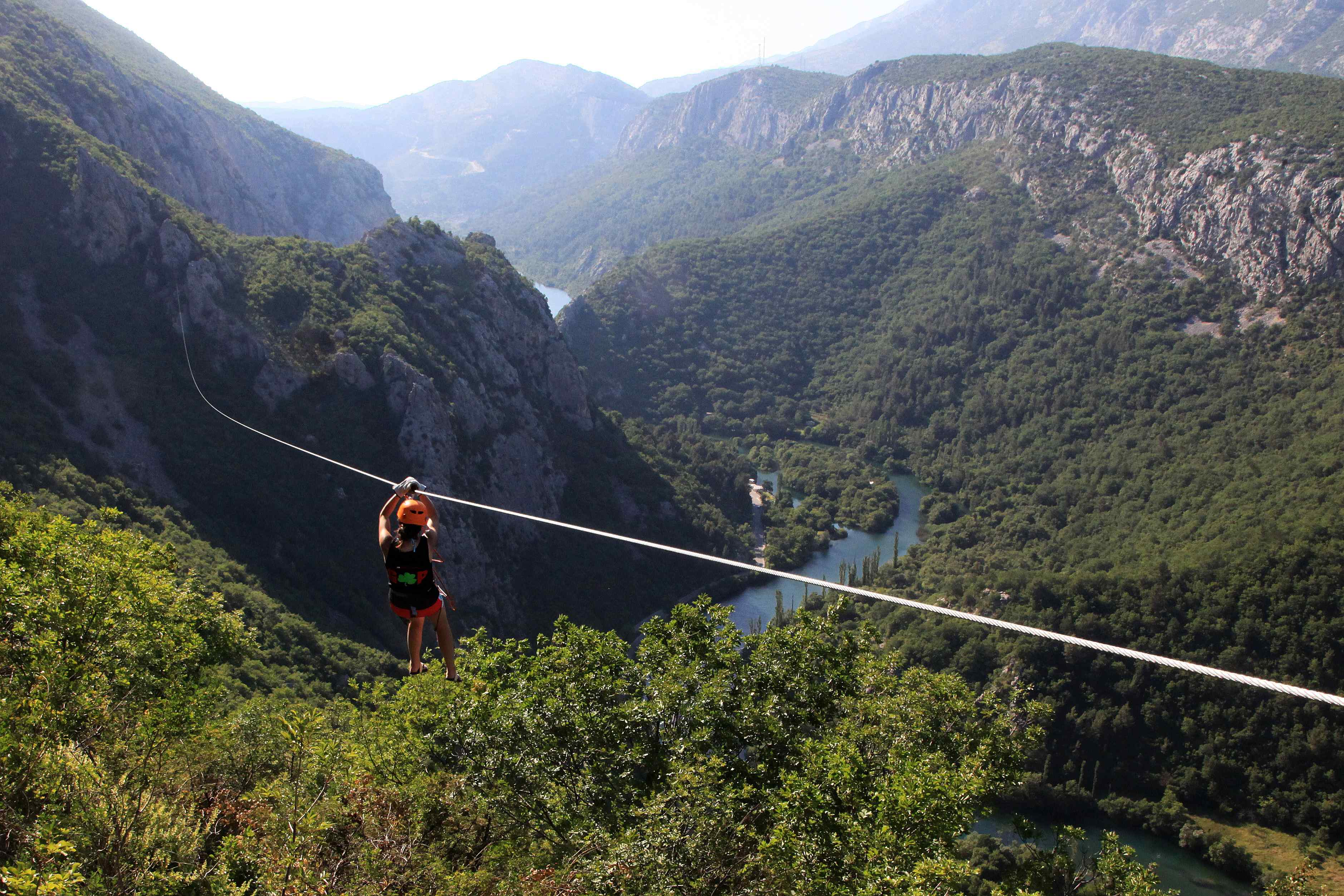 © Zipline Croatia
© Zipline Croatia
Here, away from the shoreline of the town, countless small villages appear on the roads between the river and mountains. Life in these villages looks remarkably like it did a few hundred years ago. The same fruits and vegetables and vines still grow around the traditional houses, many of them ending up on the tables of the fine restaurants you'll dine in when you visit Omis. The same meals are prepared, such as Soparnik, one of Croatia's most authentic dishes – you can only find it in the small region surrounding Omis. The same folk dances are preserved, and the same songs fill the air. You can hear many of them in Omis itself – the city hosts a famous 55-year-old festival of klapa (acapella) music, its singers dressed in traditional clothes, their voices echoing around the stone streets of the Old Town in the same way they have for hundreds of years. The chamber music evenings and one of the most important guitar festivals in the region add to the wonderful entertainment and atmosphere of balmy summer evenings you have when you visit Omis.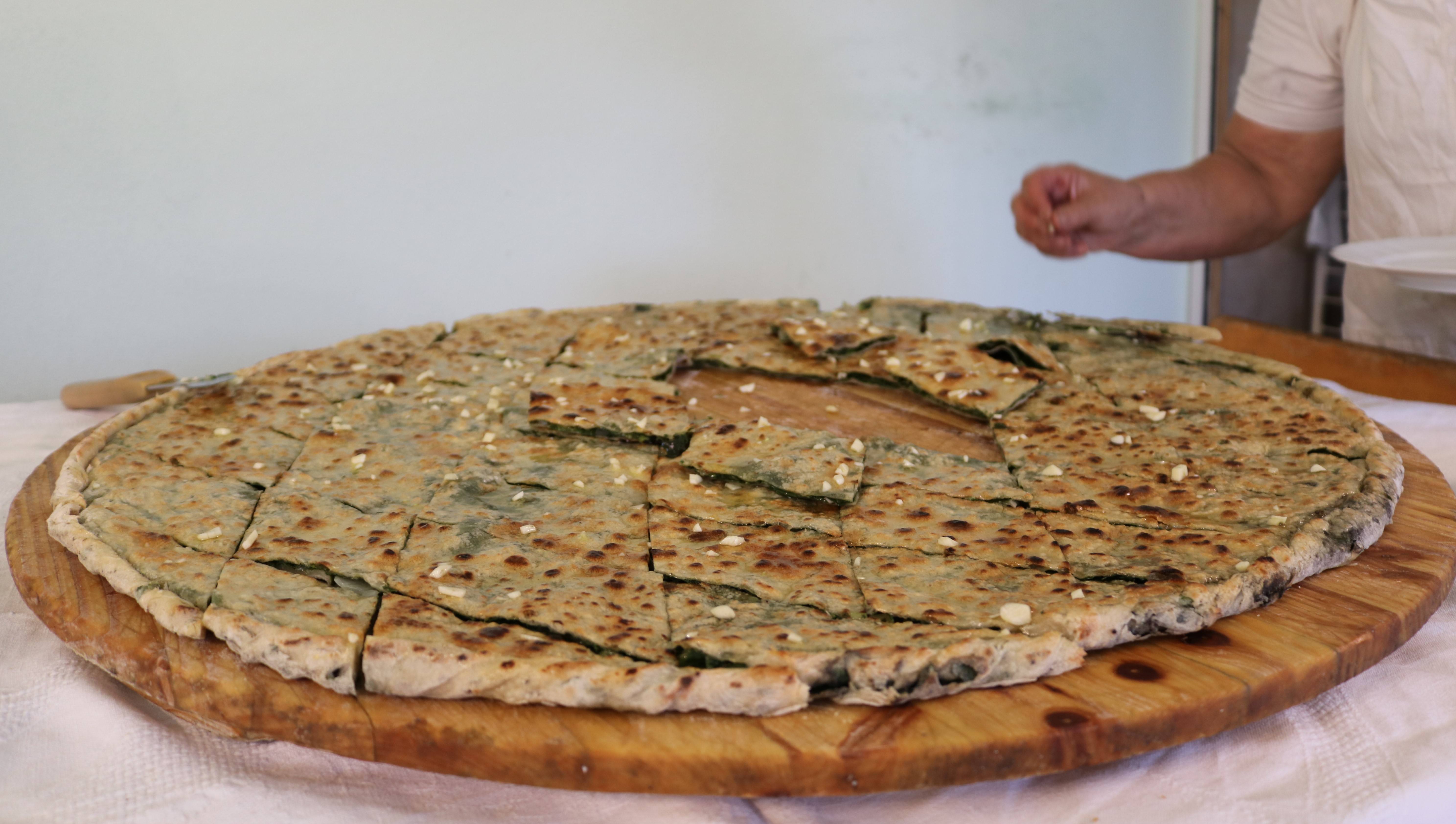 Soparnik, one of the most authentically Croatian foods in the country. It comes from the hinterland behind Omis and it's unlikely you'll find it anywhere else © Marc Rowlands
Soparnik, one of the most authentically Croatian foods in the country. It comes from the hinterland behind Omis and it's unlikely you'll find it anywhere else © Marc Rowlands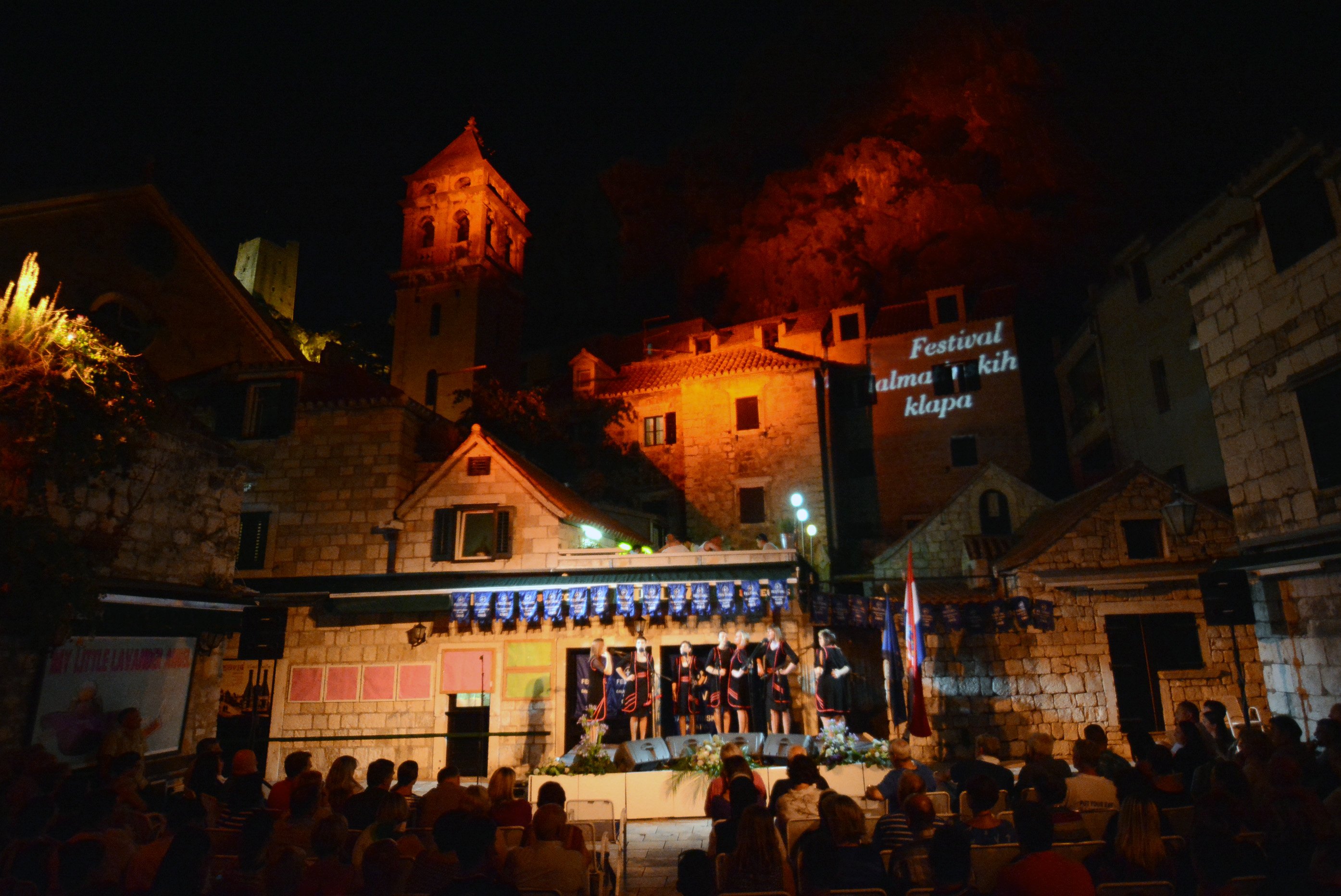 The 55-year-old festival of klapa music in Omis © Omis Tourist Board
The 55-year-old festival of klapa music in Omis © Omis Tourist Board
Of course, no trip to the Adriatic is complete without time spent on the beach and swimming in the sea. And, when you visit Omis, you're in one of the best places anywhere in Croatia to enjoy it. Relatively undiscovered, the Omis riviera has a wide range of options to suit all. Want to stay close to town? Visit Omis city beach – it's right on your doorstep, popular with families and its waters famously clean. It is extremely rare to find a huge sandy beach like this, right in the heart of the city.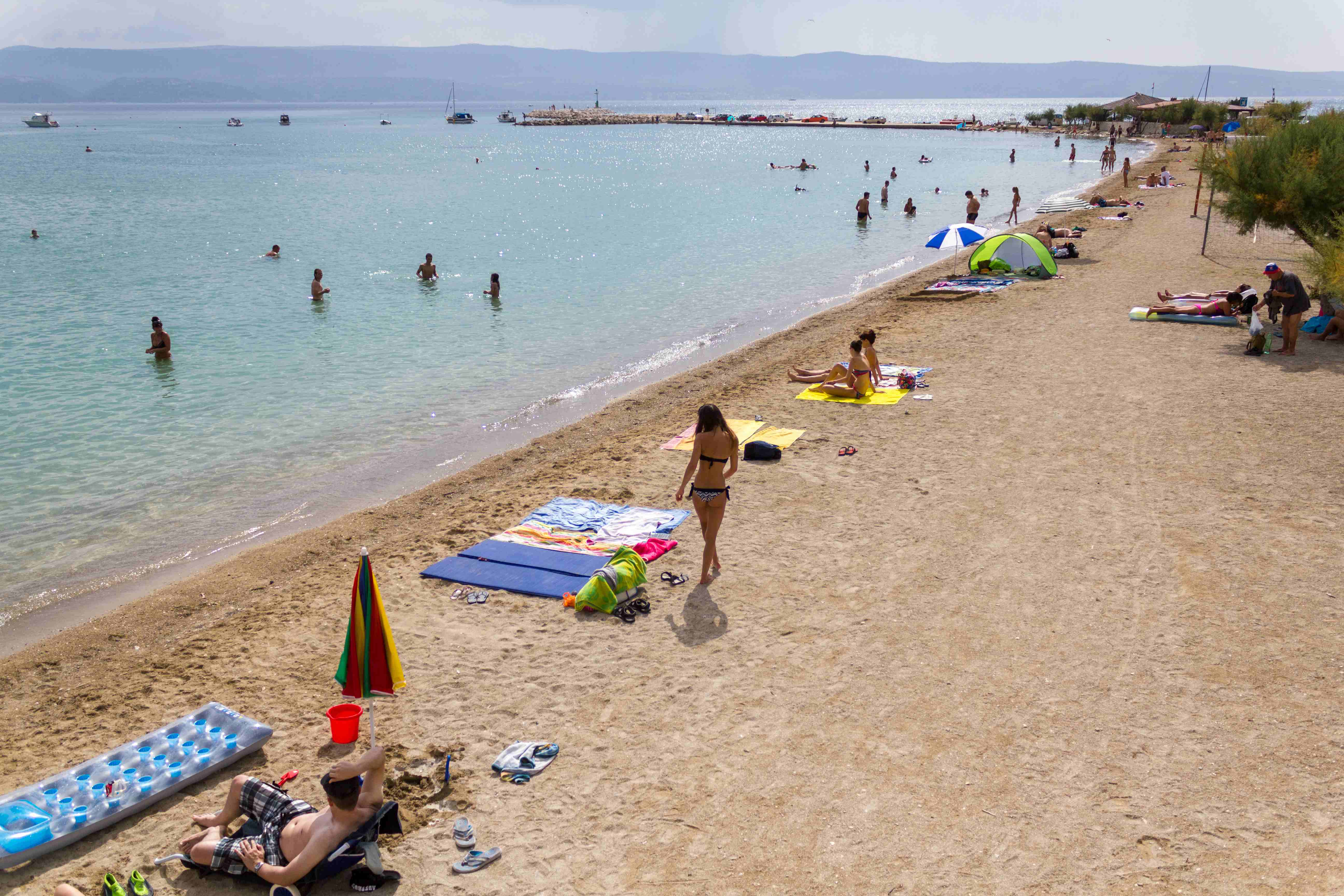 Omis city beach, a huge stretch of sand, moments walk from the centre - there's plenty of room for everyone © Omis Tourist Board
Omis city beach, a huge stretch of sand, moments walk from the centre - there's plenty of room for everyone © Omis Tourist Board
A short ride down the coast offers a 20-kilometre stretch of perfect small-pebble beaches, shaded by scented pine trees, sitting on impossibly clear waters. Pretty hamlets and fishing villages like Nemira, Stanici, Ruskamen, Lokma Rogoznica, Medici, Mimice, Marusici and Pisak allow you to chose between peaceful seclusion, diving and watersports or flavour-packed lunchtime dining in a traditional Dalmatian tavern.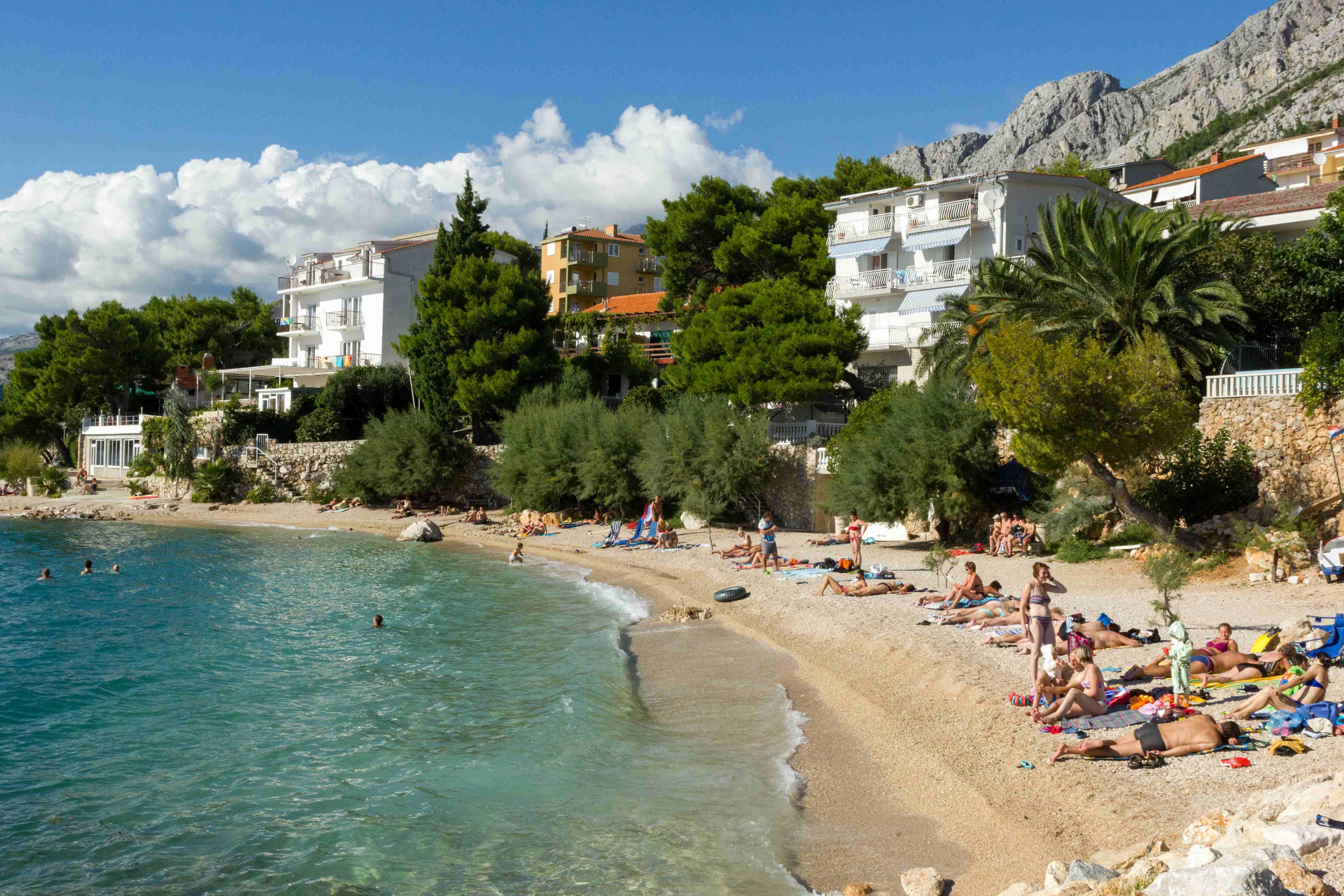 The village of Nemira, one of the countless pristine beaches along the 20 kilometres of the Omis riviera © Omis Tourist Board
The village of Nemira, one of the countless pristine beaches along the 20 kilometres of the Omis riviera © Omis Tourist Board
This winter has long to go. We will be inside for quite some time yet. But, that gives us plenty of time to dream of next summer. Of all the places you think you'd like to be, once the warm days return, the City of Omis and its riviera should be top of the list. Unique in its offer of adventure, nature, culture and heritage, there really is nowhere else like it on the whole of the Adriatic.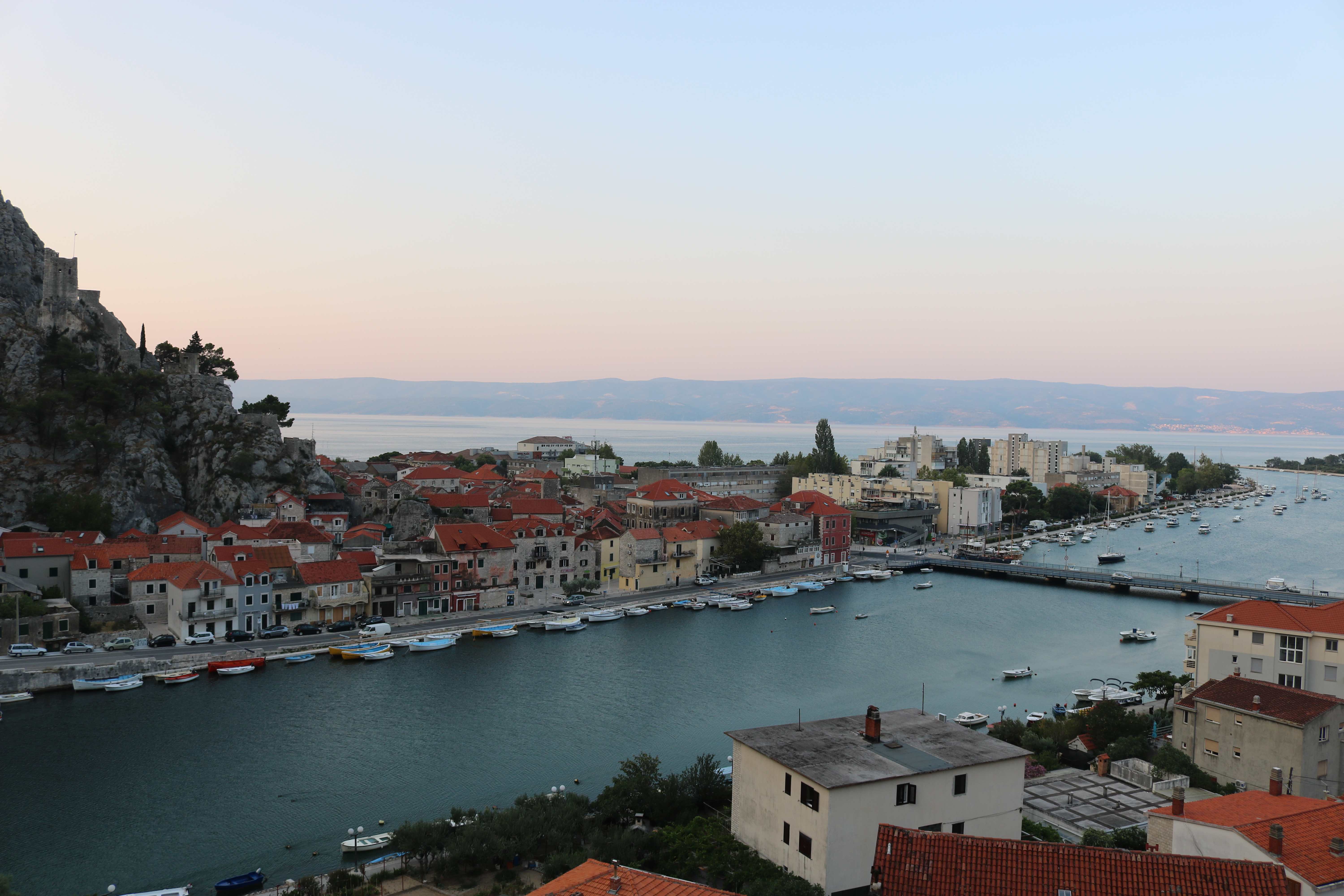 Daybreak over Omis, as seen from the restaurant balcony of Hotel Villa Dvor. The hotel's restaurant is the best place to take coffee in town, the view is spectacular © Marc Rowlands
Daybreak over Omis, as seen from the restaurant balcony of Hotel Villa Dvor. The hotel's restaurant is the best place to take coffee in town, the view is spectacular © Marc Rowlands
This article was written by TCN journalists based on first-hand experience of visiting Omis and was subsequently approved by Omis Tourist Board
Zlatko Dalic Calls Up Osijek Stopper for Portugal and More Croatia News Ahead of Poljud
November 16, 2020 - Croatia and Portugal meet in Split on Tuesday for their final Nations League match this season. A look at the latest Croatia news ahead of Poljud.
After losing 2:1 to Sweden on Saturday evening in Solna, the Croatia national team traveled to Split, after which they held their first training in Omis on Sunday. The training included Dejan Lovren, who joined the Croatia squad in Stockholm after his yellow card suspension.
The Croatia players that recorded the most minutes against Sweden (Modrić, Vlašić, Perišić, Livaković, Kovačić, Brekalo, Barišić, Ćaleta-Car, Pongračić) took part in a regeneration training at the hotel. Uremović is currently out of the lineup after an injury he sustained during the Sweden match.
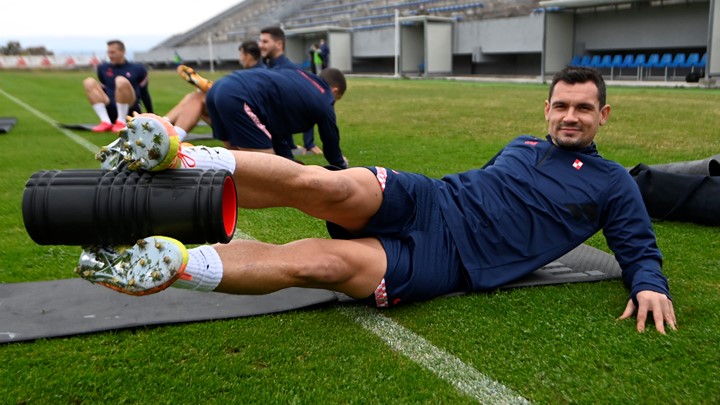
HNS
Although training in Omis was held without the presence of spectators due to the coronavirus pandemic, locals hung a large jersey with the last name of their fellow citizen, Ivan Perišić, and did their best to ensure that Croatia had everything they needed in the small coastal town.
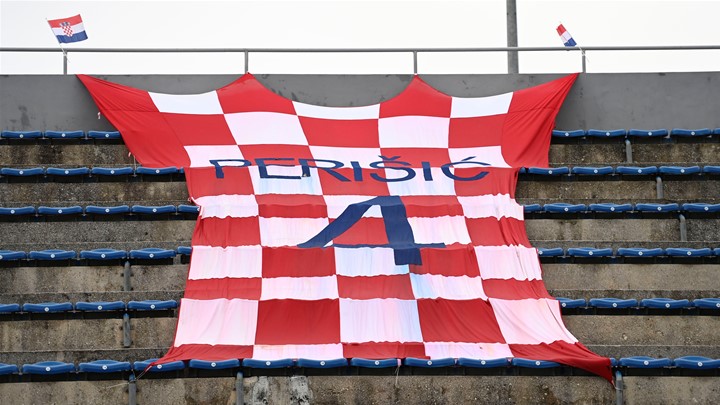
HNS
On Sunday evening, the Croatia national team medical service received the team's latest COVID-19 test results. Croatia was tested after arriving from Stockholm to Split, before the match against Portugal.
After a week of worrying results, we finally have some good news, as all members of the national team and members of the national team staff are negative for the SARS-CoV-2 virus. Coach Zlatko Dalić can count on all remaining players in the national team.
Recall, Domagoj Vida tested positive in Istanbul on Wednesday, and Marcelo Brozović tested positive in Stockholm on Friday. In compliance with the epidemiological rules and UEFA's Return to Play protocol, the Turkish and Swedish epidemiological services decided that the isolation of other national team members was not necessary.
But even though everyone corona-free, Dalić still struggled to fill certain positions in the defense ahead of the crucial Portugal meeting on Tuesday. He has thus decided to call-up Osijek stopper Milo Škorić in the absence of Duja Ćaleta-Car (yellow cards) and Filip Uremović (injury).
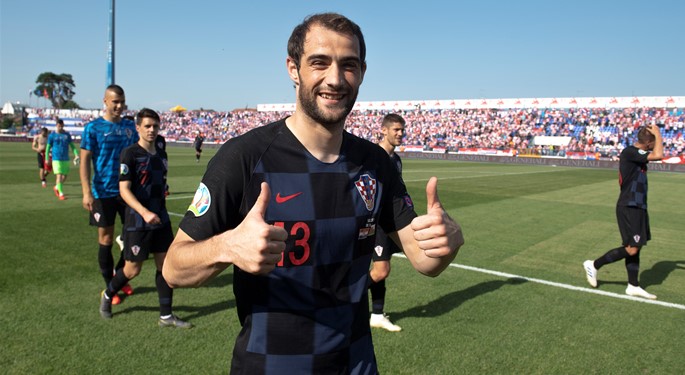
HNS
The Osijek captain will join Croatia during the day on Monday and is expected to play against Portugal in Split on Tuesday.
Škorić has three appearances for the Croatia national team, and interestingly, in all three Škorić appearances, Croatia won 2:1 (Mexico, Wales, and Georgia).
Source: HNS
To read more about sport in Croatia, follow TCN's dedicated page.
Future Omis Fast Road One Step Closer to Becoming Reality
October 21, 2020 - To the relief of citizens in Split and its surroundings, we are one step closer to constructing the highly anticipated Omis fast road.
The tender for the TTTS-Dugi Rati road, which lasted an incredible 19 months, has finally been completed. There is no need to emphasize just how much the construction of this road would mean for Omis and the whole of central Dalmatia. Its discussion has gone on for decades.
Although no one knows when the fast road from Split to Omis will be built, things have at least began moving in the right direction. There is a bit more certainty about the construction of the Omis bypass, with the construction of which will transfer part of the traffic jams from the highway to the Omis hinterland. The new tunnel and the bridge over the Cetina should relieve at least part of the traffic so that from Omis to Split, it is possible to bypass through Tugar, Srinjine, and Žrnovnica.
After the tender, Croatian Roads (Hrvatske ceste) commented extensively for Dalmacija Danas. They explained the tender's details and the planned route that will have to pass over the slopes of the Perun hill, so it will consist of numerous viaducts and bridges.
“Preparation of changes to the preliminary and main project documentation, implementation of geodetic and geotechnical works and obtaining a location and construction permit for the section TTTS - Dugi Rat with connecting roads was contracted with the Association of Business Entities Geoprojekt dd, Split, Mobilita Evolva doo, Zagreb, Radionica mostova doo, Samobor, Faculty of Civil Engineering, Architecture and Geodesy Split, ZG-Projekt doo, Zagreb. The value of the contract is HRK 10,490,000.00 without VAT, with a deadline for the preparation of project documentation lasting 12 months from the date of signing the contract. The length of the section that is the subject of the contract is 13 km.
The need for the intervention that is the subject of this contract stems from the fact that the existing state road DC8 from Stobrec to Omis is the only road connection between the southern coastal settlements and the city of Omis with Split as the main center of Split-Dalmatia County. Along the entire stretch of the future road, the existing state road is located close to the sea and passes through the settlements of Stobreč, Grljevac, Sv. Martin, Krilo, Sumpetar, Dugi Rat, and Omis.
The existing road is burdened with numerous level crossings that are mostly irregular in geometry and without additional lanes for left and right turns. The floor plan elements are uneven, visibility is insufficient, and there are strong intercity and suburban public bus traffic on the road without bus stops and footpaths. The course of transit and local traffic and their collision, especially in peak loads and during the tourist season, lead to major delays.
All of the above causes low throughput and endangers traffic safety, and prevents urban and tourist development of the settlement.
Considering the construction (residential and commercial buildings) of the narrower belt of the road, it is not possible to realize the necessary reconstruction works, and there is a need to build a road in the new corridor.
The necessity of this project is also visible from the analysis of existing traffic flows in the coverage area of the project based on available data on traffic loads according to the publication "Counting road traffic in the Republic of Croatia in 2015" published by Hrvatske ceste d.o.o. Zagreb.
The road construction, which will be located in the edge zone of the coast, east of the existing DC8, would enable the smooth development of settlements and further development of tourism, and transit traffic would no longer pass through the settlements.
The project was designed as a fast road in the part of the TTTS-Dugi Rat junction with two separate roads and the Dugi Rat-Omiš junction with one road. A building permit was obtained and consumed for the TTTS-Grljevac subsection.
However, due to the high costs of construction of these roads, the investor in 2015 ordered a proposal to optimize the project while maintaining the existing road corridor. The changes relate to the horizontal and vertical geometry to avoid larger cuts in the terrain and the associated costs of securing the slope. Between the two tunnels, the separation of the separated axes was performed, and the denivelation of the same. The optimization shortened the route with four lanes, and now only the first approximately 8100 m is planned as a four-lane road, while the rest of the route is planned as a two-lane road.
Regarding the description of the project itself, the expressway route starts at the junction "TTTS" and continues to the previous section as a four-lane road whose roads are separated by a green belt. The expressway route crosses the roundabout with an overpass “TTTS” approximately 235 m long and is connected to the roundabout via the northern and southern ramps of the junction. Further to the east, there is the bridge "Žrnovnica" (L = approx. 540 m), which in addition to the river Žrnovnica leads over the county road ŽC6142 and the densely built part of Podstrana.
After the completion of the bridge, the left and right pavements are separated and leveled and pass through the tunnels “Perun” (Ls = approx. 200 m, Lj = approx. 220 m) and “Rudine” (Ls = approx. 365 m, Lj = approx. 360 m). After the tunnel, the left and right pavements approach and continue to the viaduct “Duge njive” (L = approx. 90 m). The route continues southeast towards the junction "Stara Podstrana" at km about 5 + 200, connecting with the state road DC8.
The “Stara Podstrana” node is connected to DC8 via axis 10, axis 16, and axis 17. Axis 18 represents the reconstructed DC8 at the part of the intersection. Via axis 14, the “Stara Podstrana” junction connects with the county road ŽC6162, which is located east of the junction, and ŽC6162 itself is proposed via axis 15 and crosses the expressway with the overpass “Drinovac” (at km approx. 6 + 340).
The “Jesenice” junction is located further to the southeast at km 8 + 100 and connects the expressway with the state road DC8 in the south and the local road LC67112 in the north. These two roads are connected with a new road (axis 20), which connects to DC8 near the future "Krilo" port.
There is a three-lane tunnel "Krilo" (L = approx. 170 m) on this connecting road, which passes through the hill near the state road. The three-lane tunnel contains, in addition to two lanes, an additional lane for slow-moving vehicles on the rise.
The expressway to the “Krilo Jesenice” junction is run as a four-lane road, and after fitting the junction ramps of km 8 + 1000 to the end of the route, it is run as a two-lane road. Further to the southeast, at km 10 + 340, the “Jesenice” overpass leads above the proposed local road LC67112 (axis 29). The route then descends in height and, at the same time, approaches the coast and settlements in terms of the floor plan, and reaches the junction “Dugi Rat” at approx. km 13 + 860.
Here we would like to emphasize that for the previous section Mravice - TTTS junction (2.5 km long), the procurement of works for the first three phases (Mravince junction with access roads) has already started. In contrast, for the remaining part, the procurement of works will be launched in the second half of 2021. The total estimated value of the said project is approximately HRK 250,000,000.00 without VAT.
Completion of all these works will significantly improve the traffic picture of Split-Dalmatia County in terms of increasing safety and traffic flow and greatly relieve the road network on the stretch from the entrance to the city of Split, through these settlements through which the state road D8 and ultimately of the town of Omis.
It is planned to apply for EU funds for all projeects," answers Croatian Roads.
For the latest travel info, bookmark our main travel info article, which is updated daily.
Read the Croatian Travel Update in your language - now available in 24 languages.
Join the Total Croatia Travel INFO Viber community.


